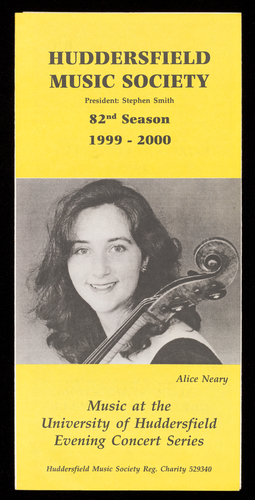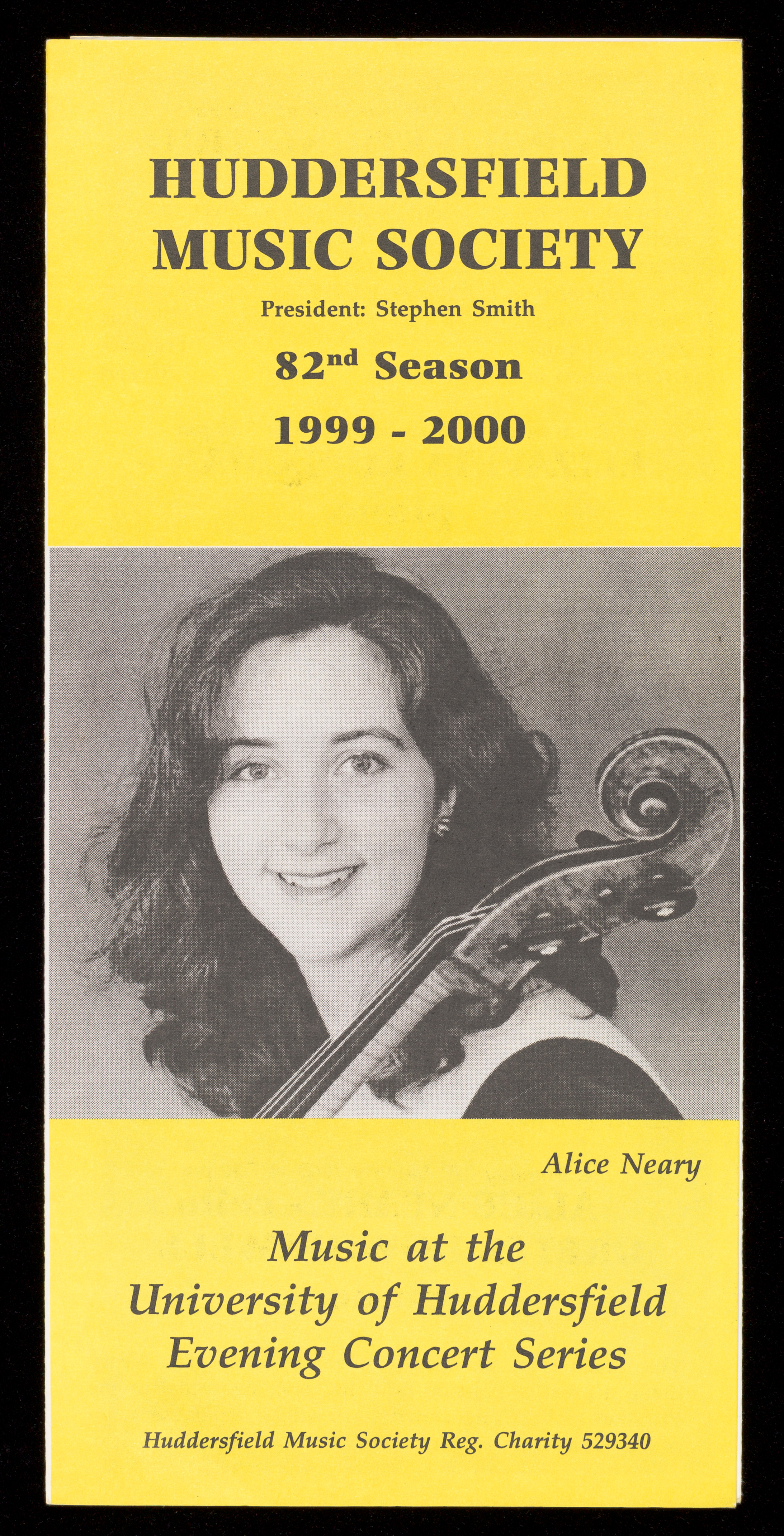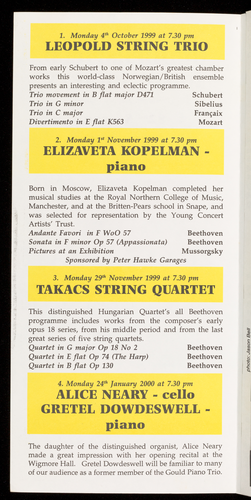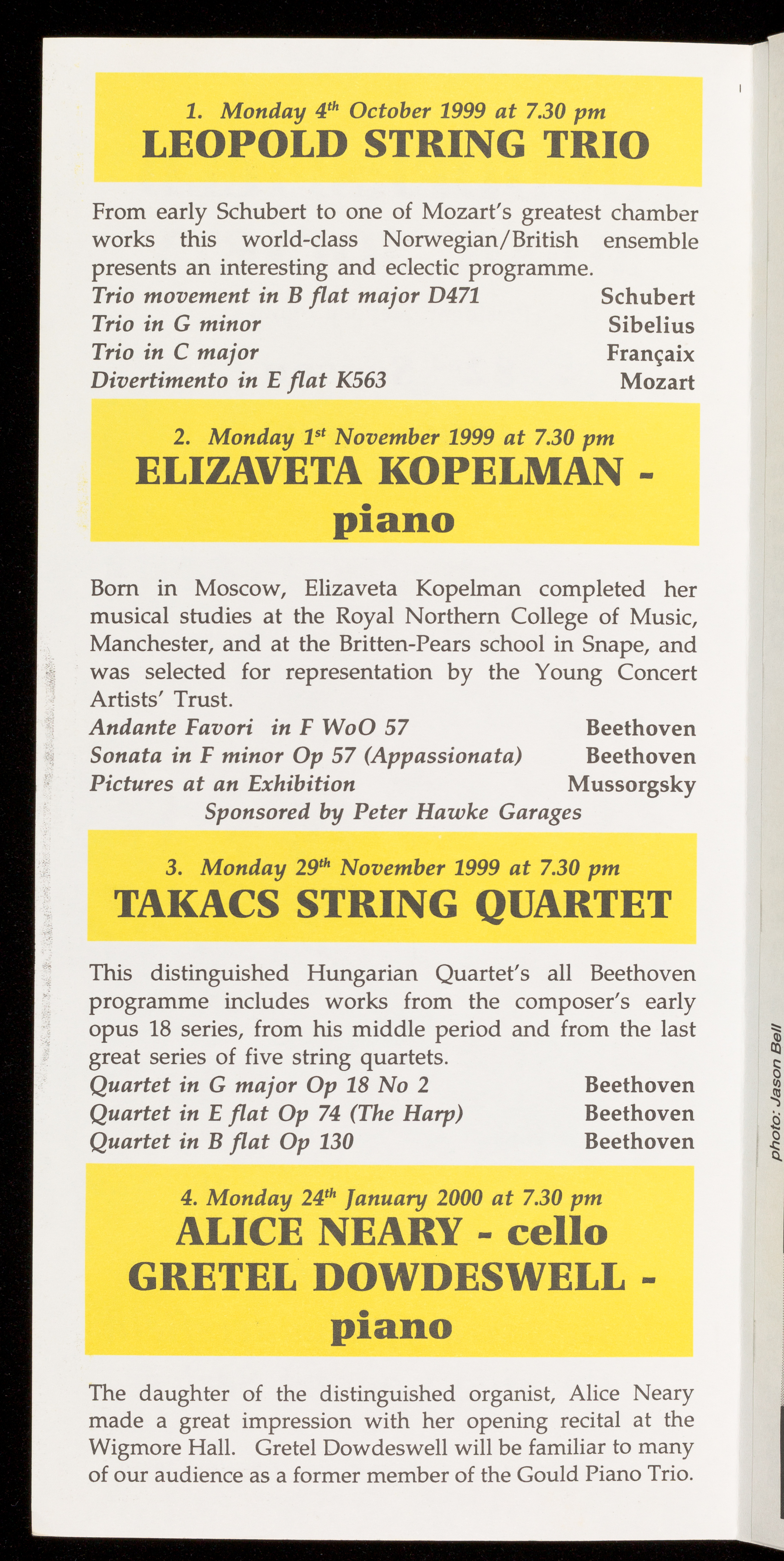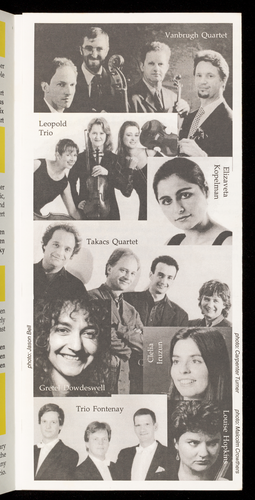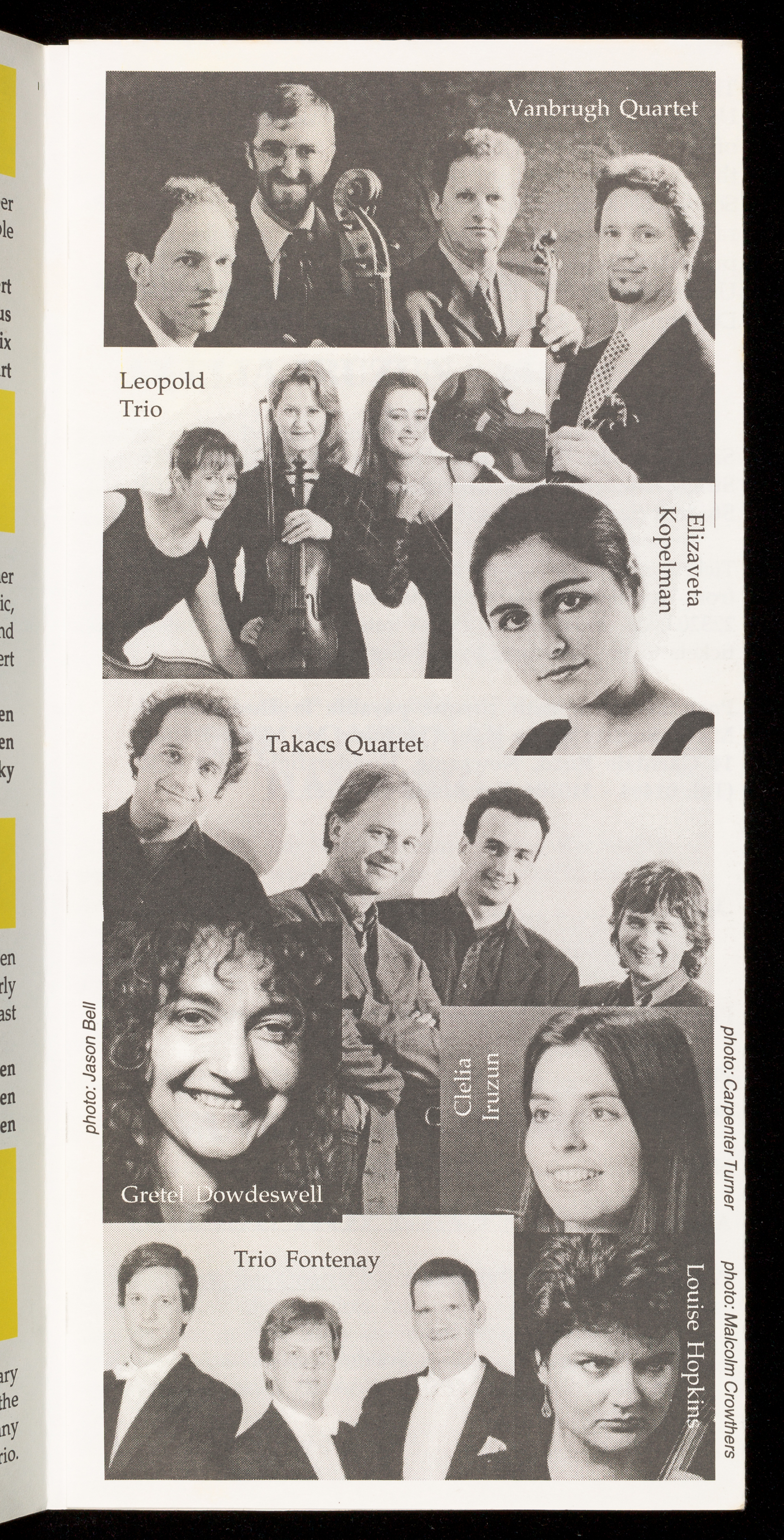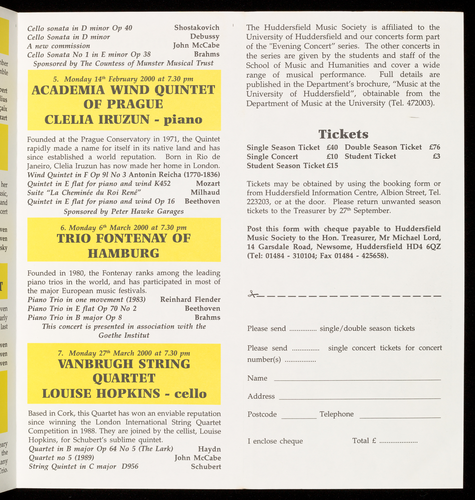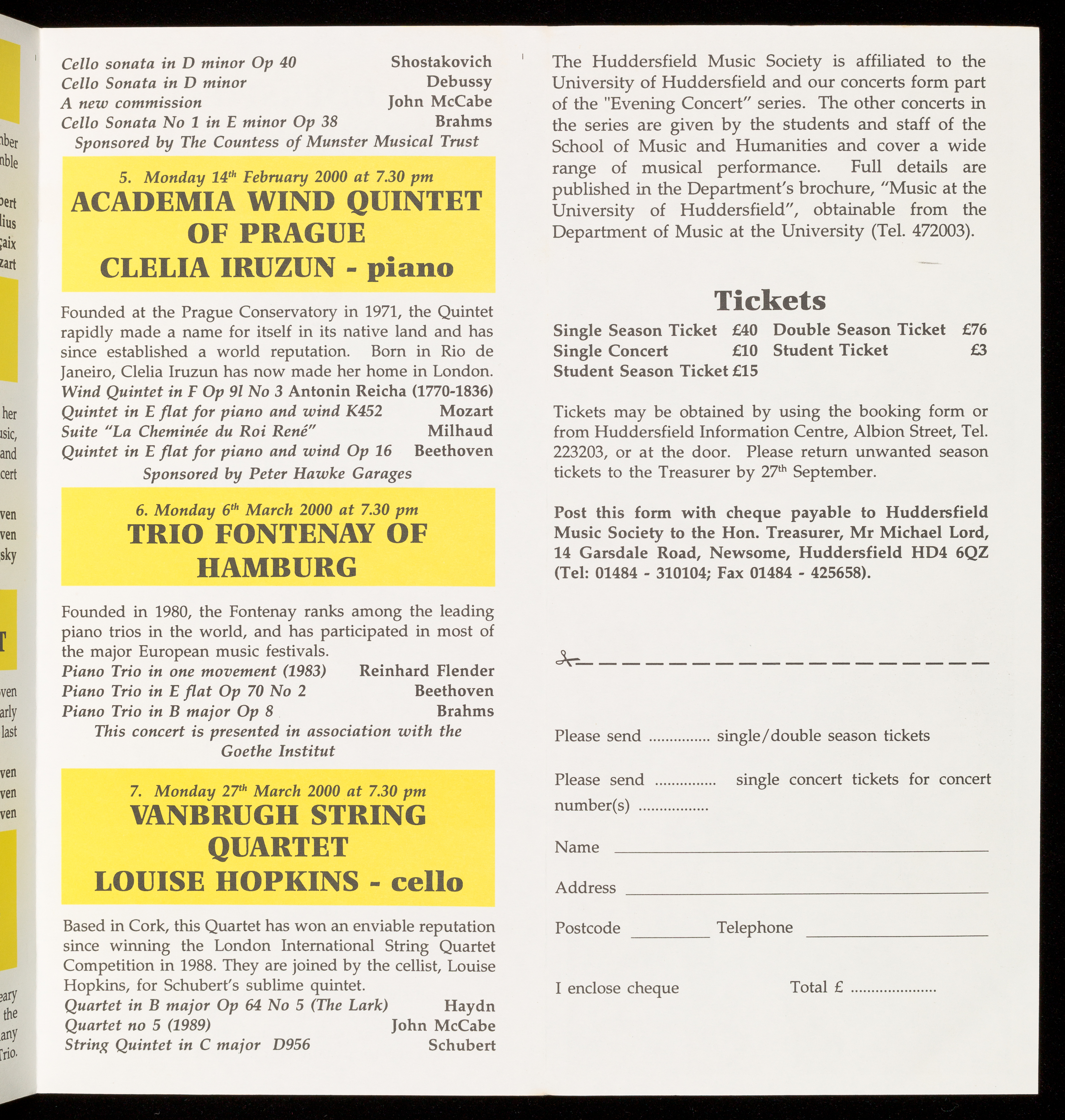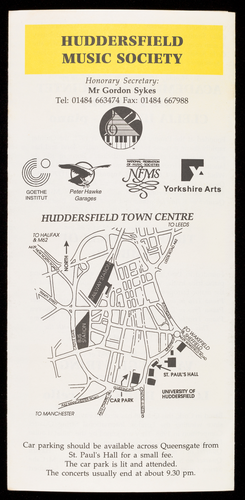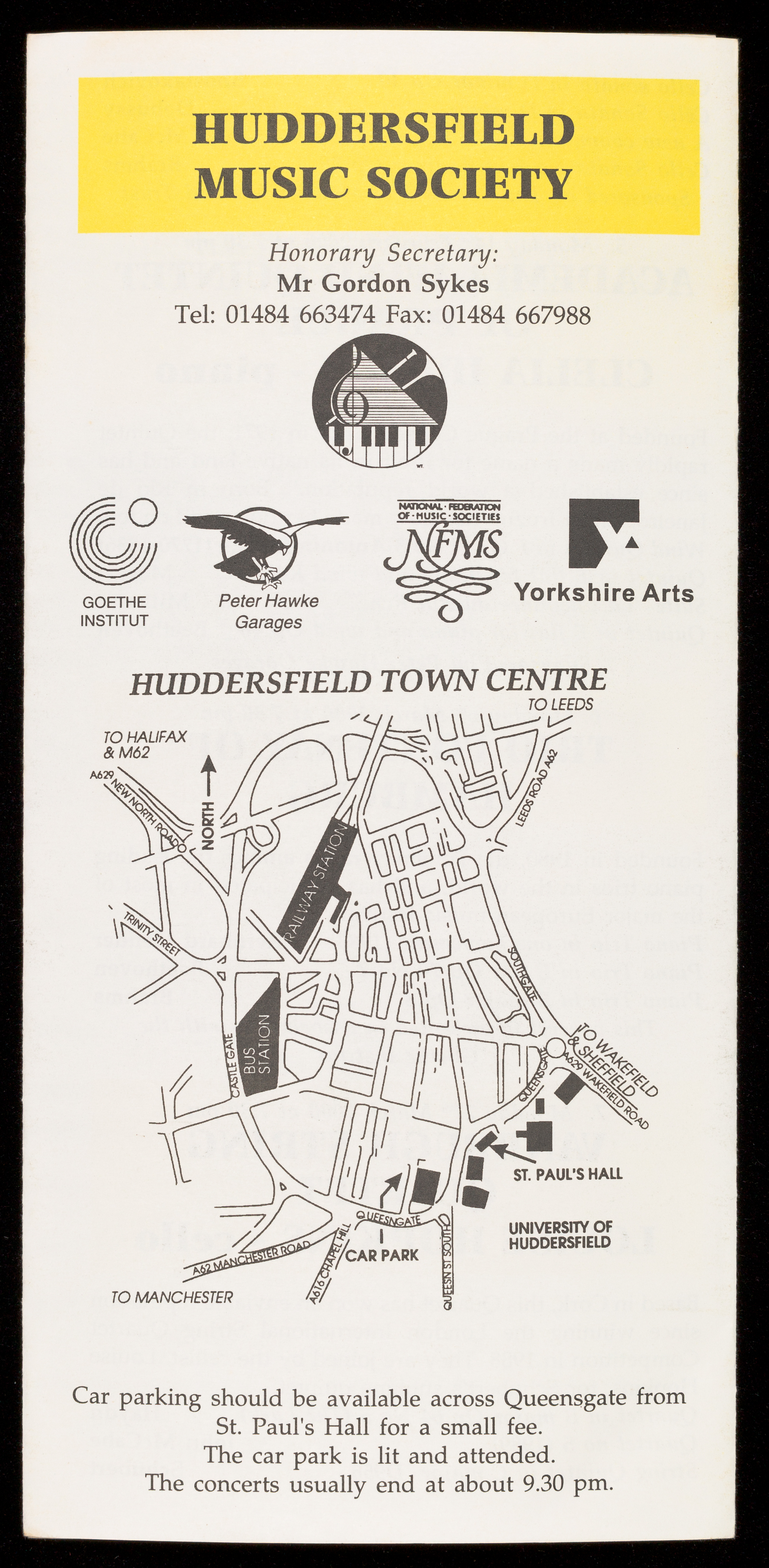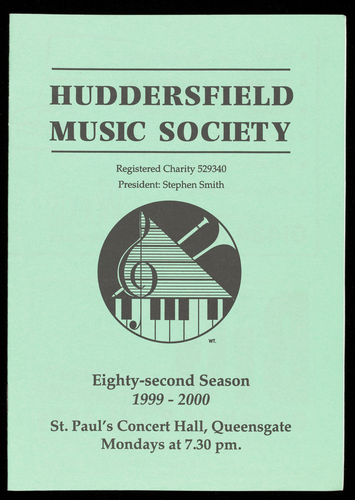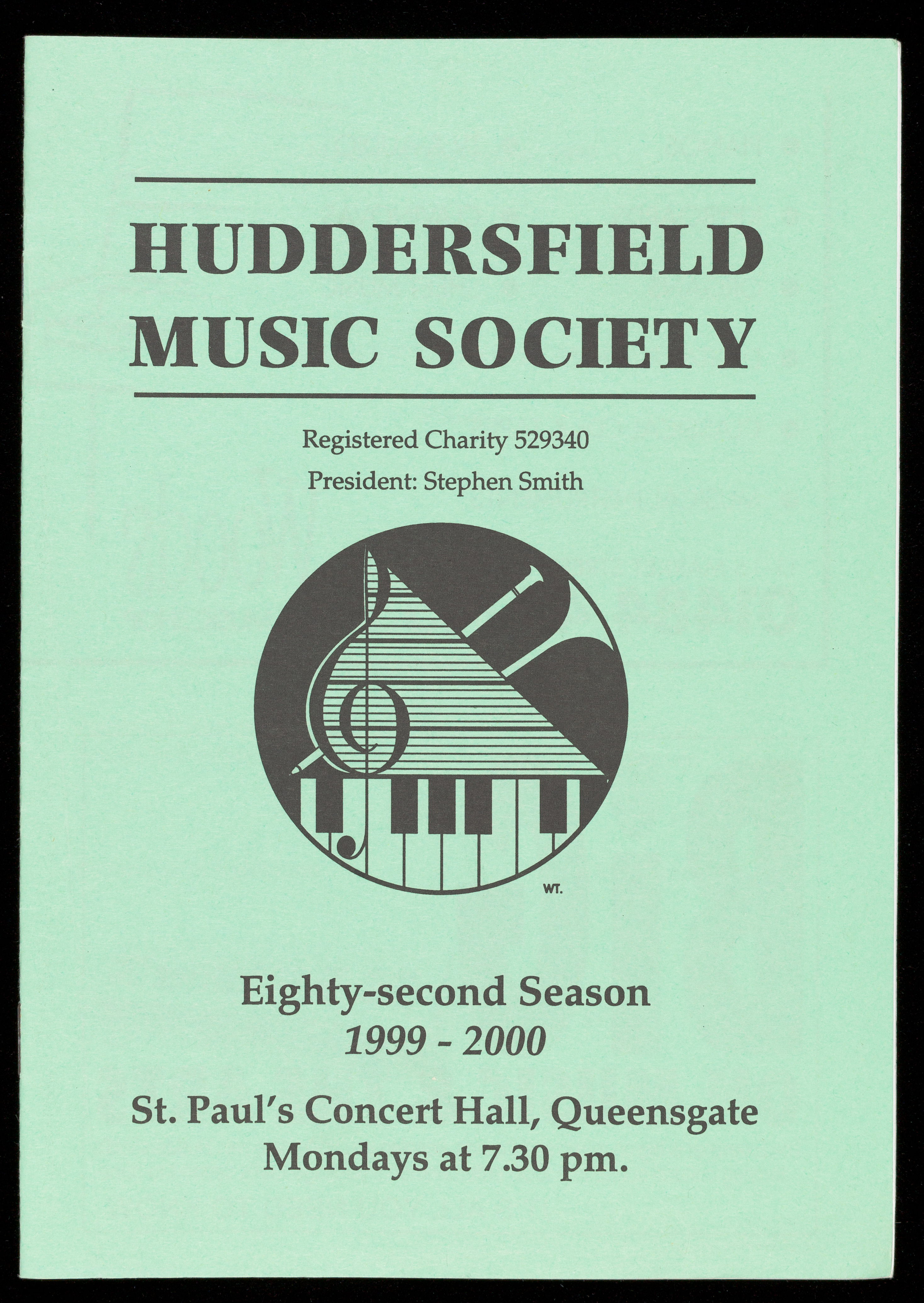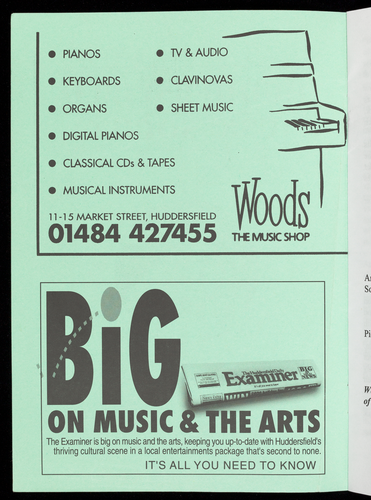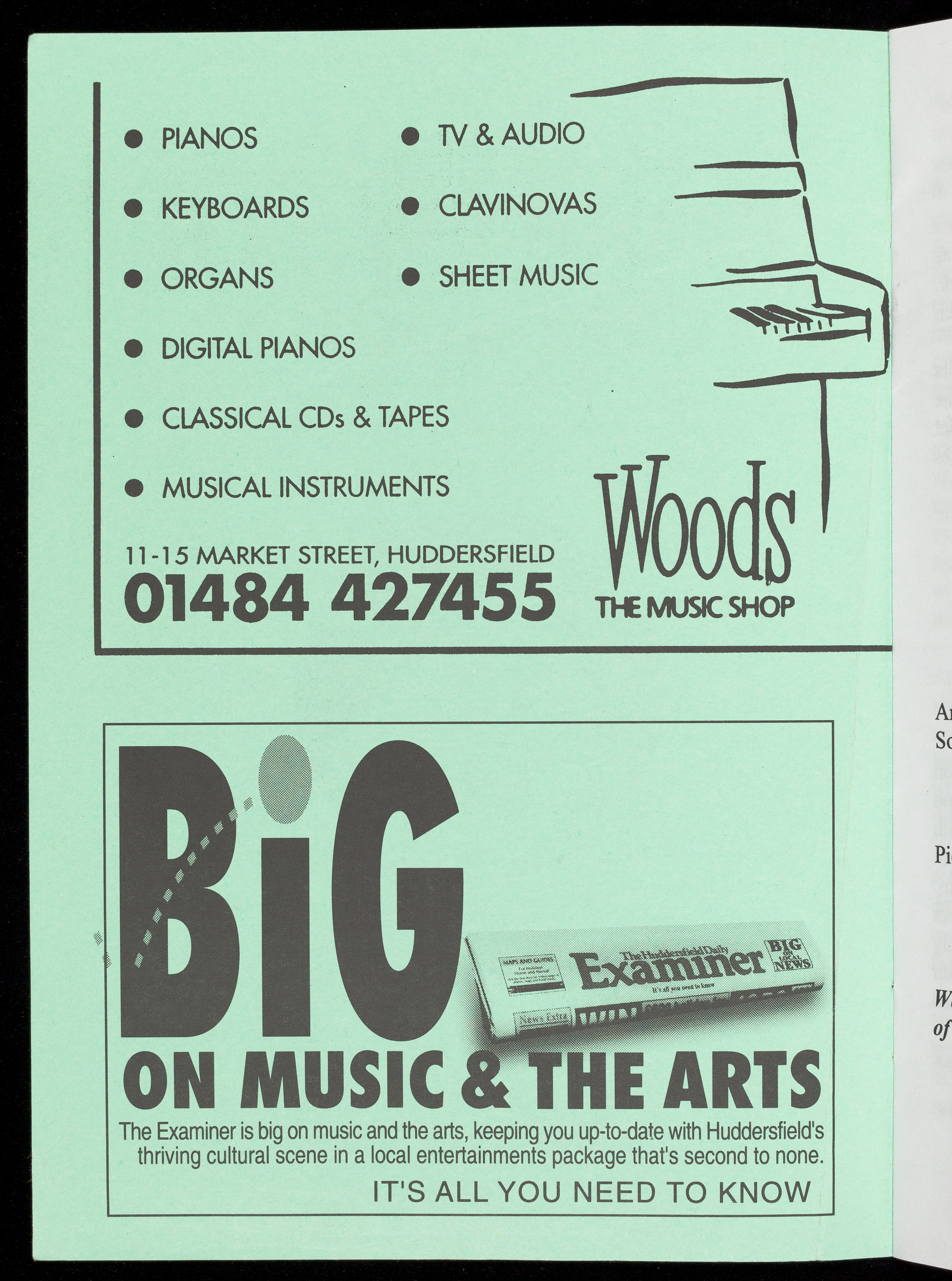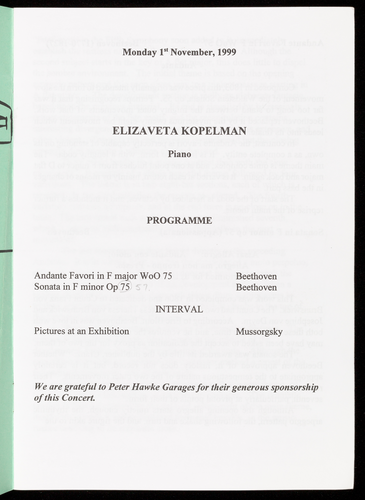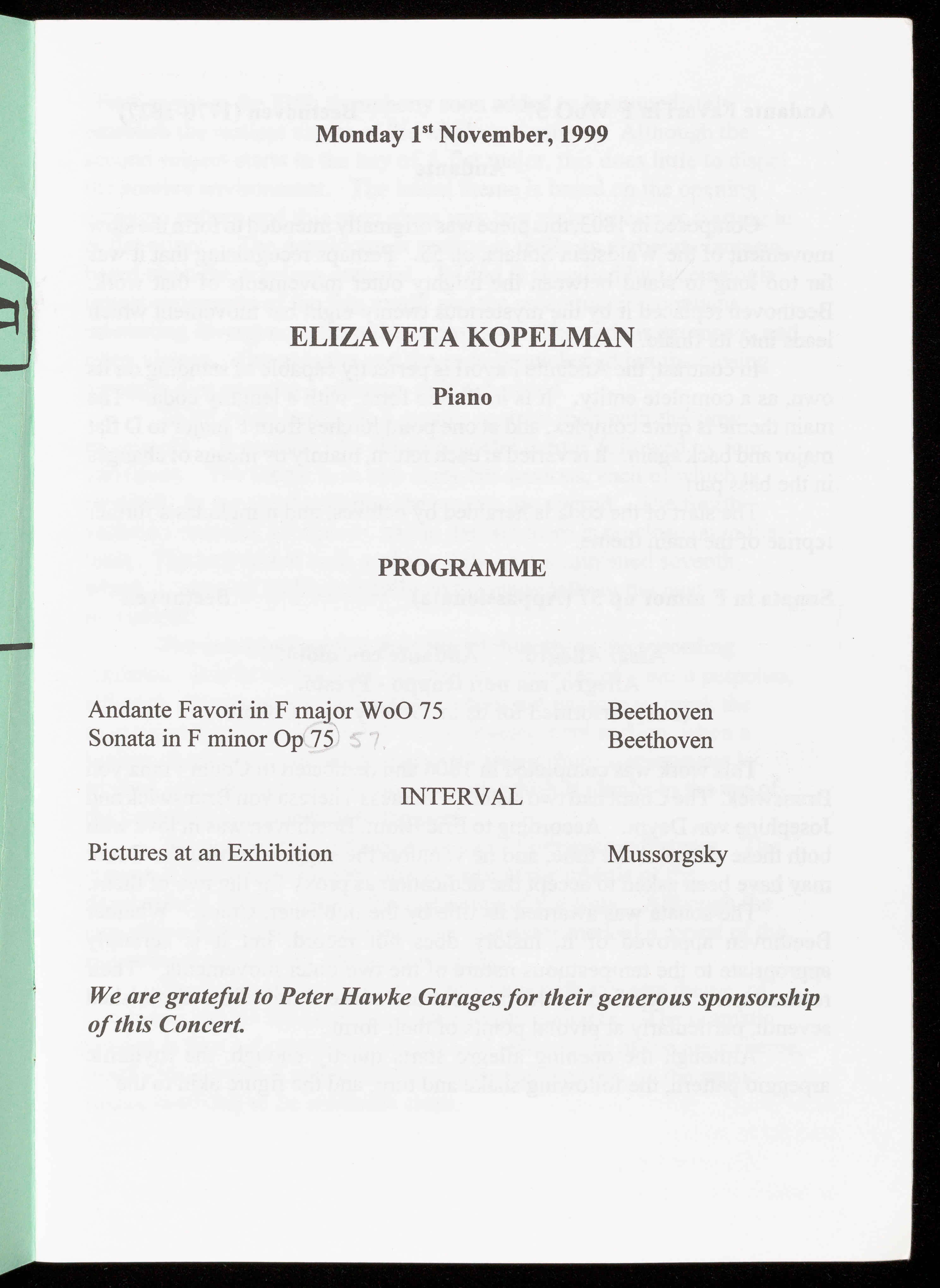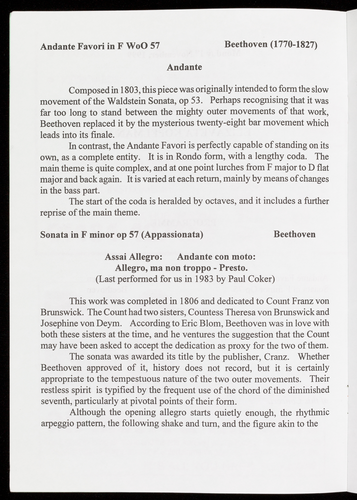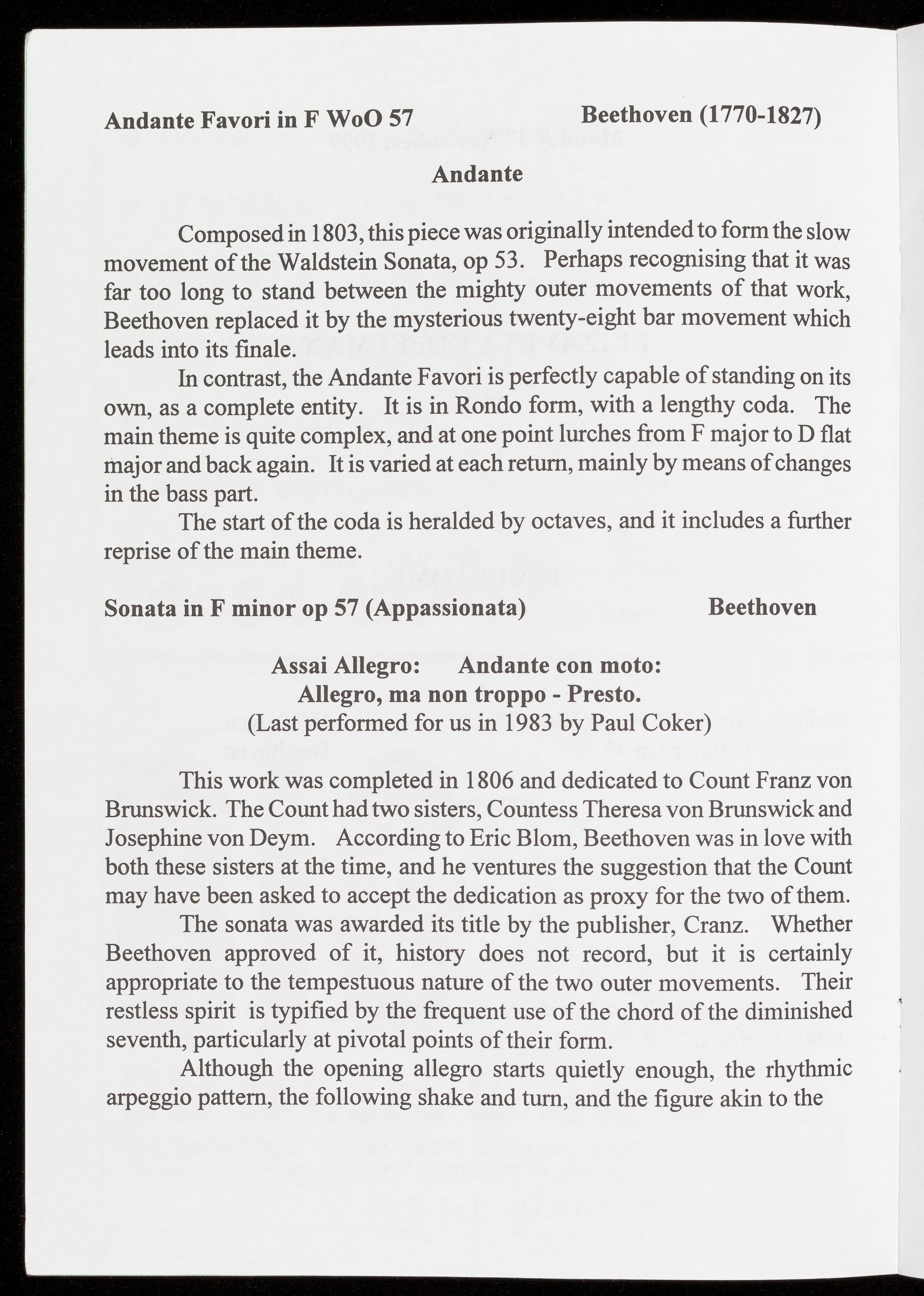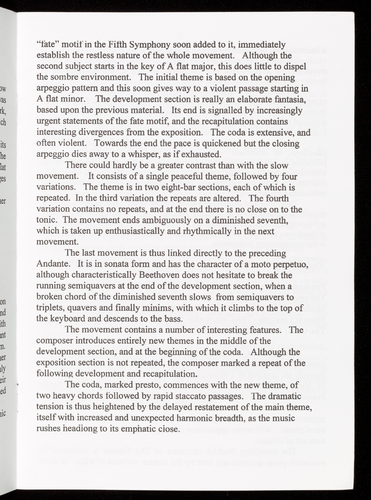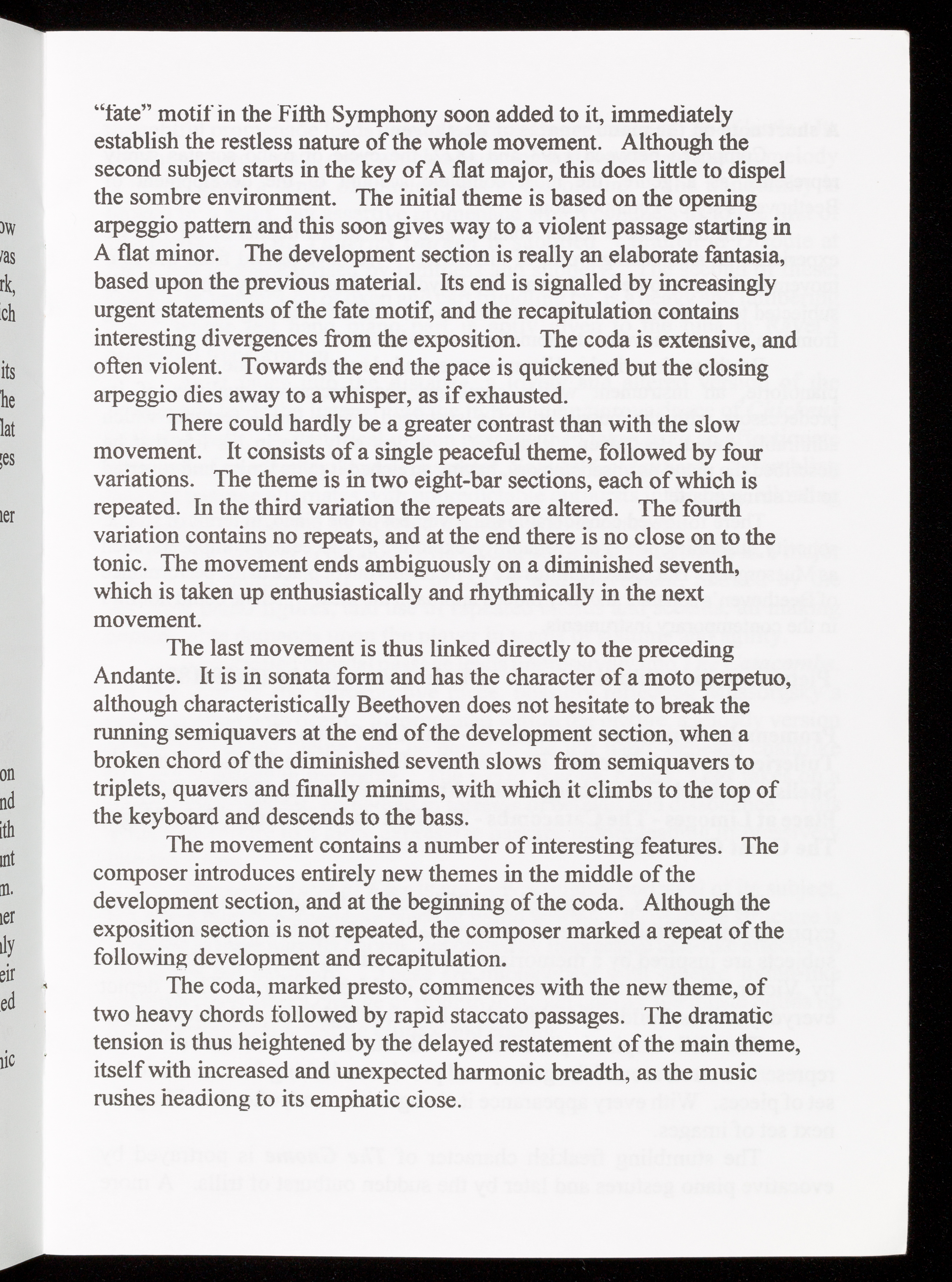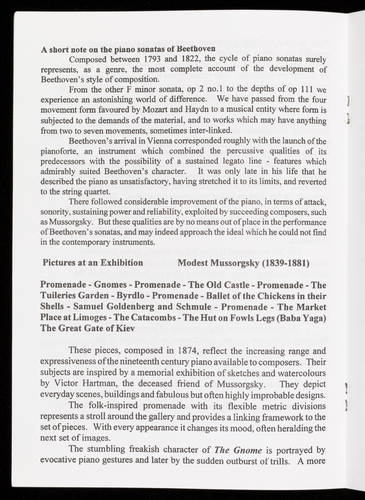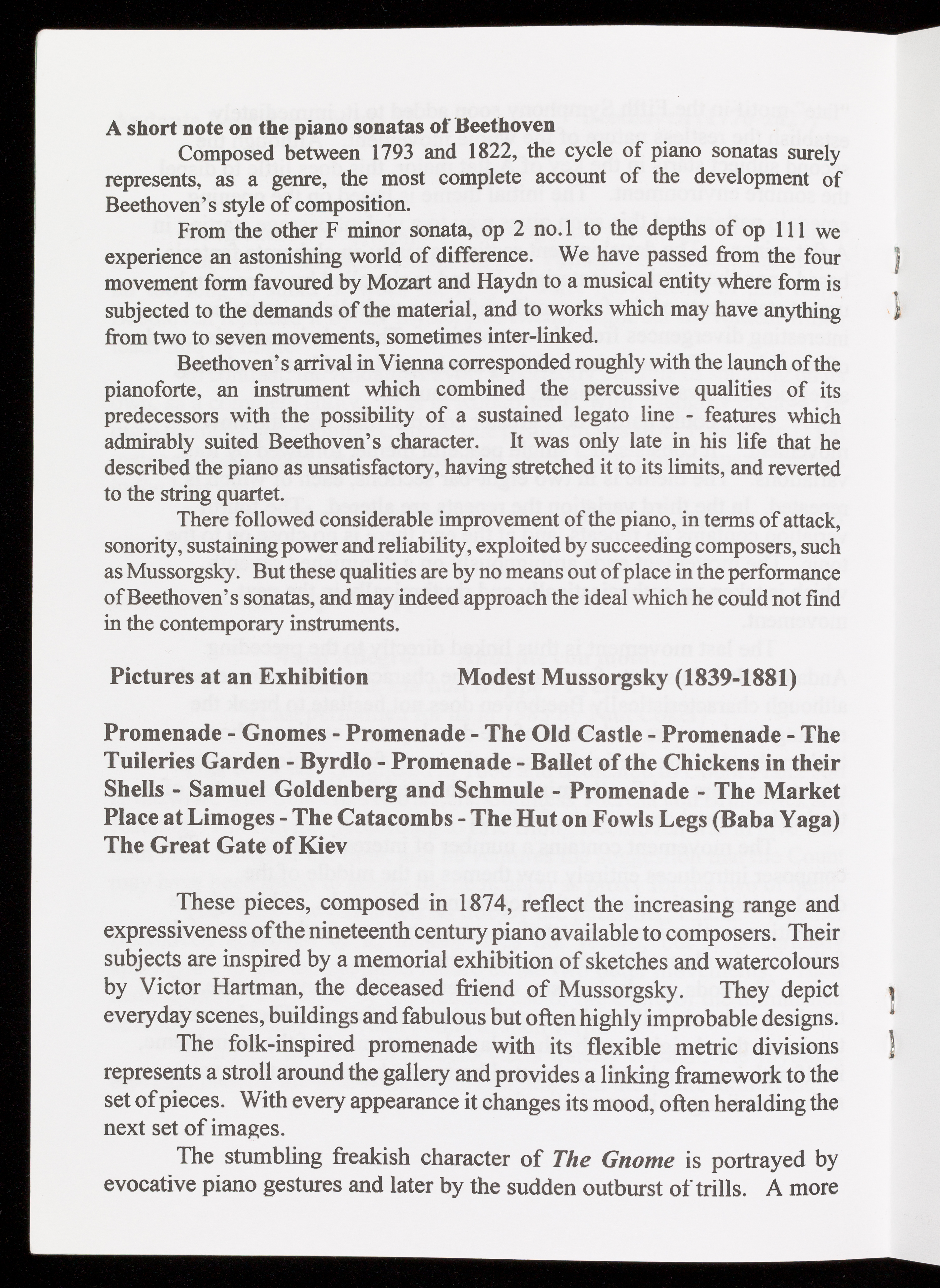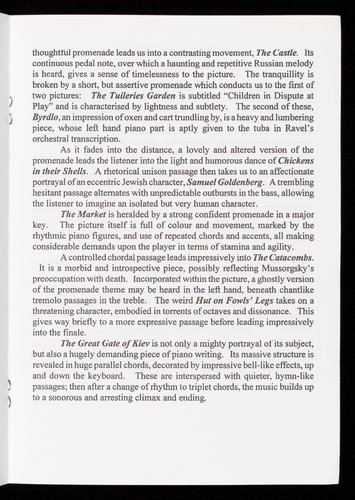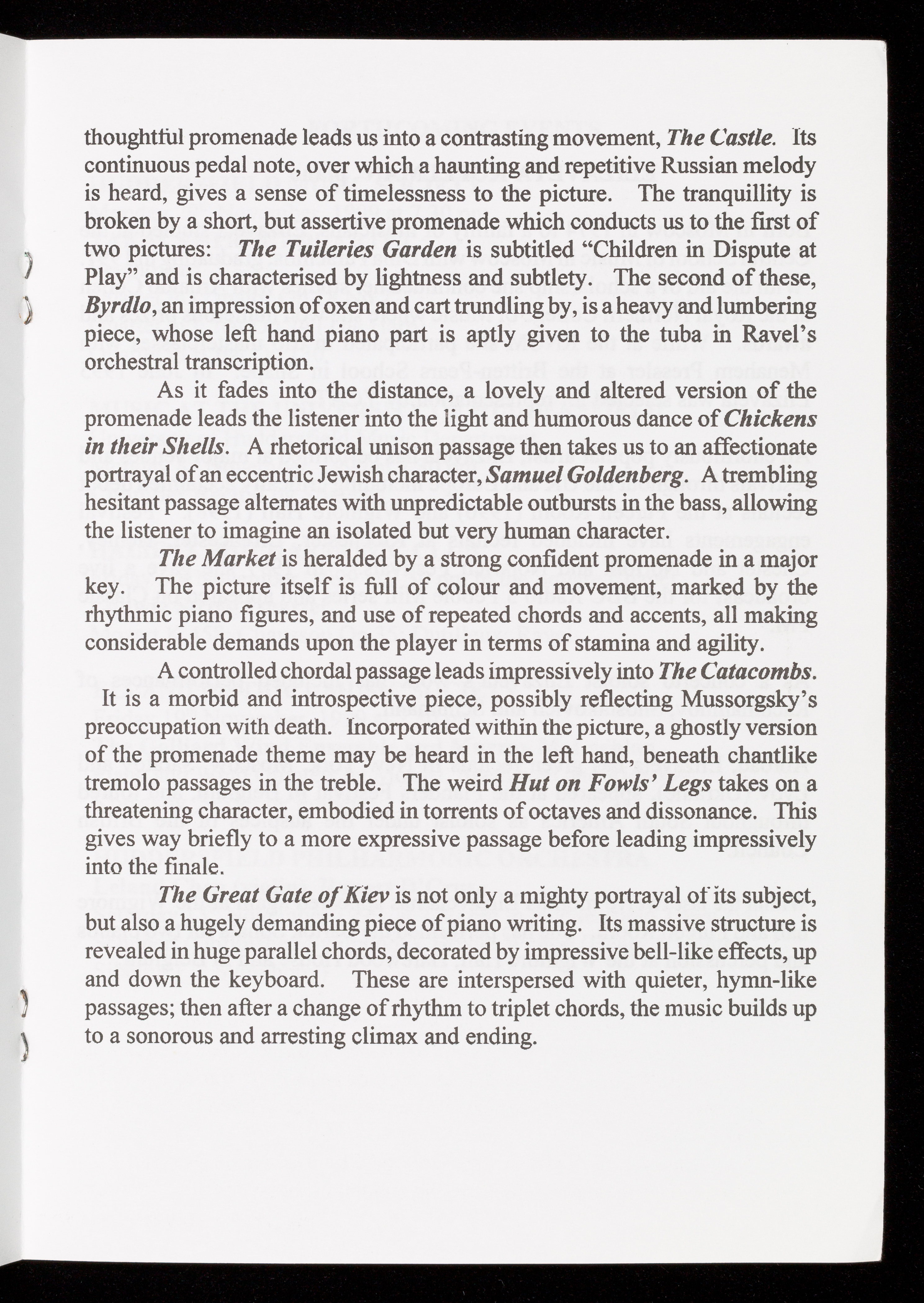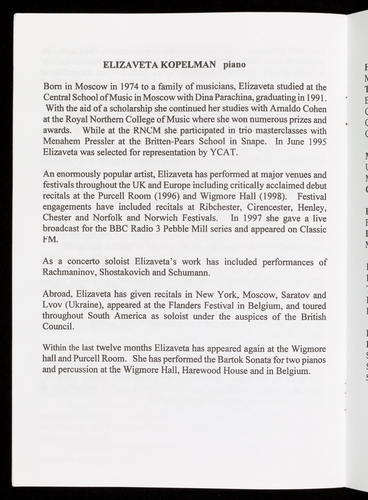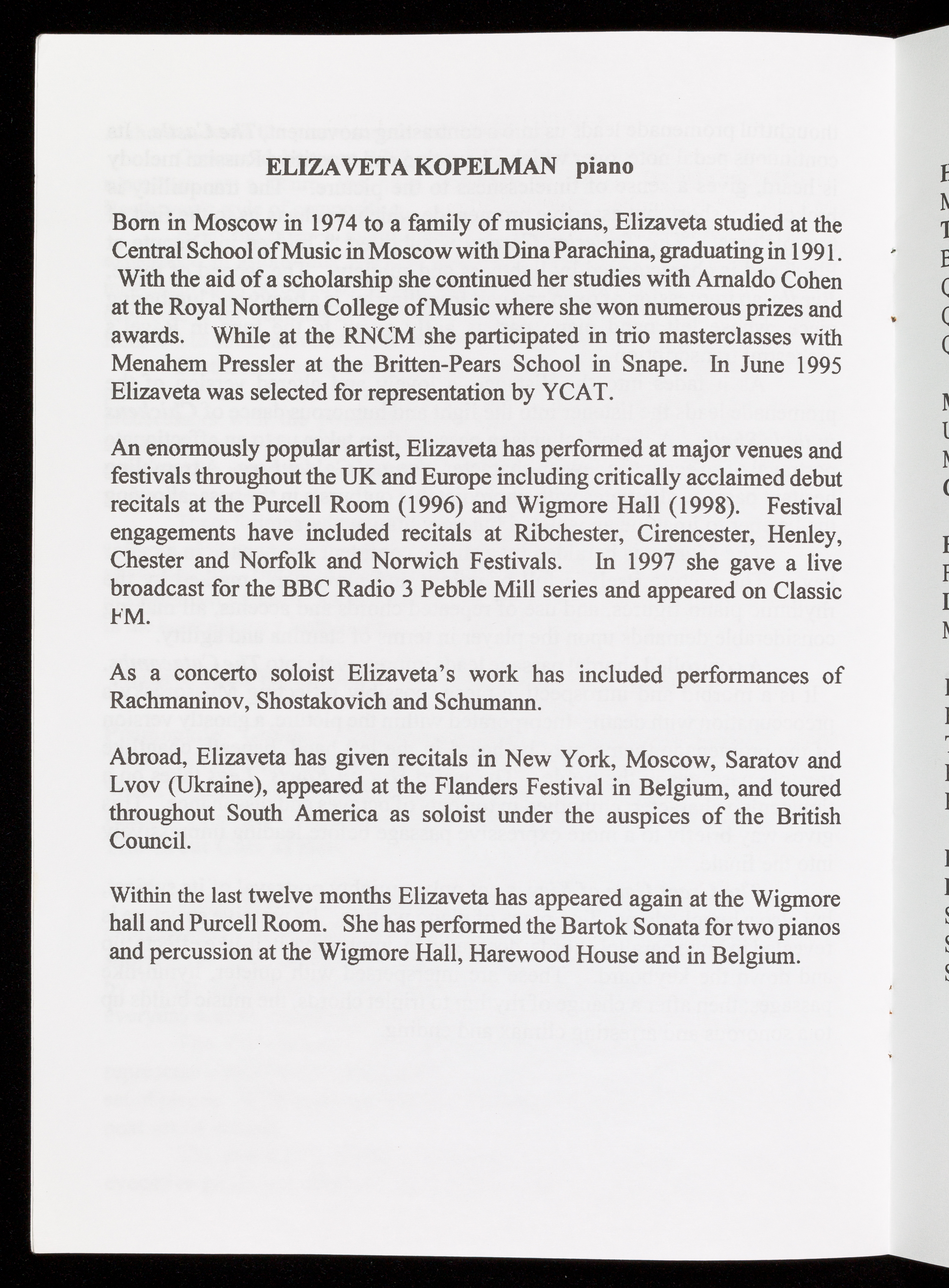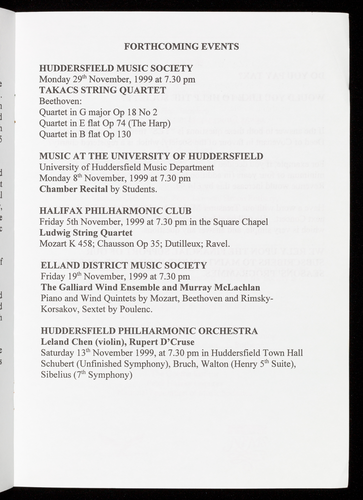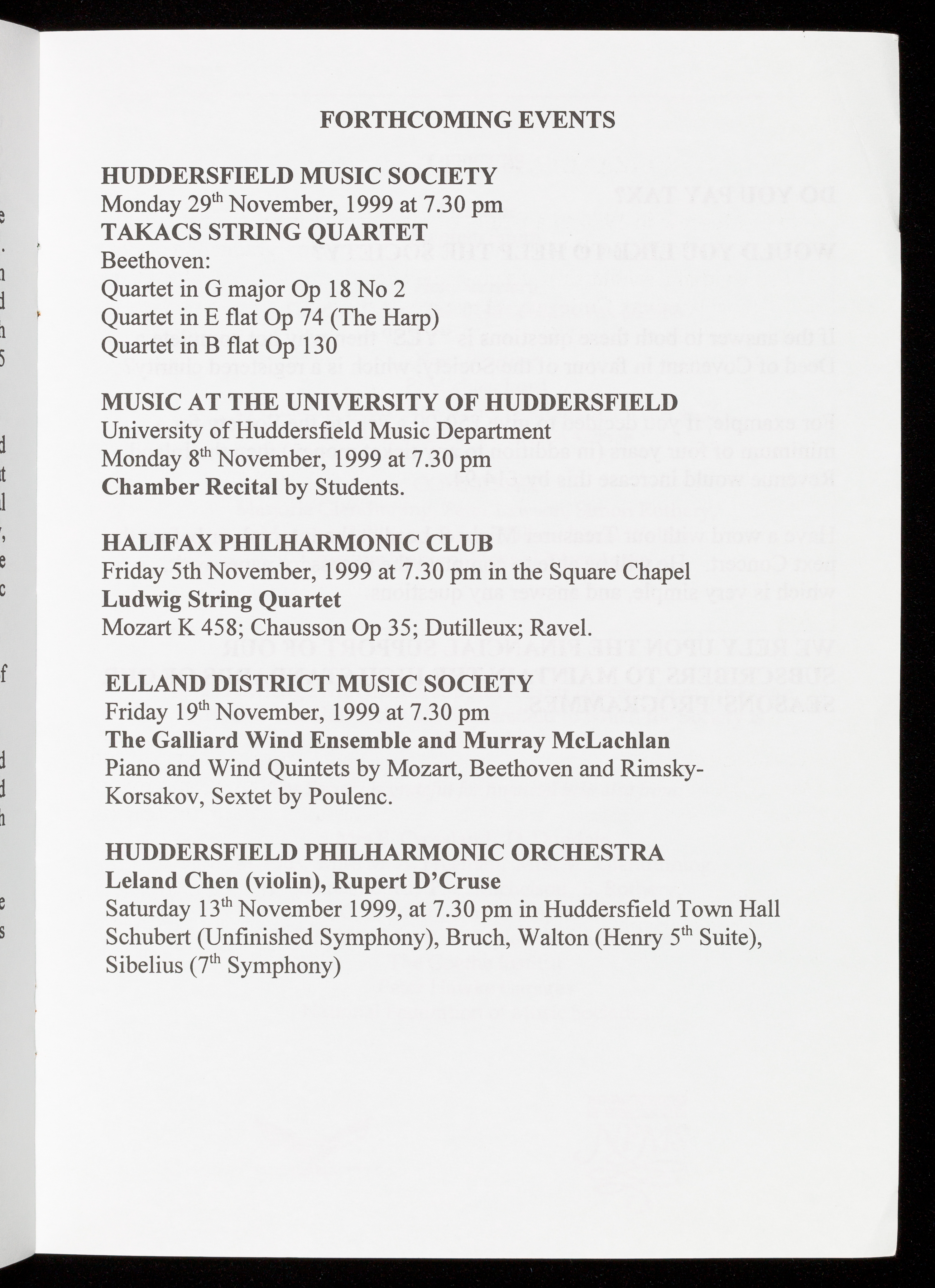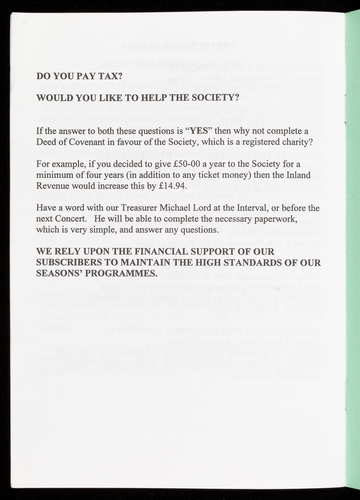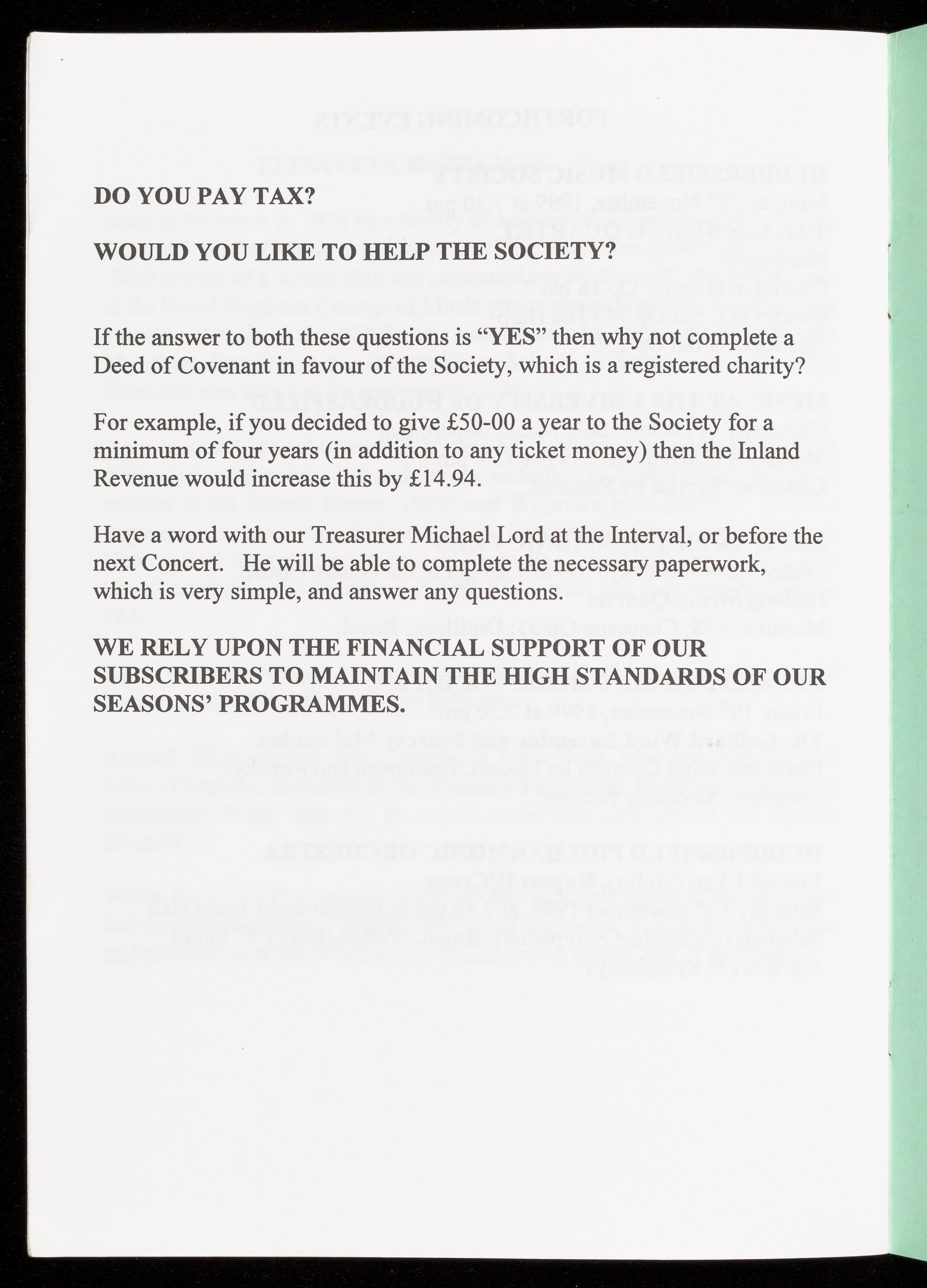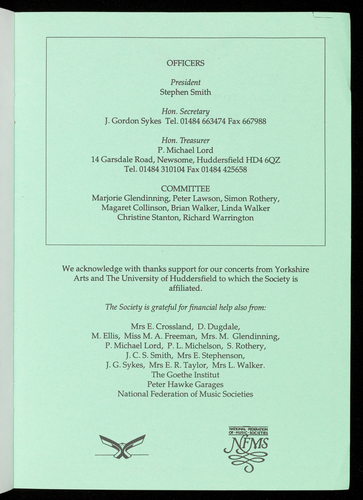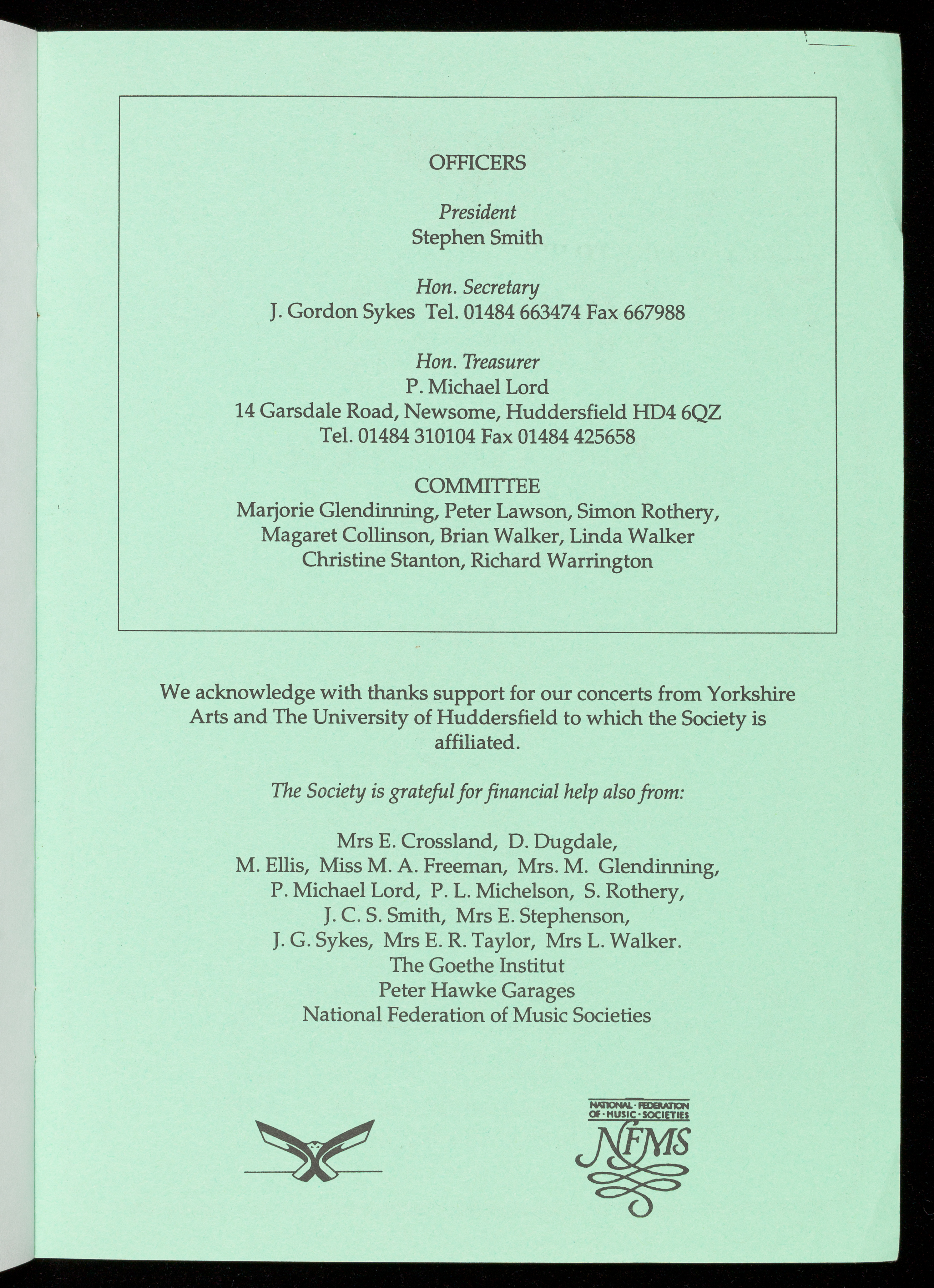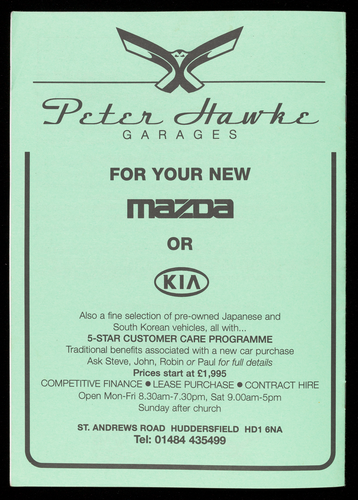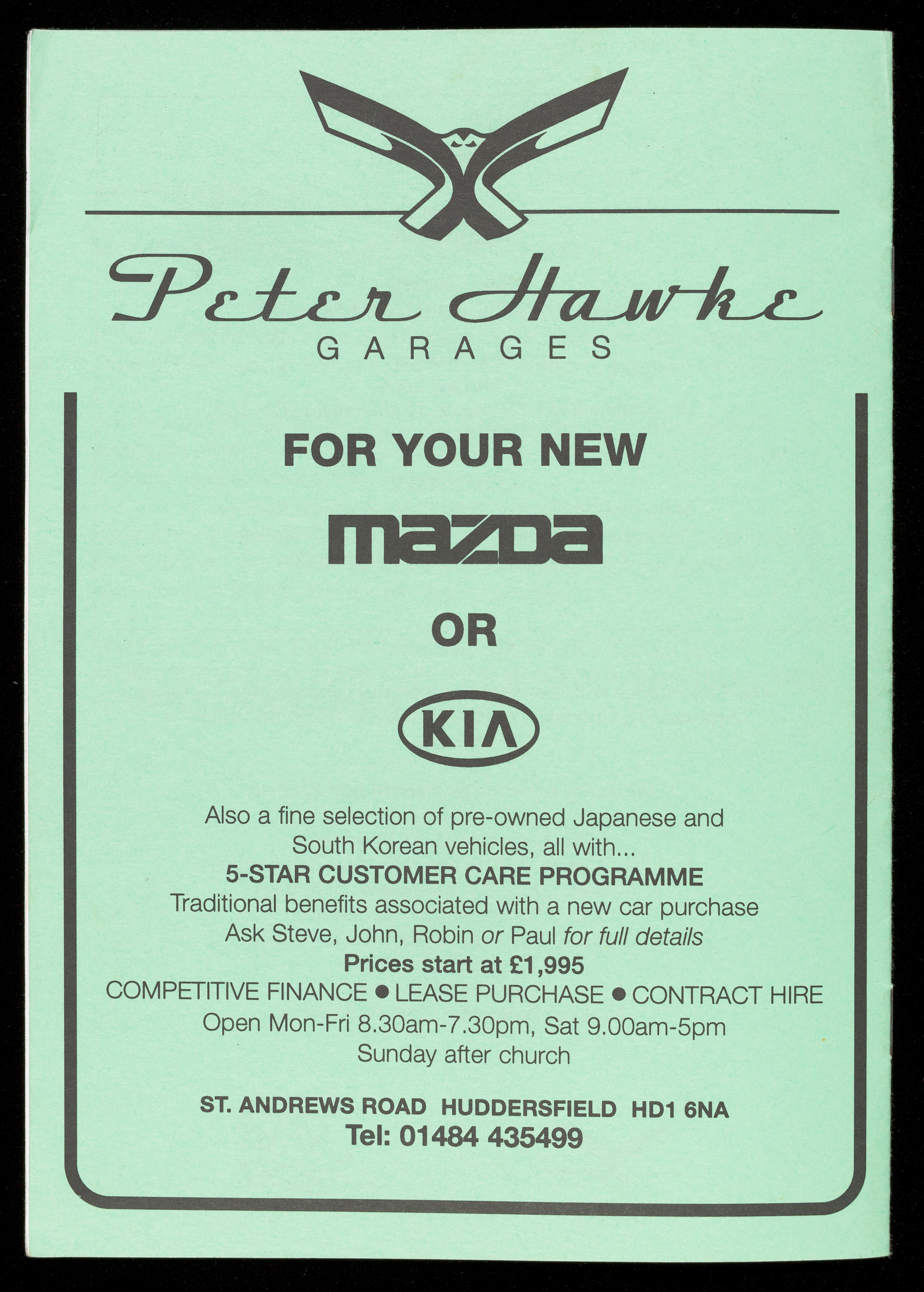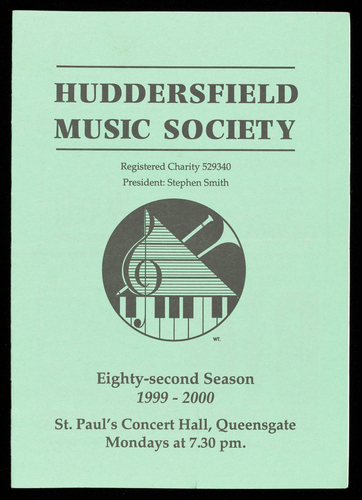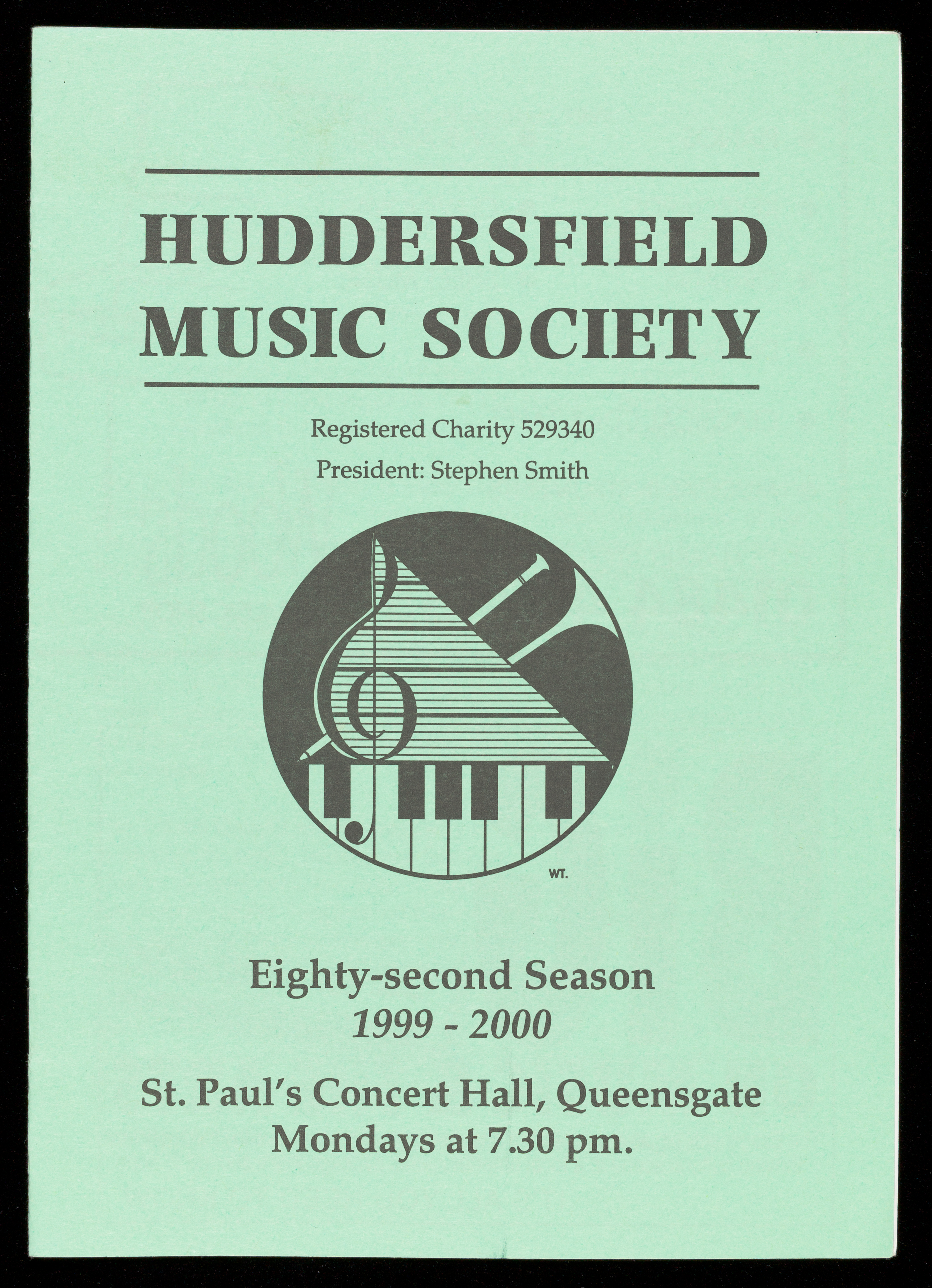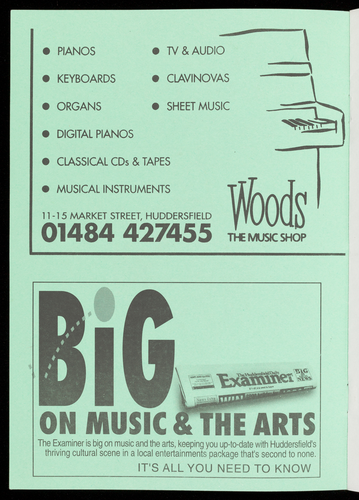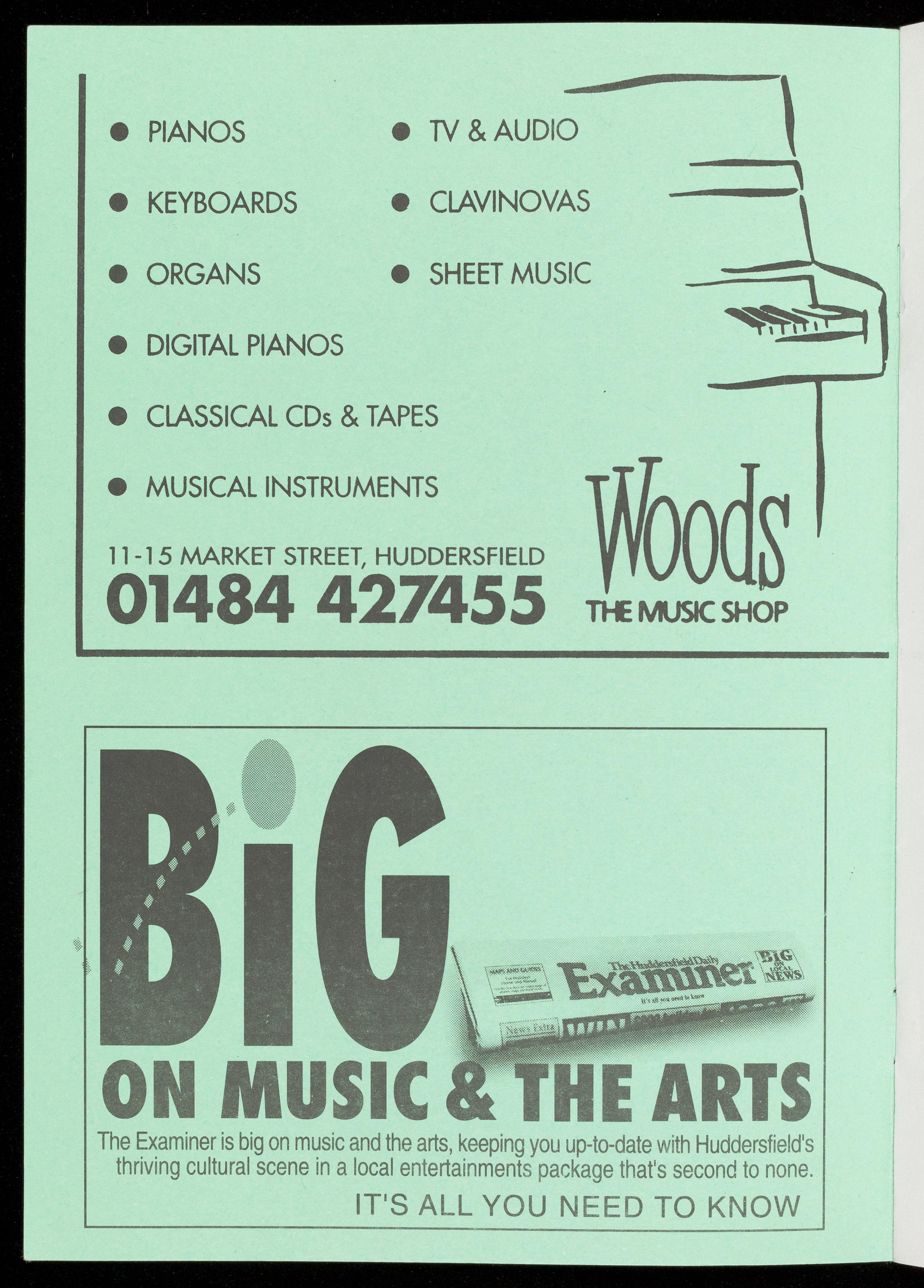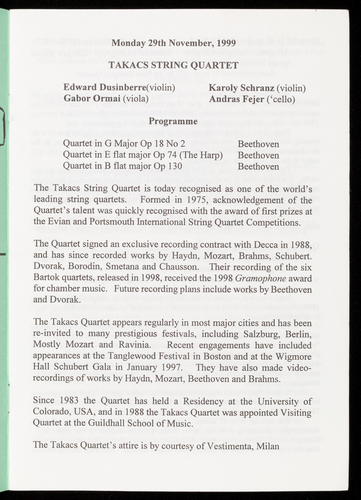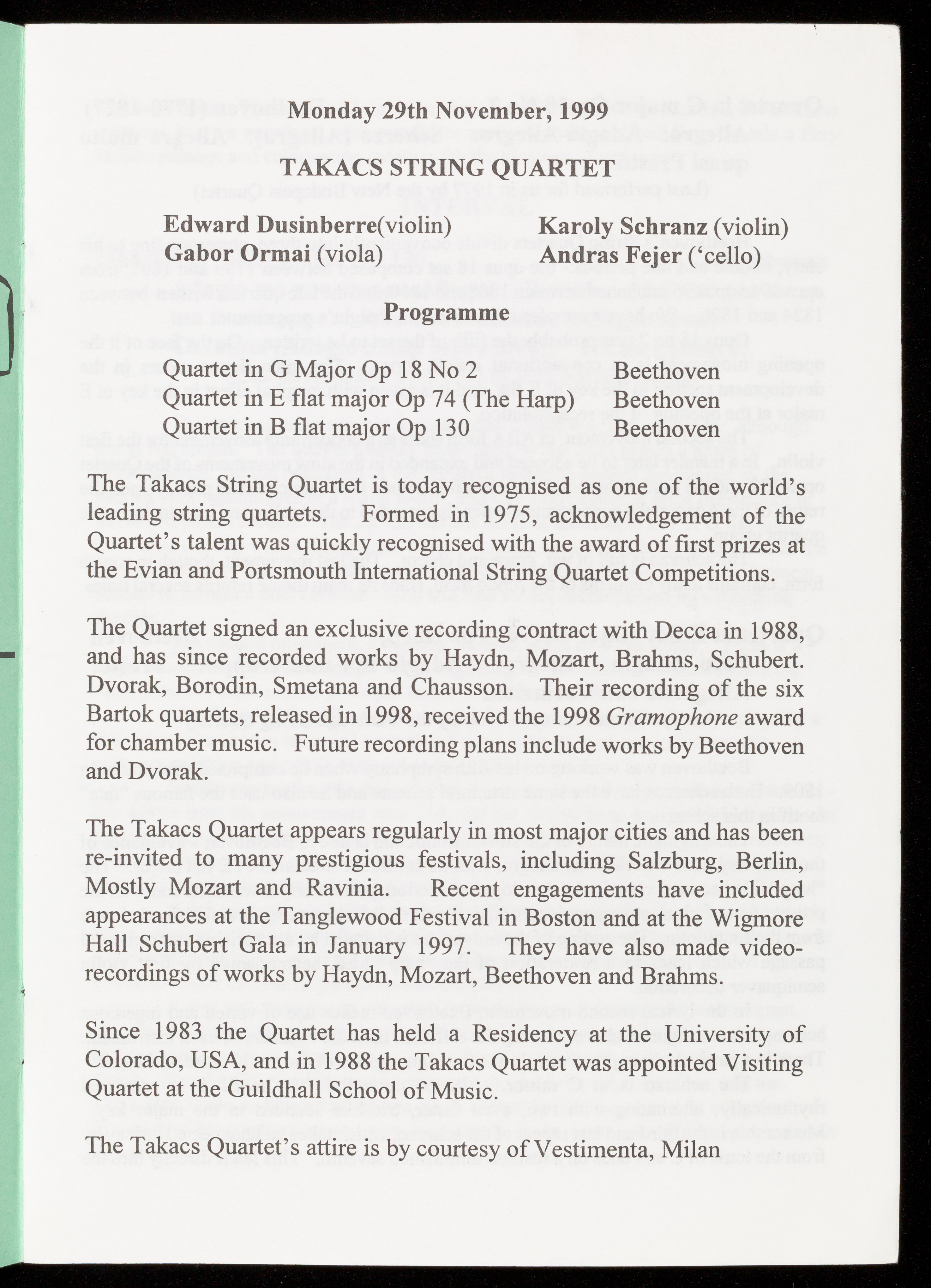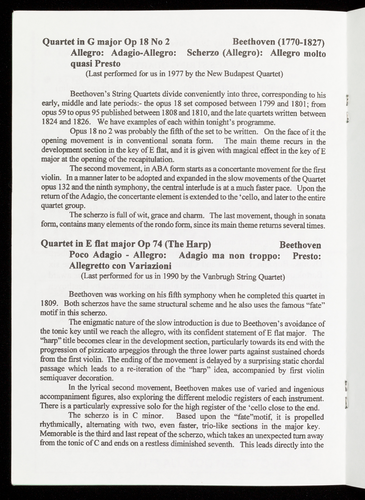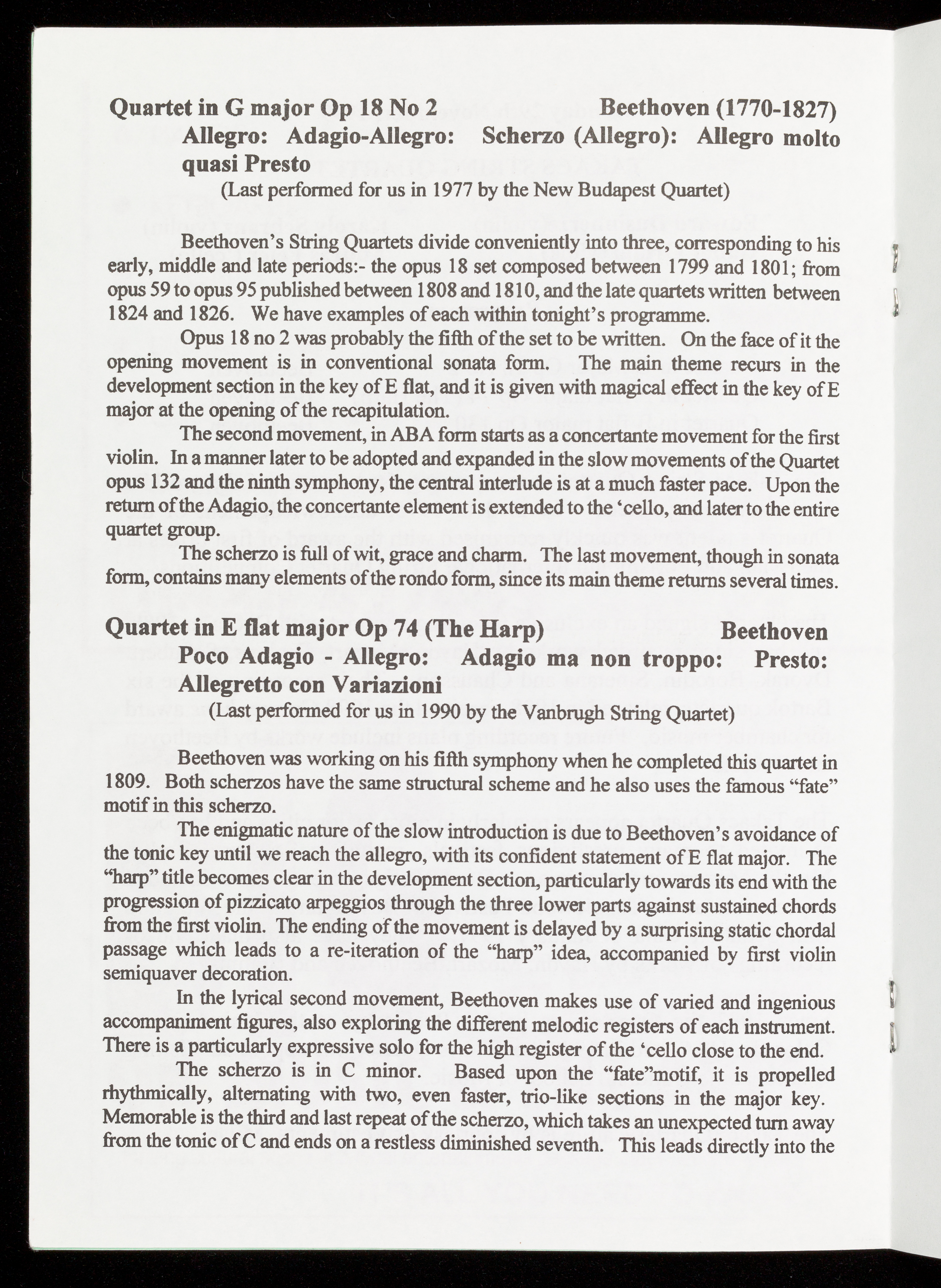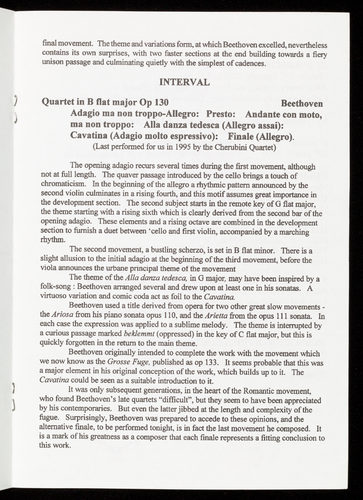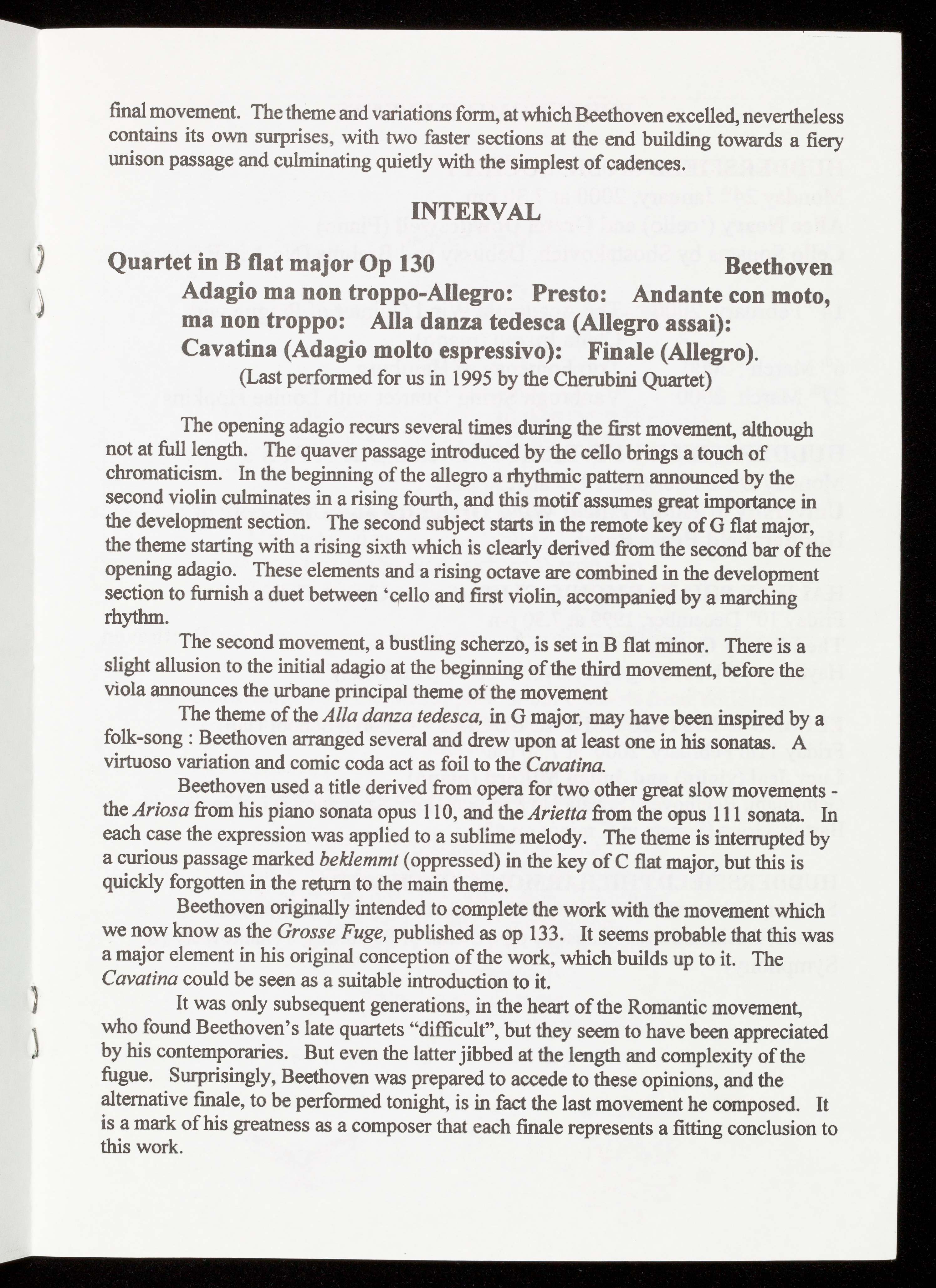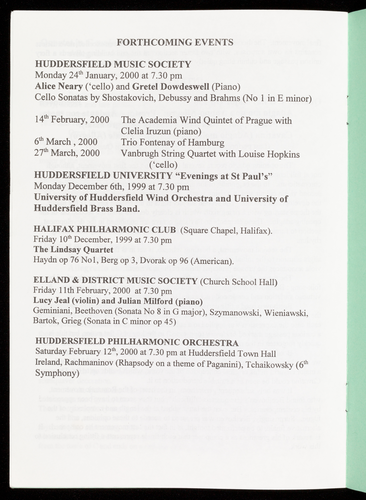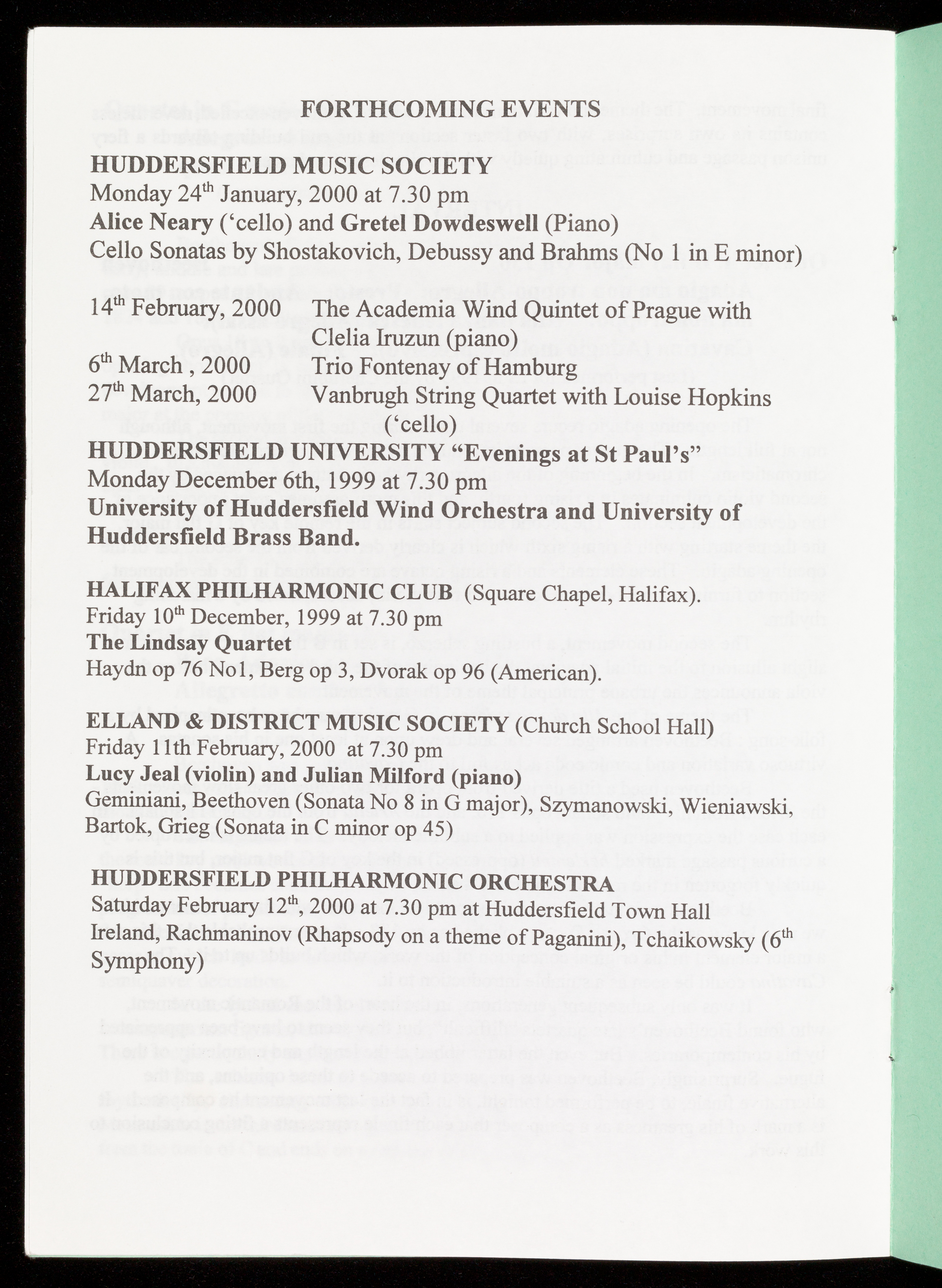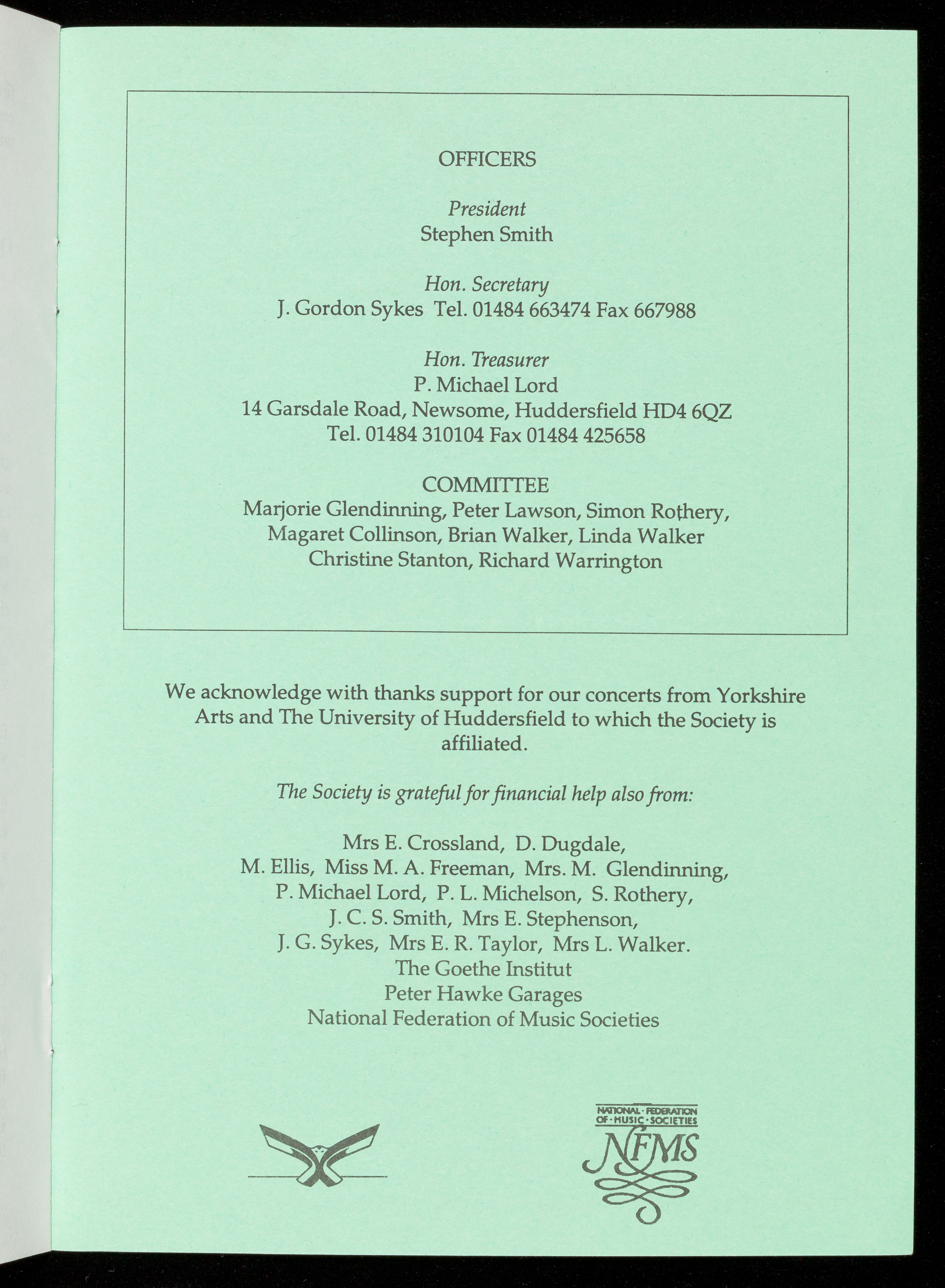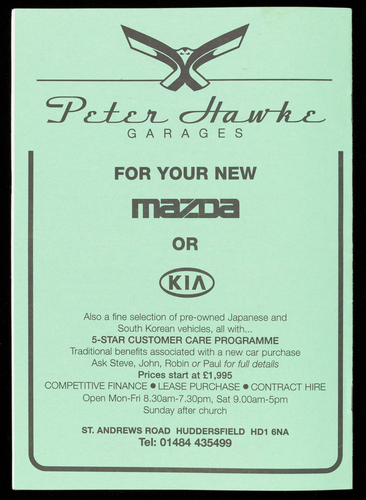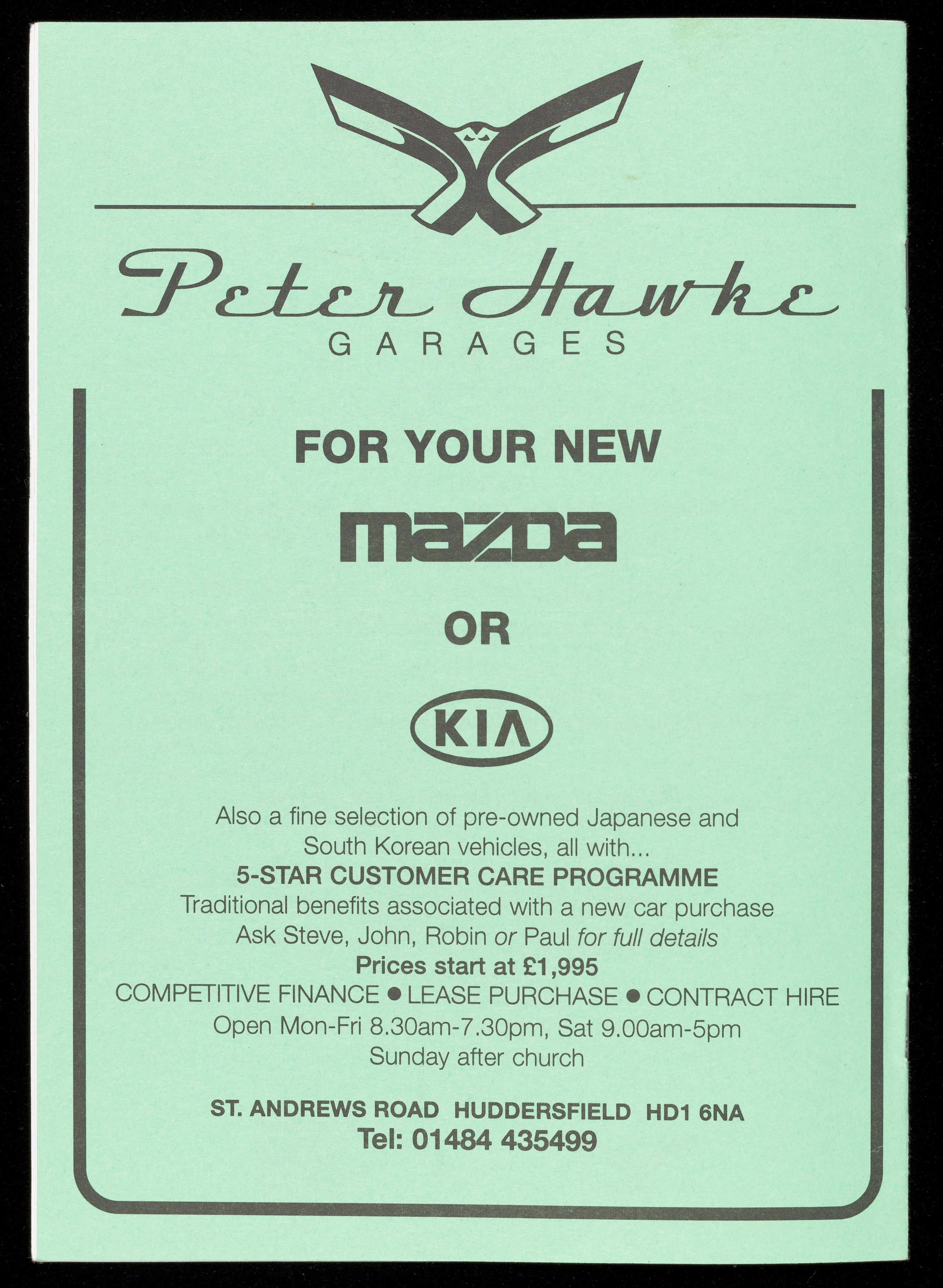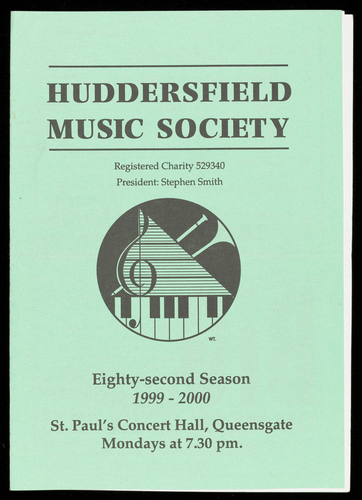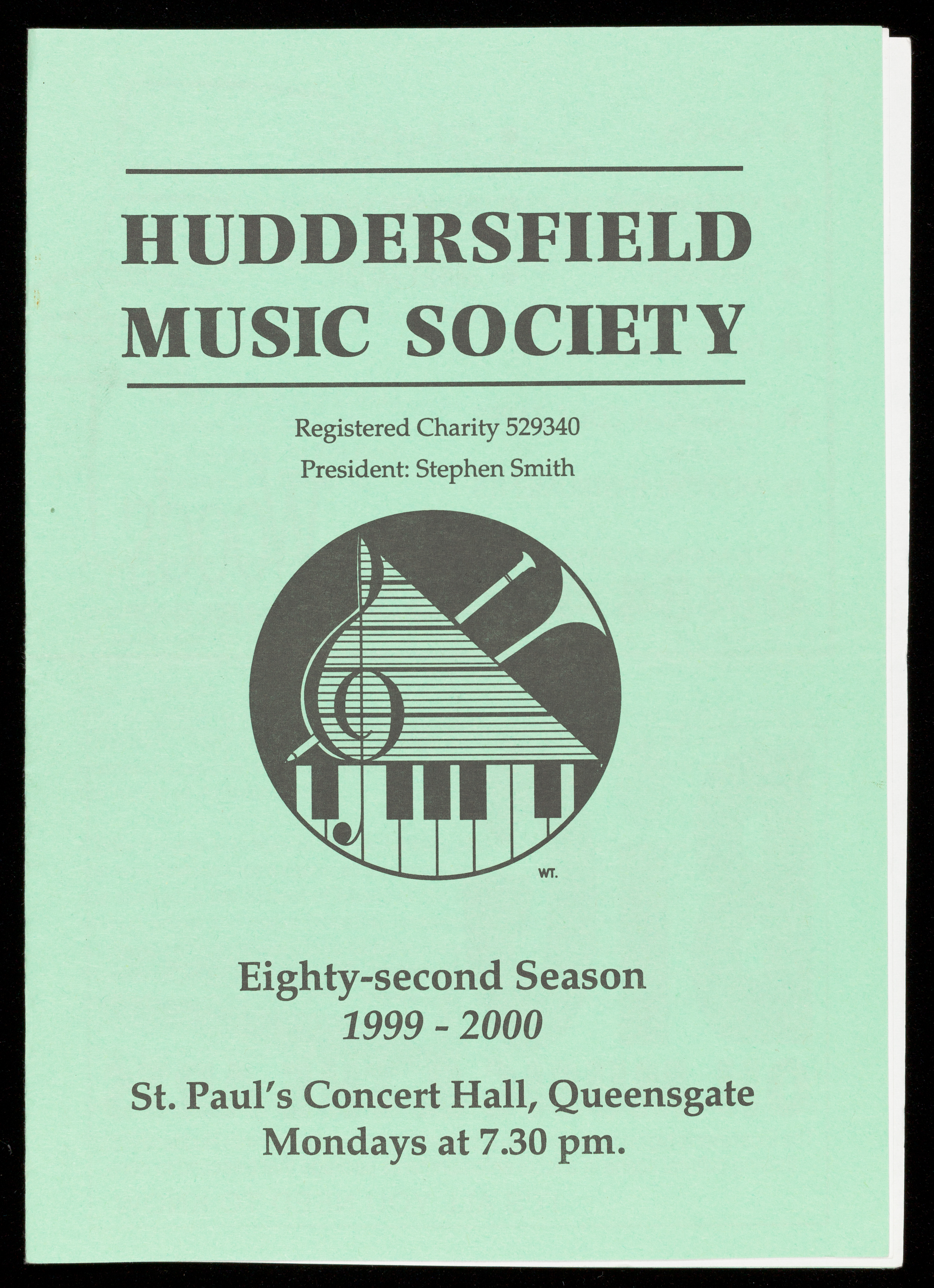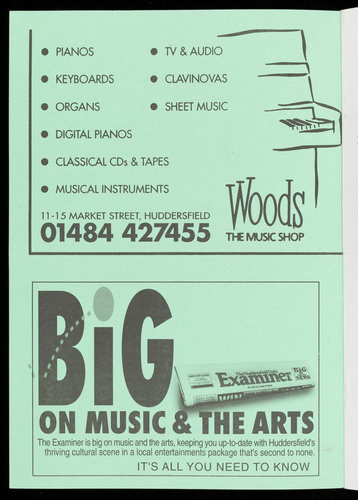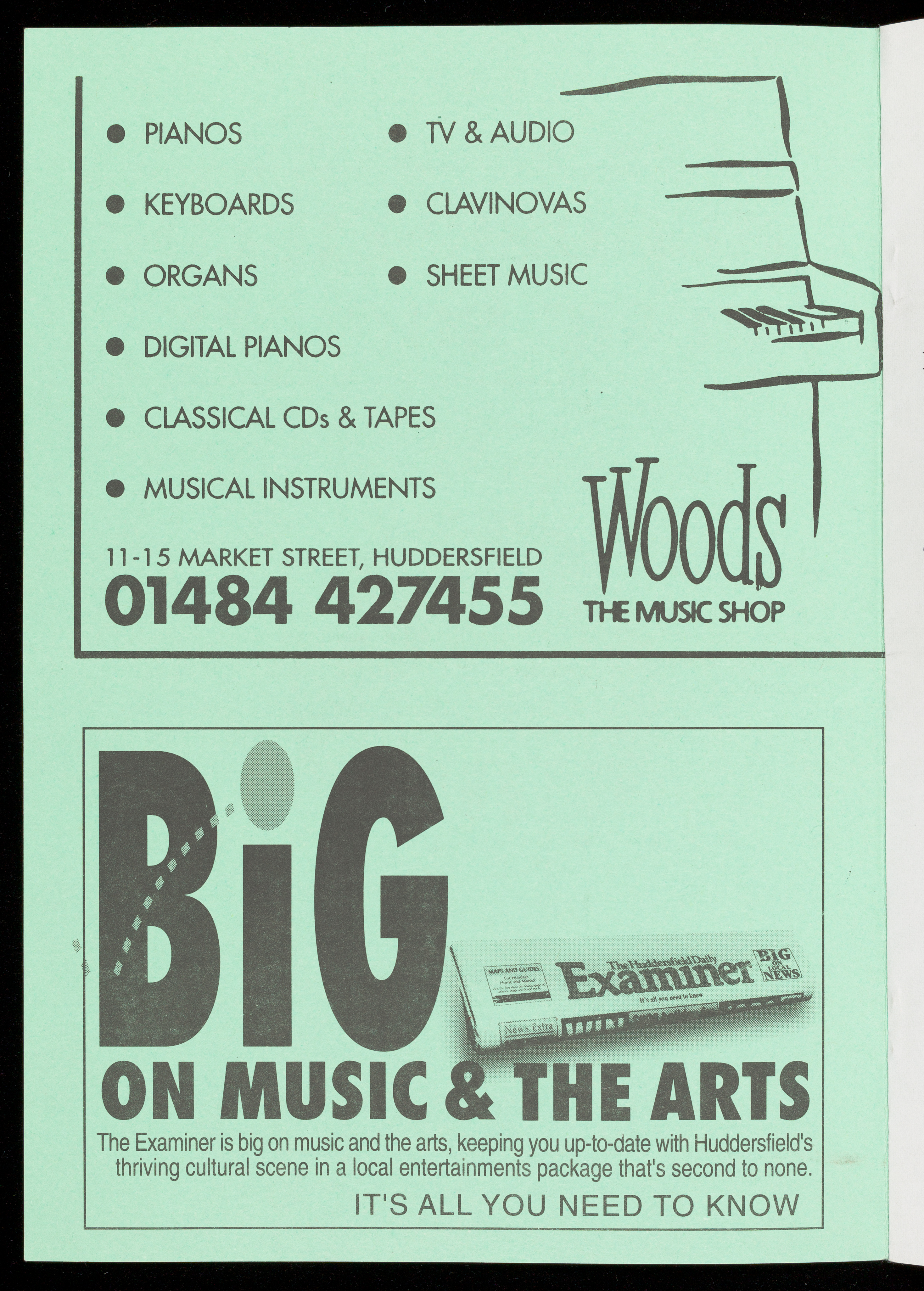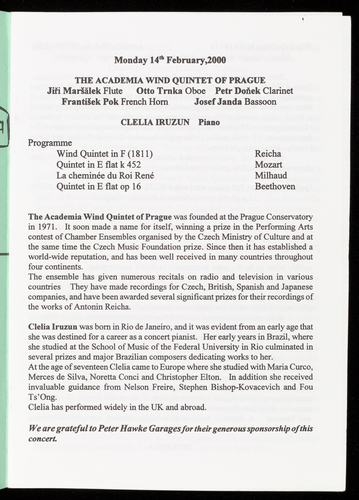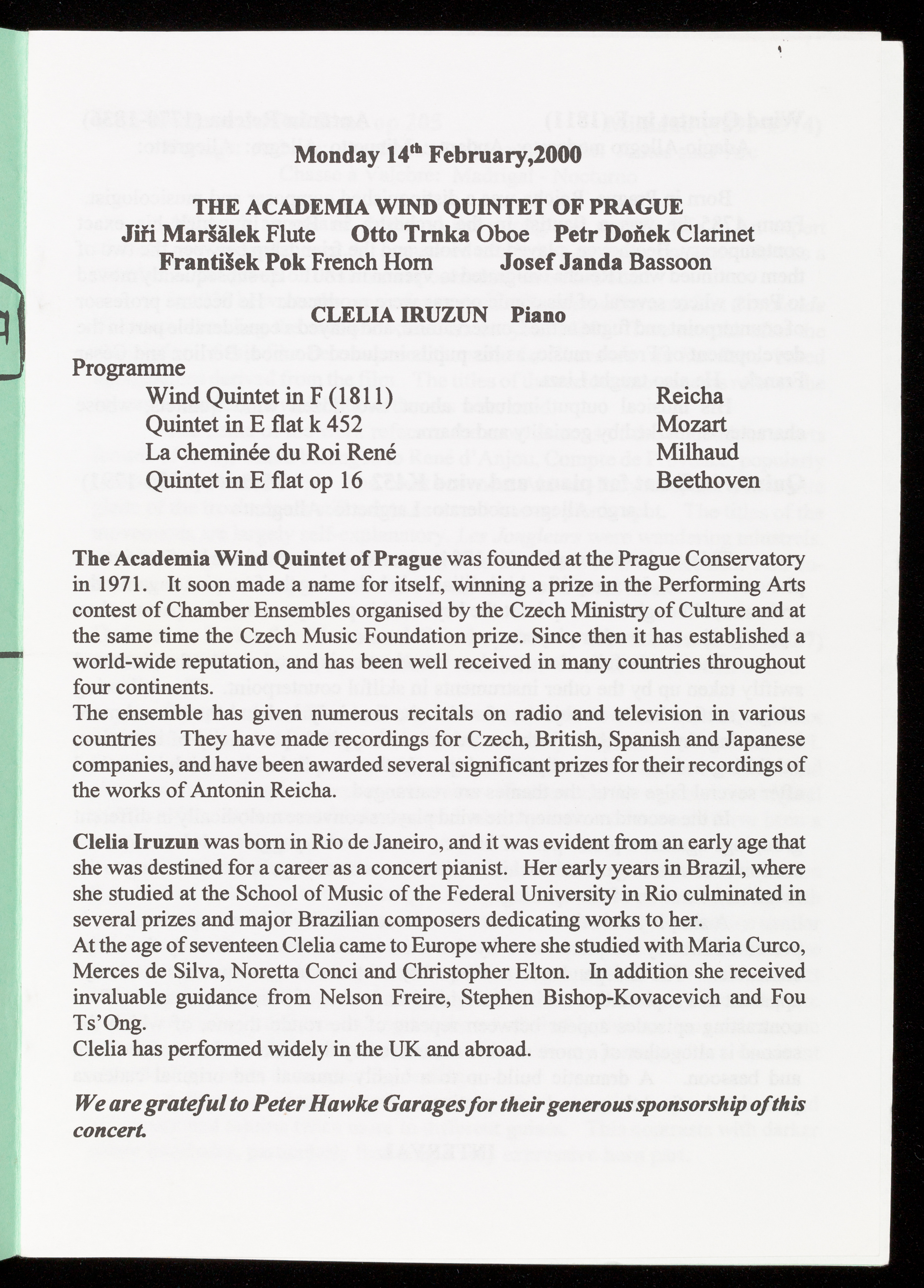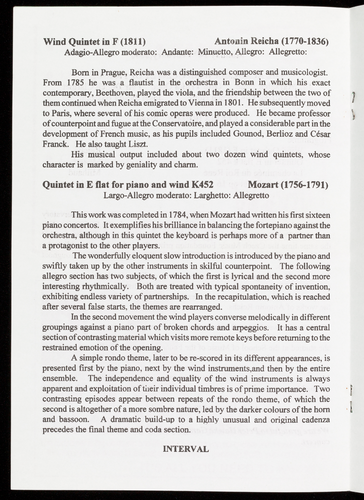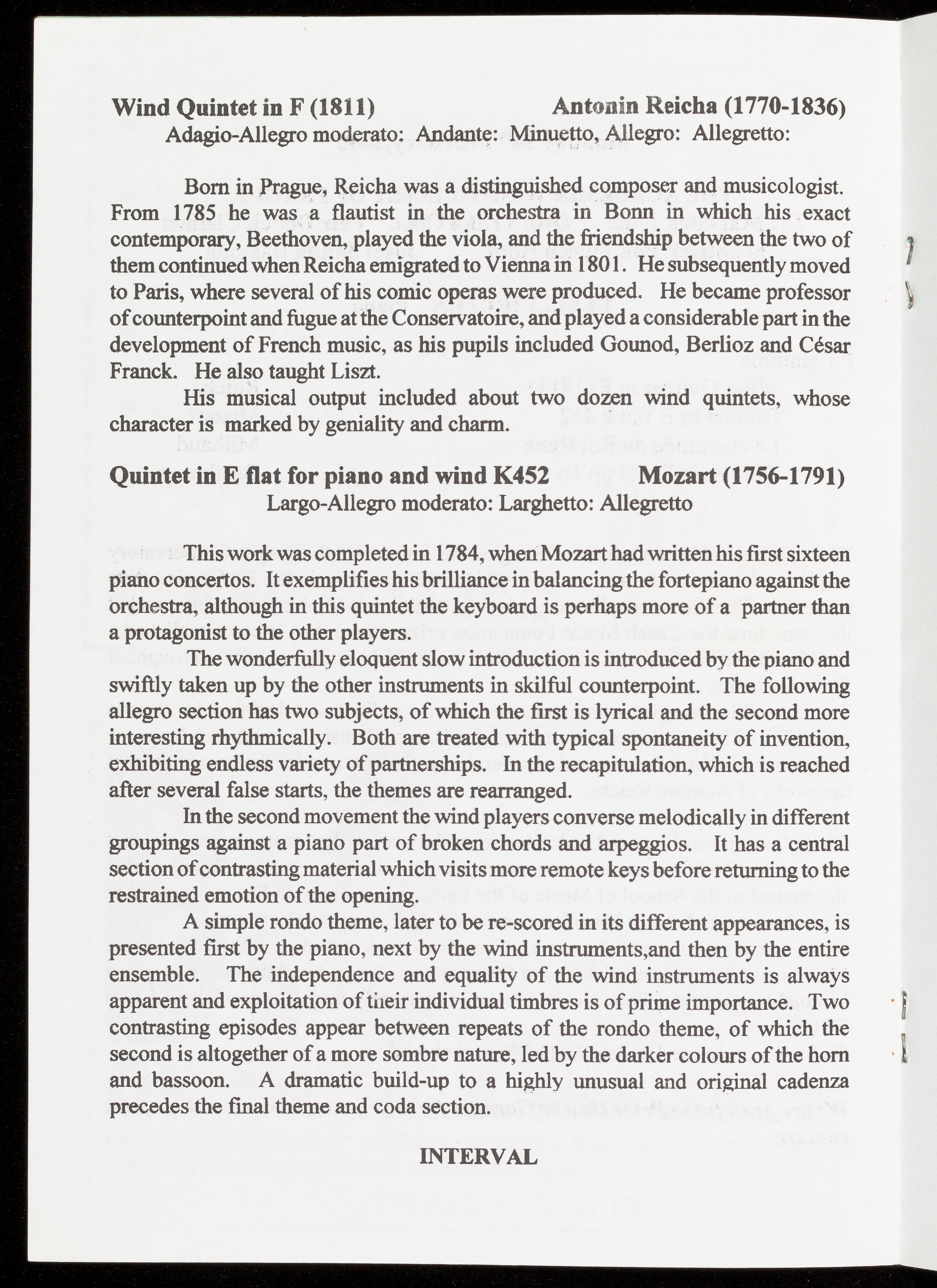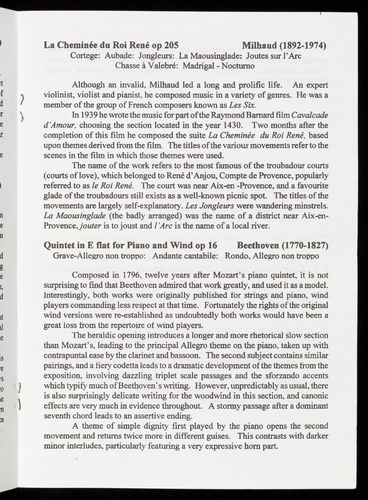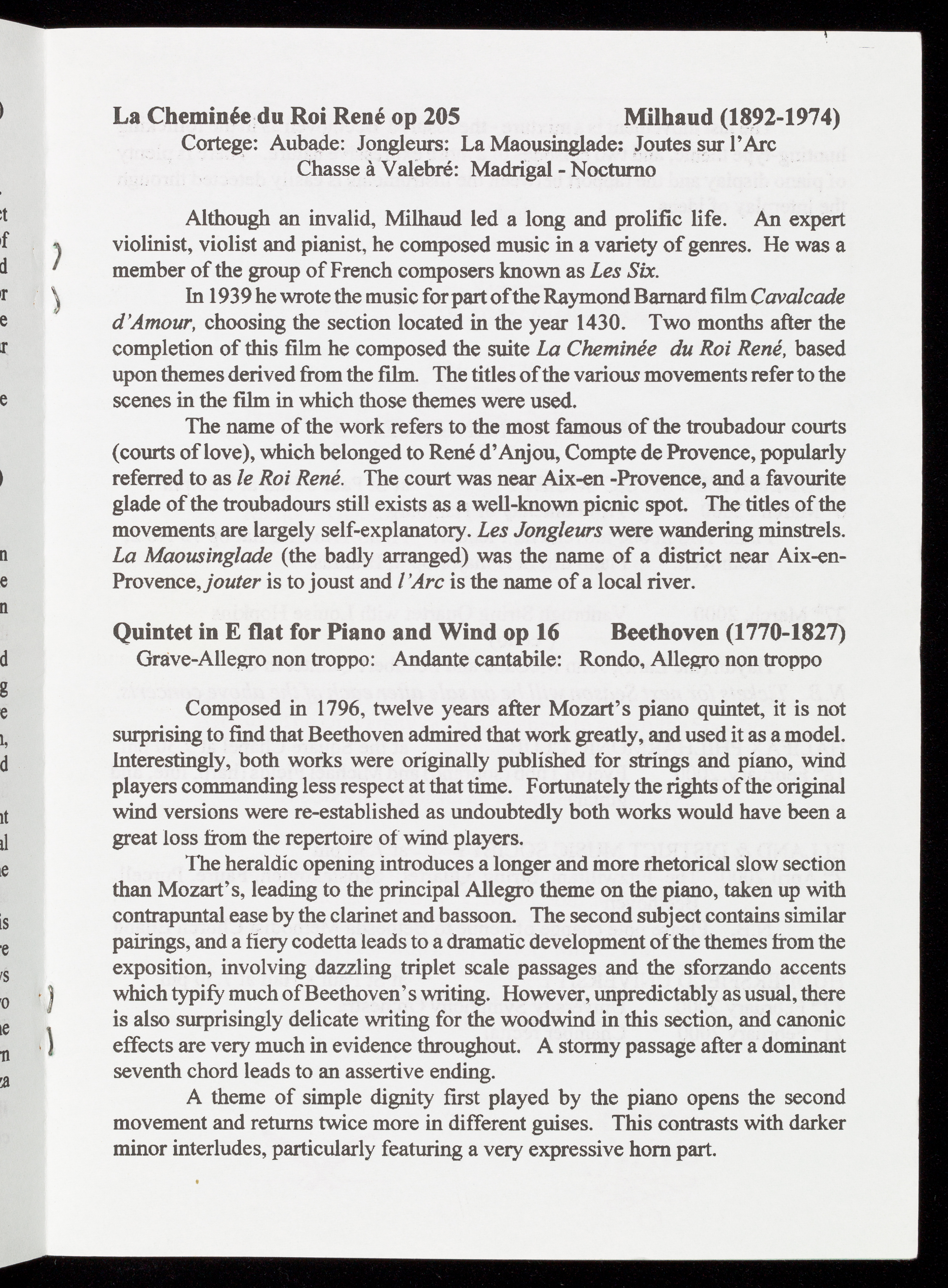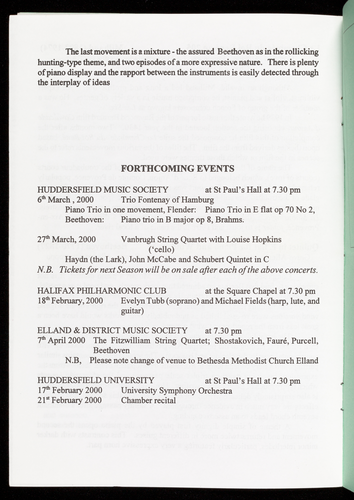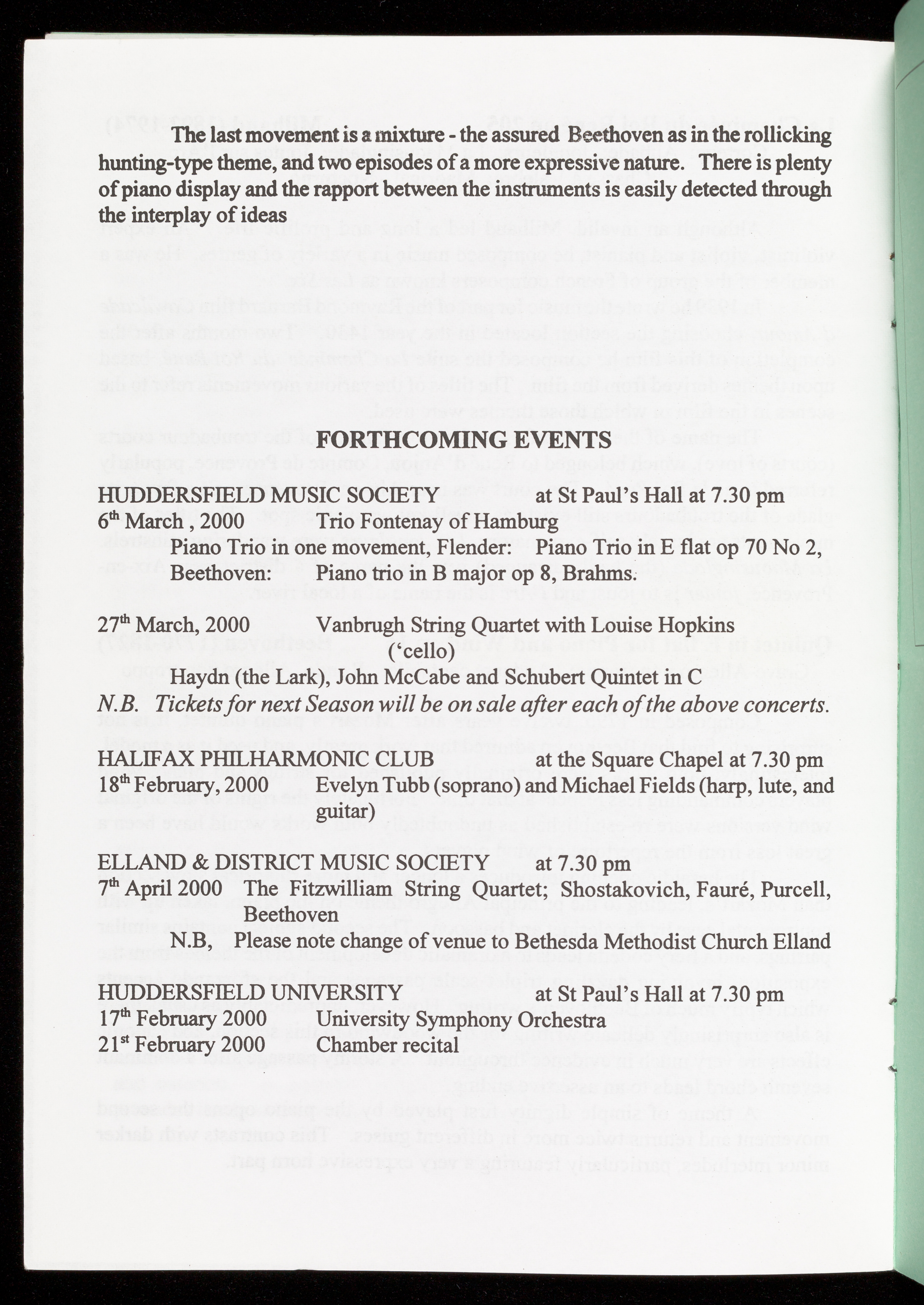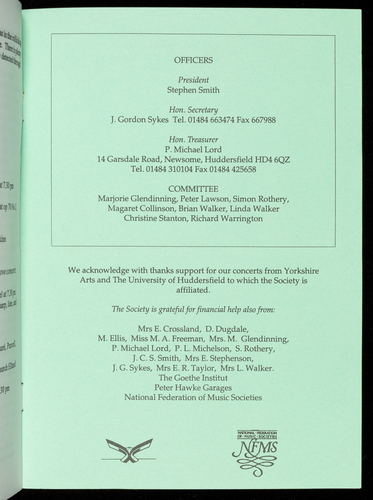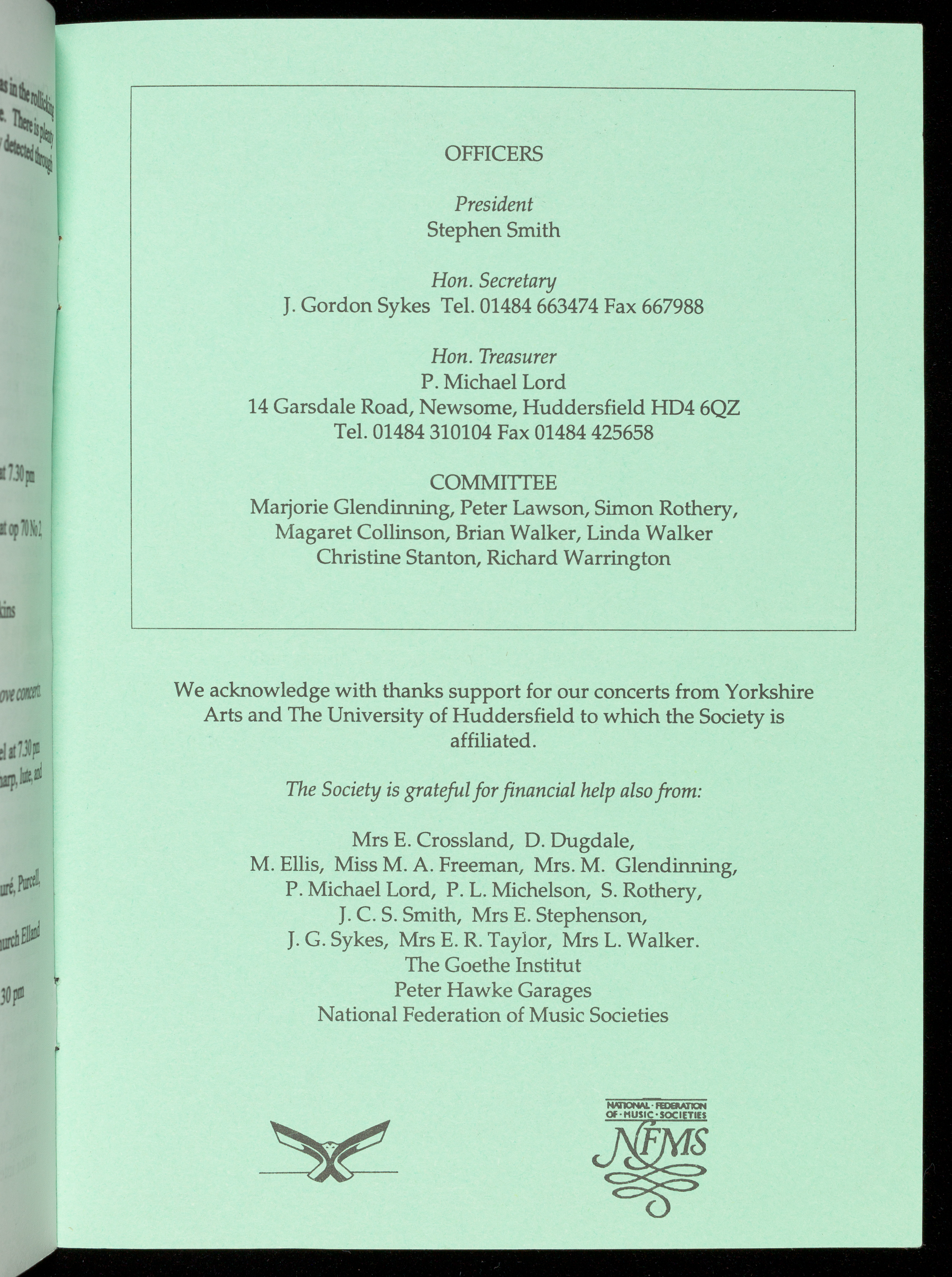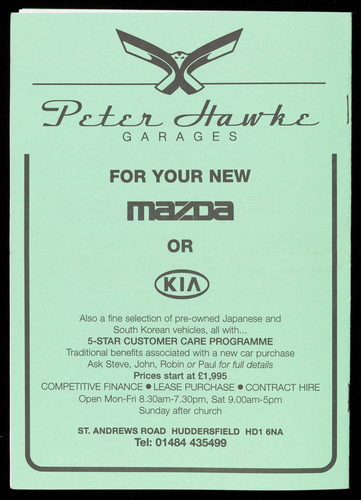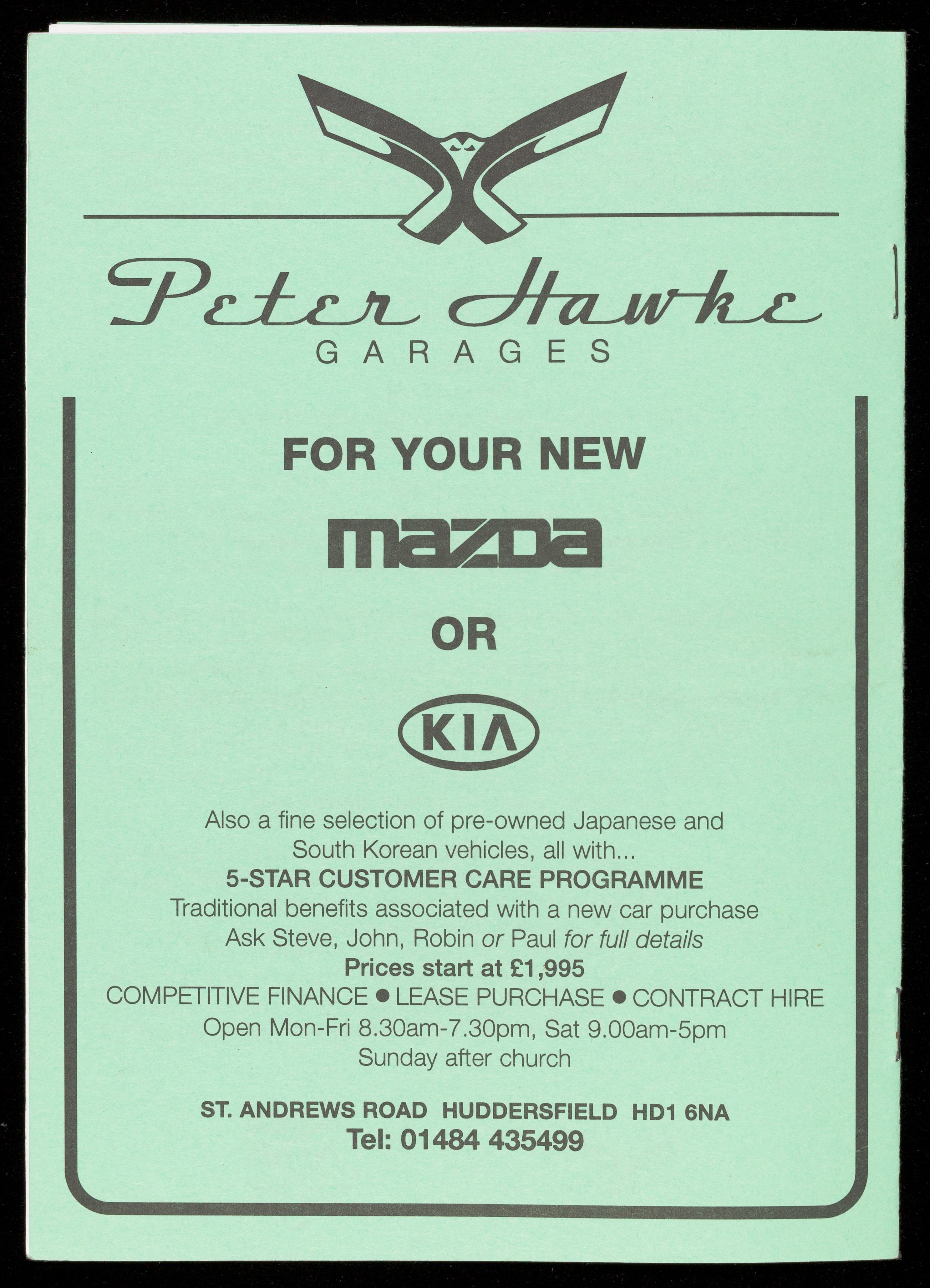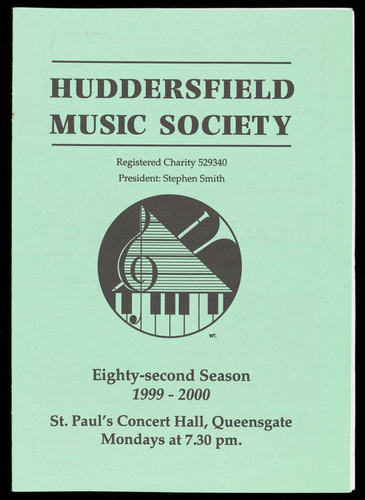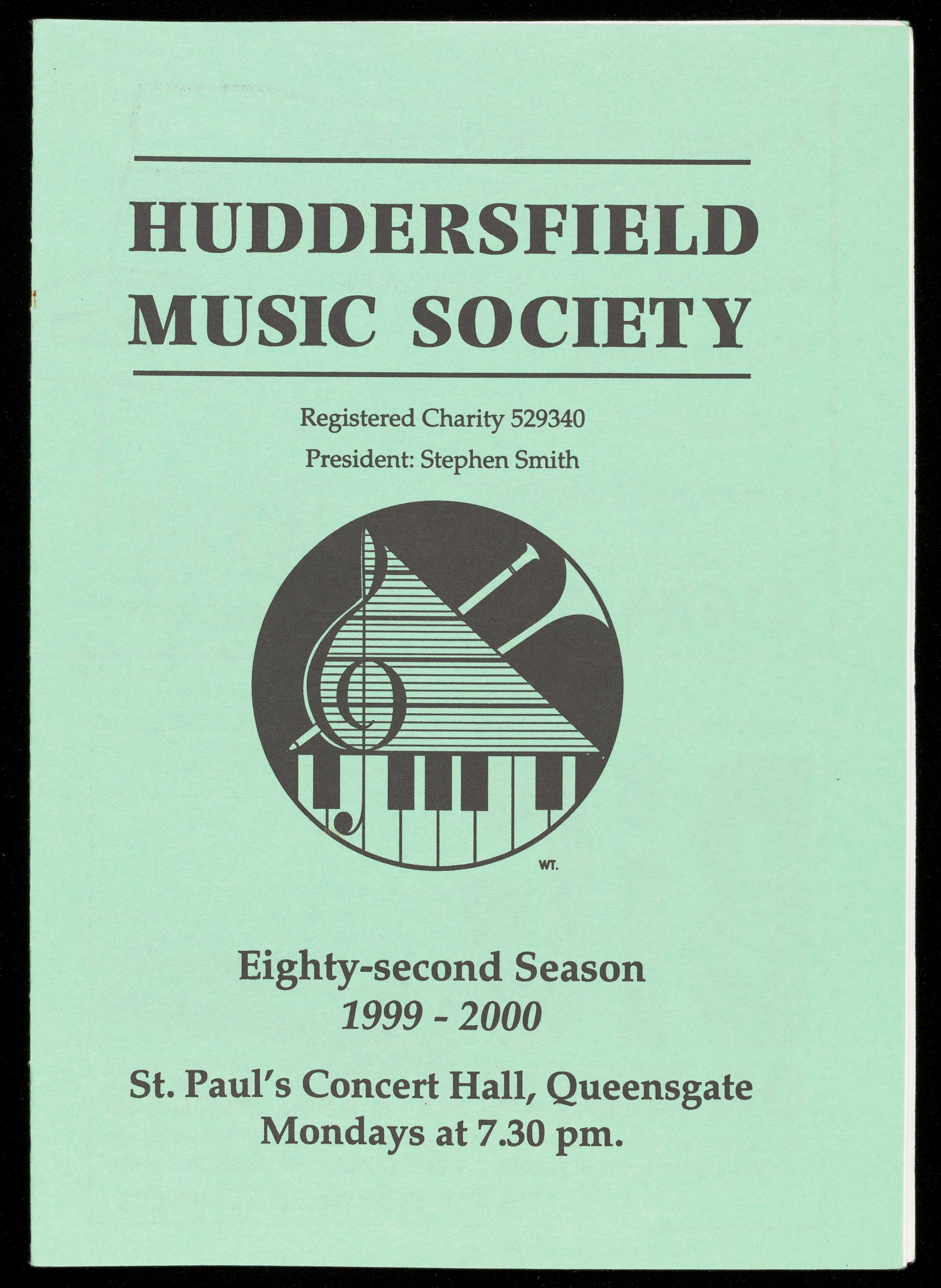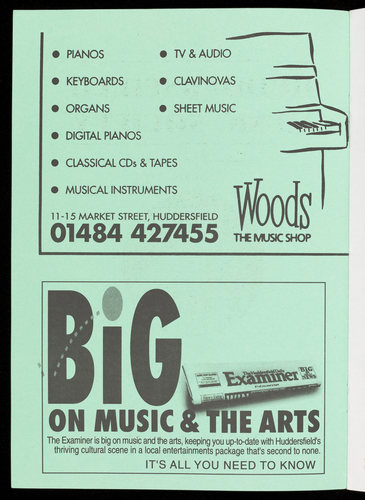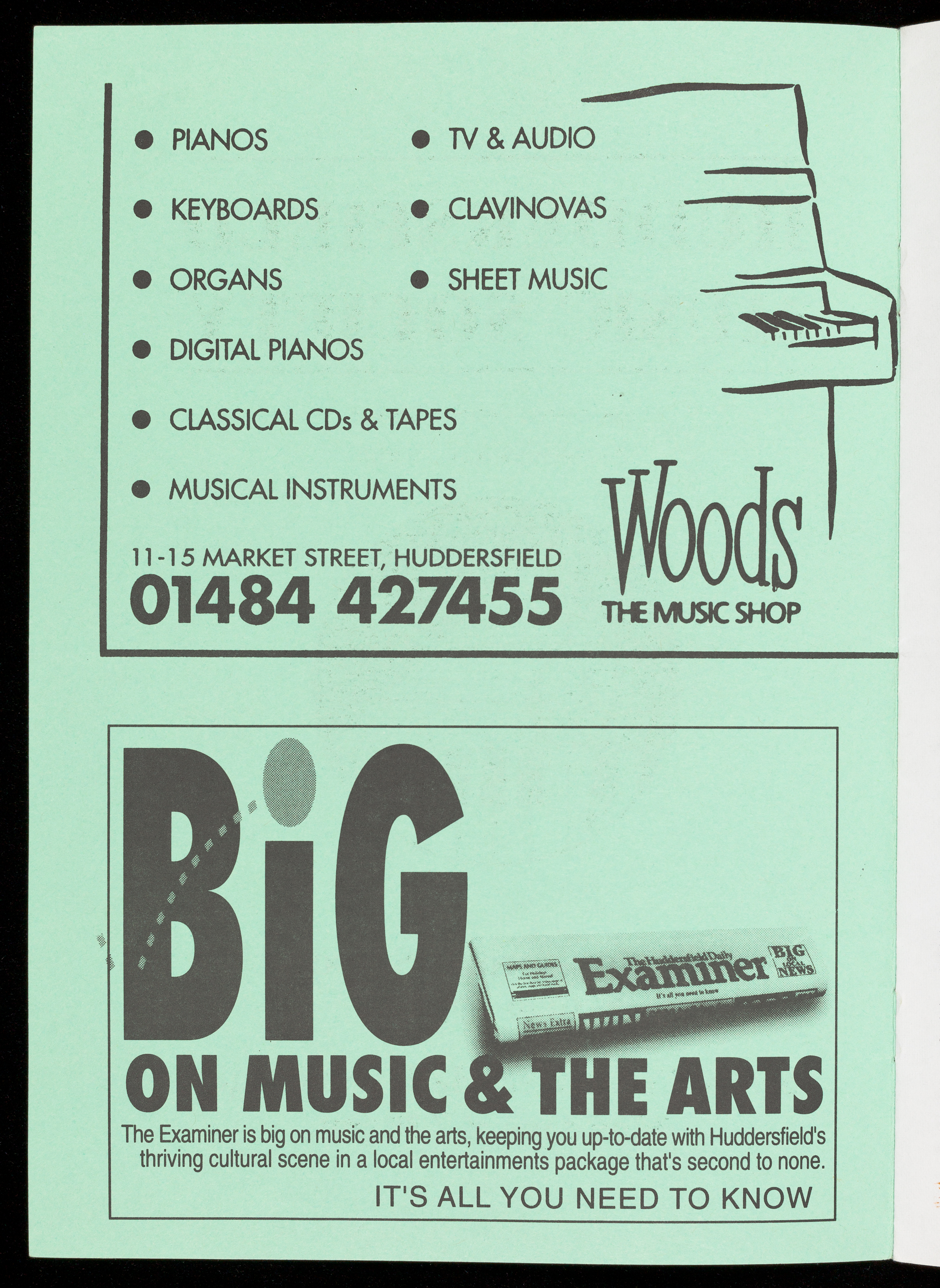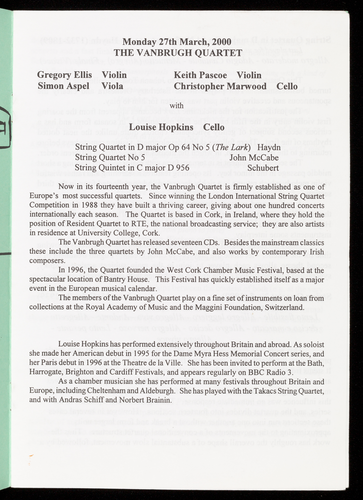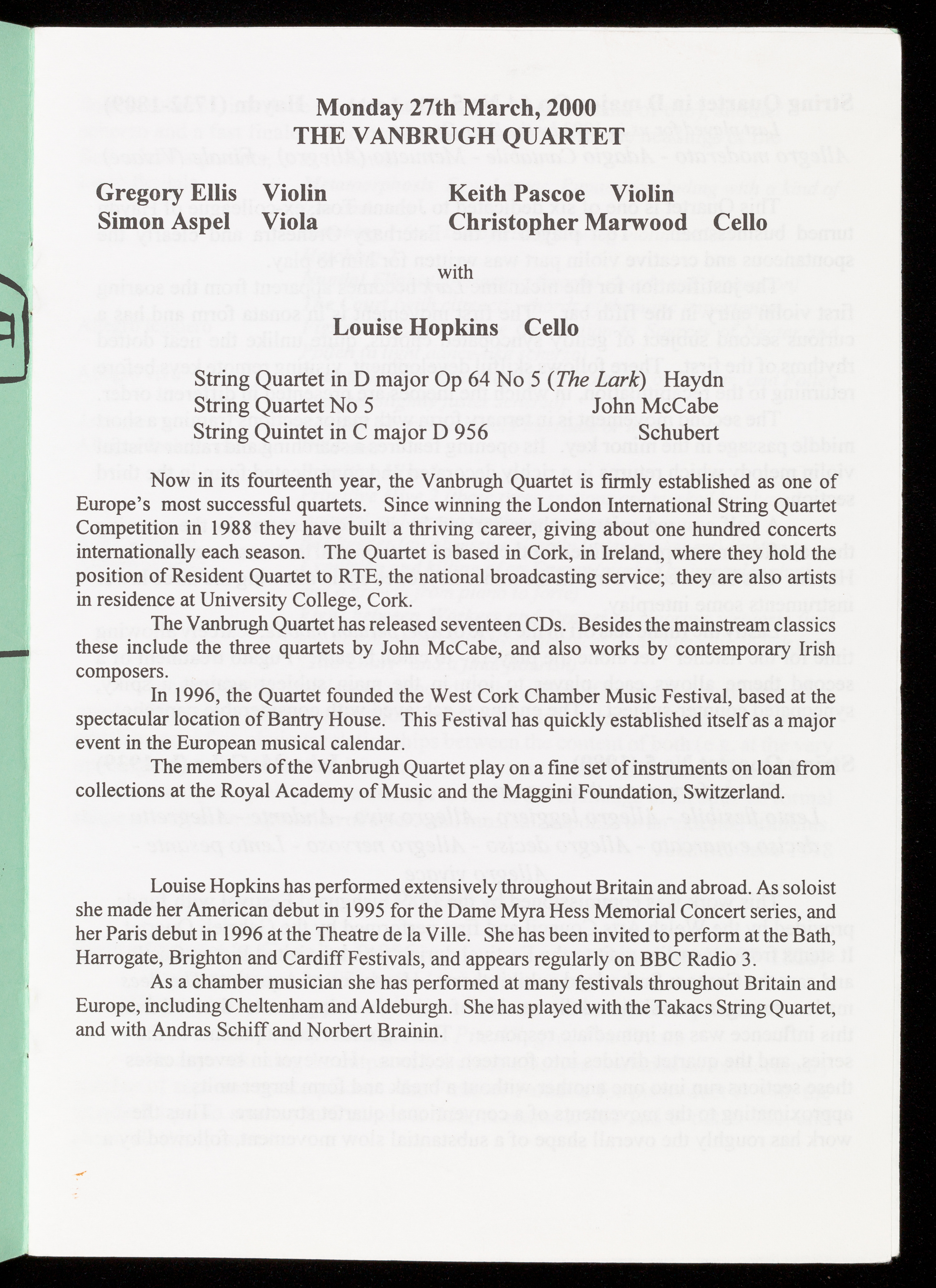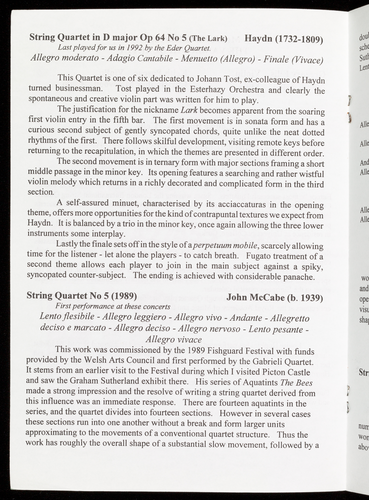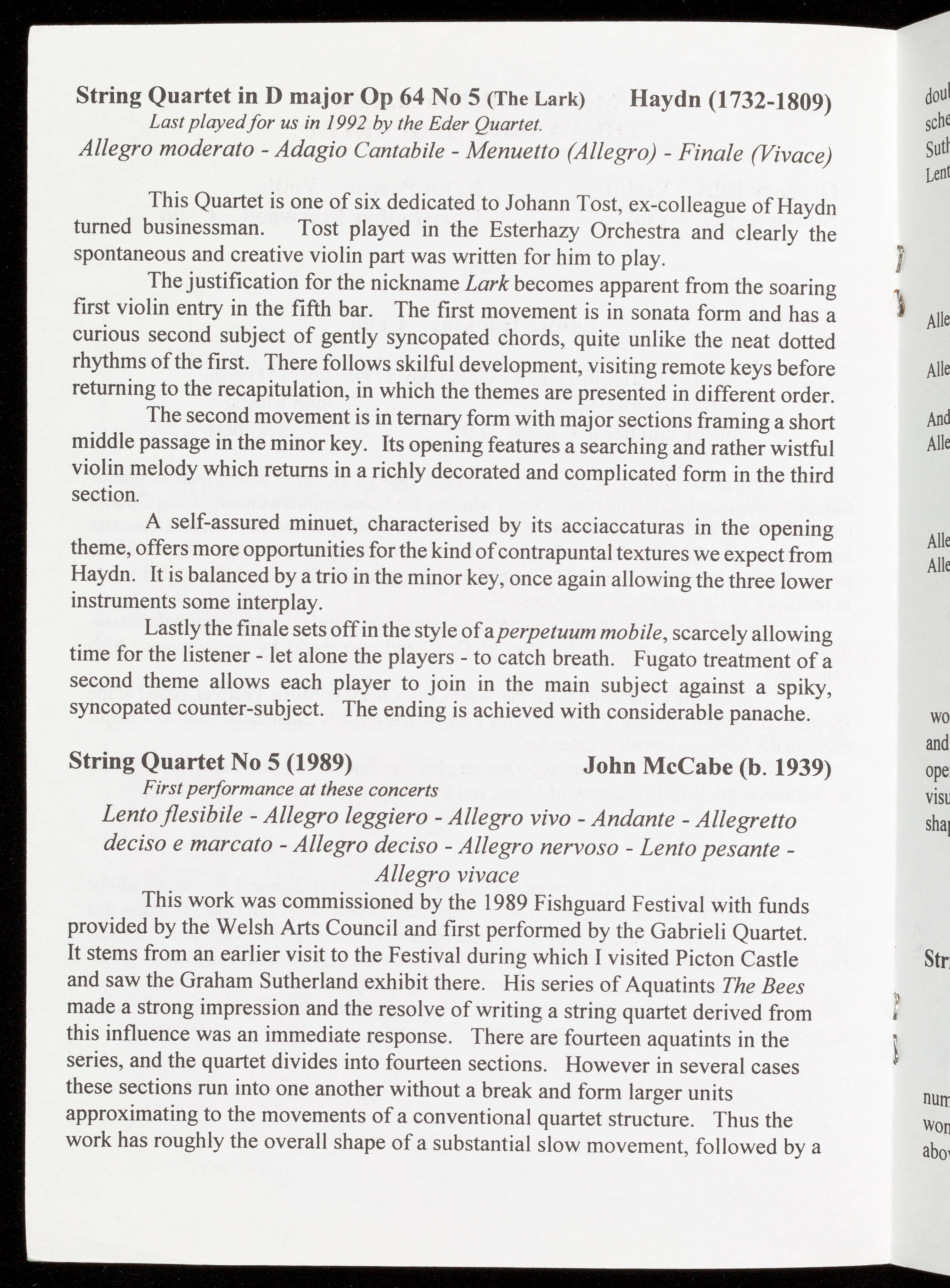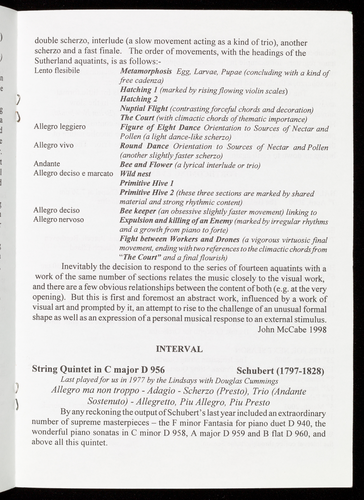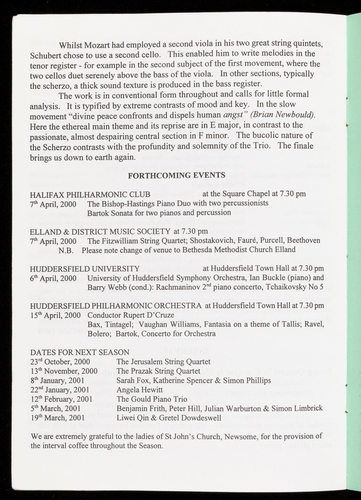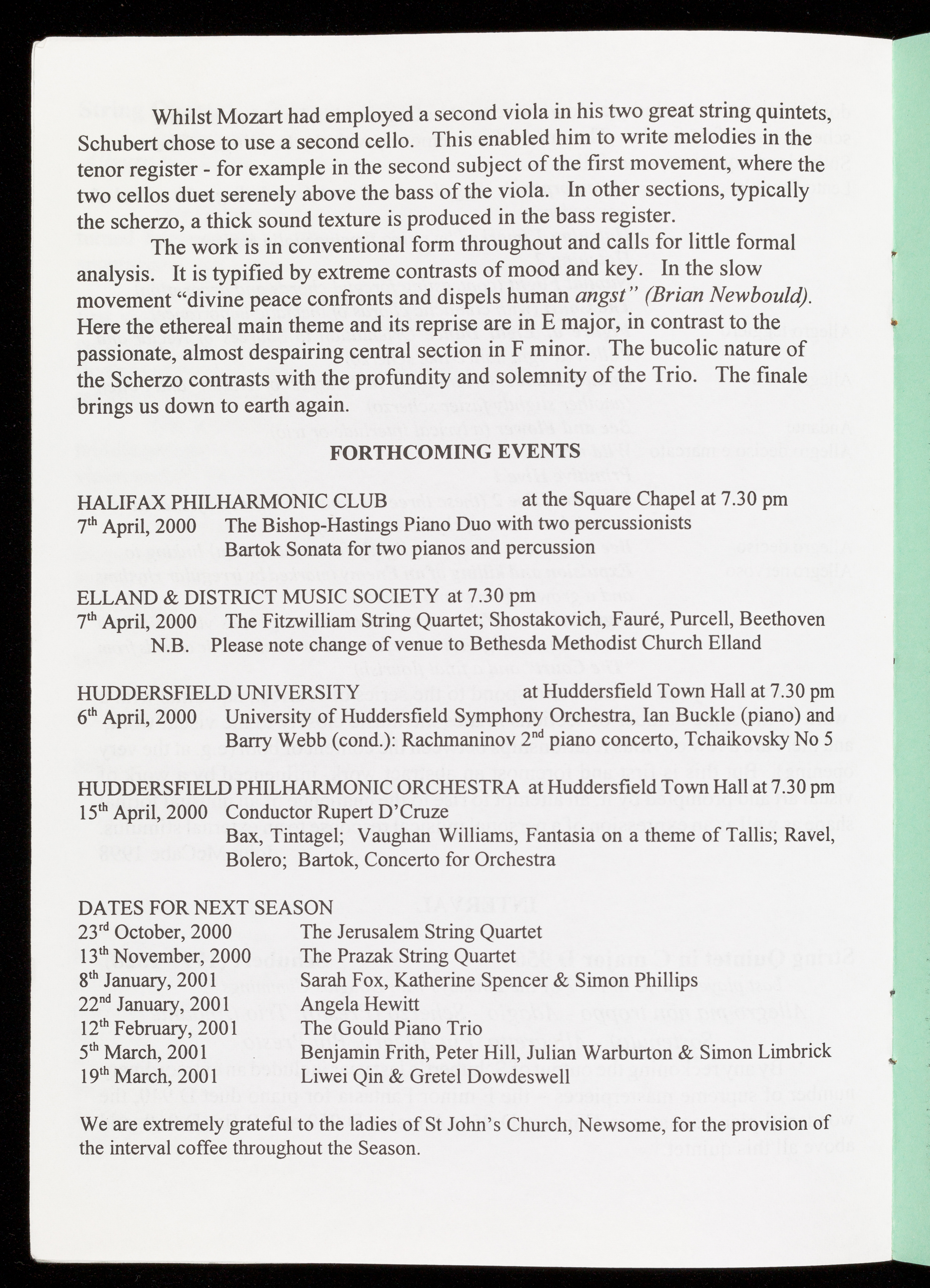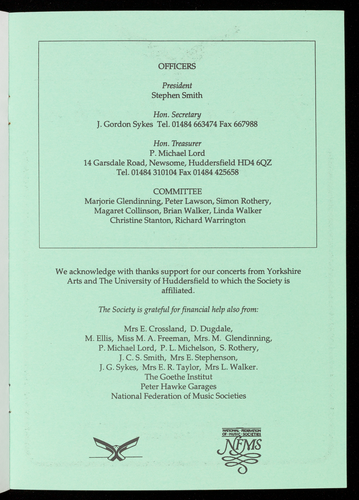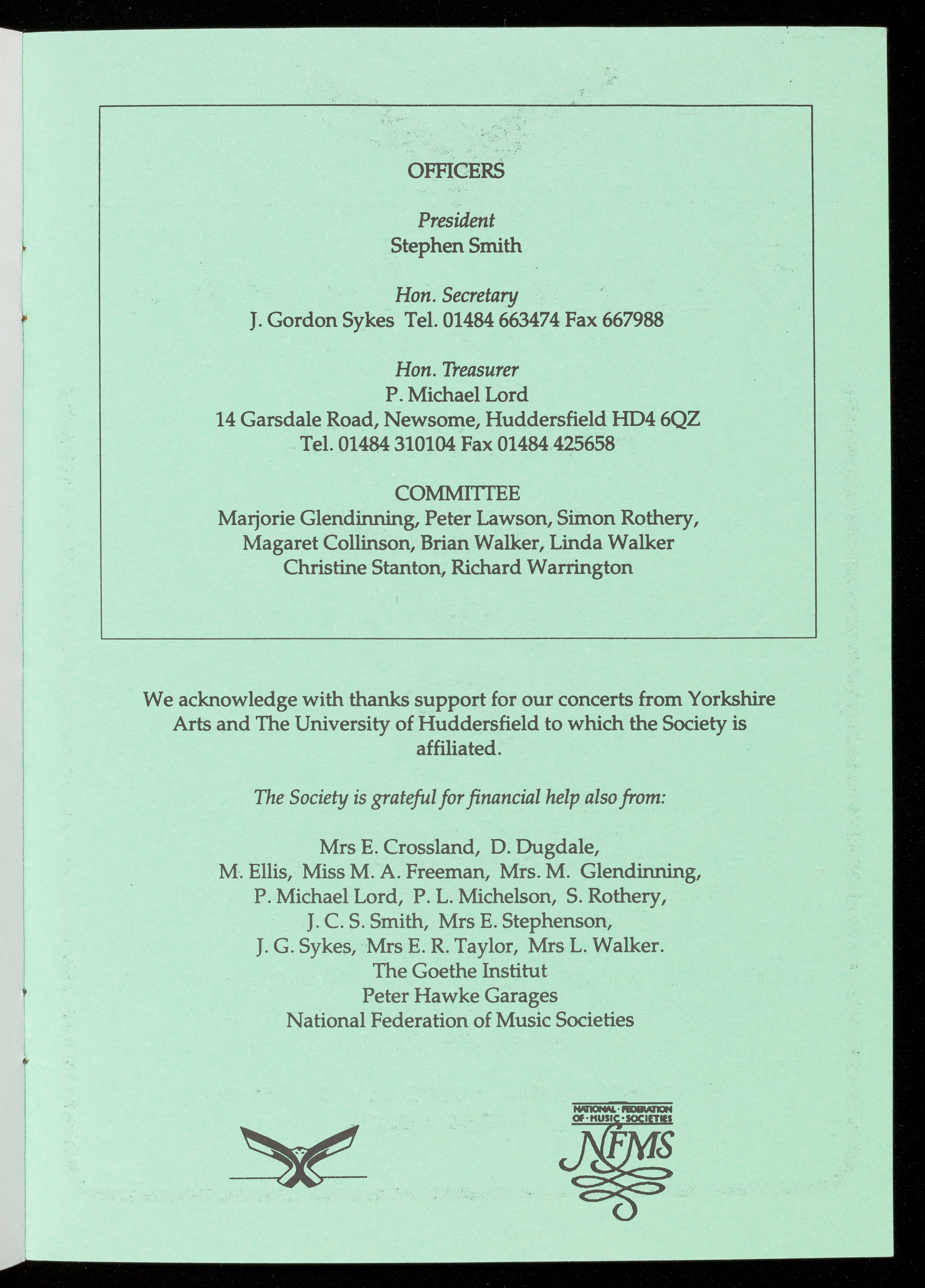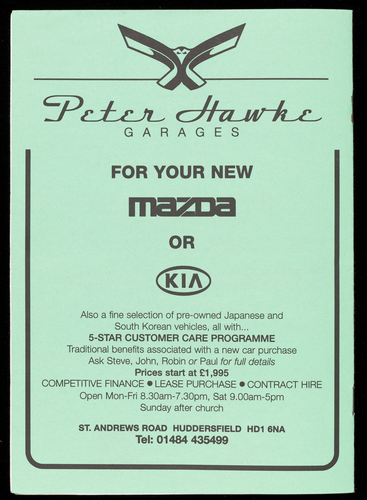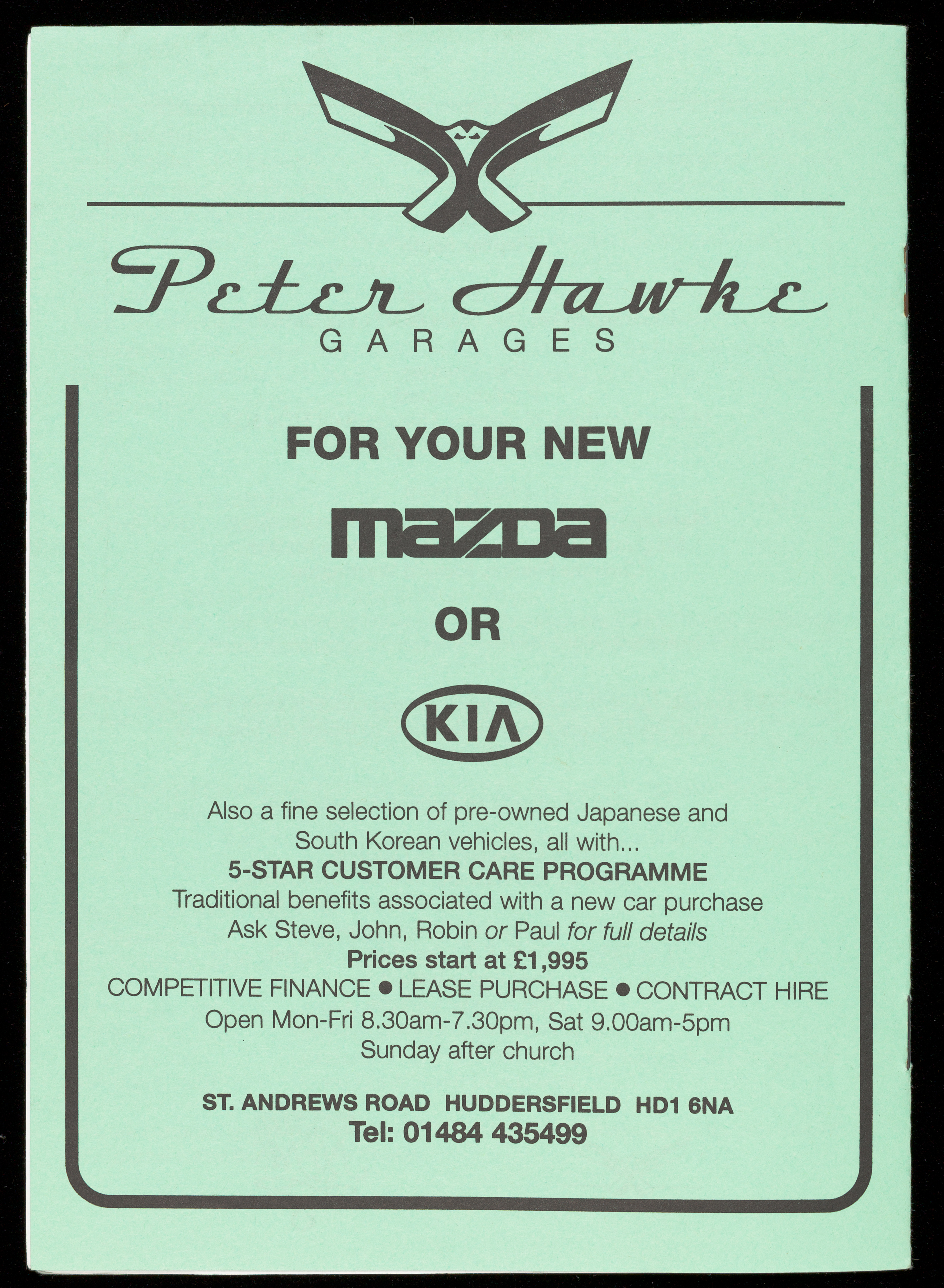Ocr'd Text:
HUDDERSFIELD
MUSIC SOCIETY
President: Stephen Smith
82nd Season
1999 - 2000
Alice Neary
Music at the
University of Huddersfield
Evening Concert Series
Huddersfield Music Society Reg. Charity 529340
Ocr'd Text:
1. Monday 4th October 1999 at 7.30 pm
LEOPOLD STRING TRIO
From early Schubert to one of Mozart's greatest chamber
works this world-class Norwegian/British ensemble
presents an interesting and eclectic programme.
Trio movement in B flat major D471
Trio in G minor
Trio in C major
Divertimento in E flat K563
2. Monday 1st November 1999 at 7.30 pm
ELIZAVETA KOPELMAN -
Schubert
Sibelius
Françaix
Mozart
piano
Born in Moscow, Elizaveta Kopelman completed her
musical studies at the Royal Northern College of Music,
Manchester, and at the Britten-Pears school in Snape, and
was selected for representation by the Young Concert
Artists' Trust.
Andante Favori in F WoO 57
Sonata in F minor Op 57 (Appassionata)
Pictures at an Exhibition
Beethoven
Beethoven
Mussorgsky
Sponsored by Peter Hawke Garages
3. Monday 29th November 1999 at 7.30 pm
TAKACS STRING QUARTET
This distinguished Hungarian Quartet's all Beethoven
programme includes works from the composer's early
opus 18 series, from his middle period and from the last
great series of five string quartets.
Quartet in G major Op 18 No 2
Quartet in E flat Op 74 (The Harp)
Quartet in B flat Op 130
Beethoven
Beethoven
Beethoven
4. Monday 24th January 2000 at 7.30 pm
ALICE NEARY- cello
GRETEL DOWDESWELL
piano
The daughter of the distinguished organist, Alice Neary
made a great impression with her opening recital at the
Wigmore Hall. Gretel Dowdeswell will be familiar to many
of our audience as a former member of the Gould Piano Trio.
photo: Jason Bell
Ocr'd Text:
er
le
rt
IS
ix
rt
er
ic,
nd
ert
en
en
ky
en
rly
ast
en
en
en
ary
the
any
rio.
photo: Jason Bell
Leopold
Trio
Takacs Quartet
Gretel Dowdeswell
963
Trio Fontenay
B
12
Clelia
Vanbrugh Quartet
unznuj
10
C
8803
Kopelman
Elizaveta
photo: Carpenter Turner
Louise Hopkins
photo: Malcolm Crowthers
Ocr'd Text:
ber
mble
Dert
lius
gaix
Zart
her
usic,
and
cert
ven
ven
sky
ľ
ven
arly
last
ven
ven
ven
eary
the
any
Trio.
Shostakovich
Cello sonata in D minor Op 40
Cello Sonata in D minor
A new commission
Debussy
John McCabe
Cello Sonata No 1 in E minor Op 38
Brahms
Sponsored by The Countess of Munster Musical Trust
5. Monday 14th February 2000 at 7.30 pm
ACADEMIA WIND QUINTET
OF PRAGUE
CLELIA IRUZUN - piano
Founded at the Prague Conservatory in 1971, the Quintet
rapidly made a name for itself in its native land and has
since established a world reputation. Born in Rio de
Janeiro, Clelia Iruzun has now made her home in London.
Wind Quintet in F Op 91 No 3 Antonin Reicha (1770-1836)
Quintet in E flat for piano and wind K452
Suite "La Cheminée du Roi René"
Quintet in E flat for piano and wind Op 16
Sponsored by Peter Hawke Garages
Mozart
Milhaud
Beethoven
6. Monday 6th March 2000 at 7.30 pm
TRIO FONTENAY OF
HAMBURG
Founded in 1980, the Fontenay ranks among the leading
piano trios in the world, and has participated in most of
the major European music festivals.
Piano Trio in one movement (1983)
Reinhard Flender
Beethoven
Brahms
Piano Trio in E flat Op 70 No 2
Piano Trio in B major Op 8
This concert is presented in association with the
Goethe Institut
7. Monday 27th March 2000 at 7.30 pm
VANBRUGH STRING
QUARTET
LOUISE HOPKINS - cello
Based in Cork, this Quartet has won an enviable reputation
since winning the London International String Quartet
Competition in 1988. They are joined by the cellist, Louise
Hopkins, for Schubert's sublime quintet.
Quartet in B major Op 64 No 5 (The Lark)
Quartet no 5 (1989)
String Quintet in C major D956
Haydn
John McCabe
Schubert
The Huddersfield Music Society is affiliated to the
University of Huddersfield and our concerts form part
of the "Evening Concert" series. The other concerts in
the series are given by the students and staff of the
School of Music and Humanities and cover a wide
range of musical performance.
Full details are
published in the Department's brochure, "Music at the
University of Huddersfield", obtainable from the
Department of Music at the University (Tel. 472003).
Tickets
Single Season Ticket £40 Double Season Ticket £76
Single Concert
£10 Student Ticket
Student Season Ticket £15
£3
Tickets may be obtained by using the booking form or
from Huddersfield Information Centre, Albion Street, Tel.
223203, or at the door. Please return unwanted season
tickets to the Treasurer by 27th September.
Post this form with cheque payable to Huddersfield
Music Society to the Hon. Treasurer, Mr Michael Lord,
14 Garsdale Road, Newsome, Huddersfield HD4 6QZ
(Tel: 01484 - 310104; Fax 01484- 425658).
&
Please send
Name
Please send .......
number(s)
Address
.....
Postcode
.......... single/double season tickets
I enclose cheque
single concert tickets for concert
Telephone
1
Total £.........
Ocr'd Text:
16
GOETHE
INSTITUT
O
A629
NEW NORTH
TO HALIFAX
& M62
MUSIC SOCIETY
Honorary Secretary:
Mr Gordon Sykes
Tel: 01484 663474 Fax: 01484 667988
HUDDERSFIELD
TRINITY STREET
I
Peter Hawke
Garages
HUDDERSFIELD TOWN CENTRE
TO LEEDS
UL
NORTH
AS
CASTLE GATE
STATION
BUS
A62 MANCHESTER ROAD
TO MANCHESTER
Car parking should
RAILWAY STATION
WT.
NATIONAL FEDERATION
OF MUSIC SOCIETIES
NEMS
A616 CHAPEL HILL
1000
00GOD
୦୦୮
00
000
QUEESINGATE
1
CAR PARK
Yorkshire Arts
QUEESN ST SOUTHO
SOUTHGATE
T
LEEDS ROAD A62
QUEENSGA
be available
St. Paul's Hall for a small fee.
TO WAKEFIELD
& SHEFFIELD
4629 WAKEFIELD ROAD
ST. PAUL'S HALL
UNIVERSITY OF
HUDDERSFIELD
across Queensgate from
The car park is lit and attended.
The concerts usually end at about 9.30 pm.
Ocr'd Text:
HUDDERSFIELD
MUSIC SOCIETY
Registered Charity 529340
President: Stephen Smith
UI
WT.
Eighty-second Season
1999 - 2000
St. Paul's Concert Hall, Queensgate
Mondays at 7.30 pm.
Ocr'd Text:
● PIANOS
● KEYBOARDS
● ORGANS
● DIGITAL PIANOS
TV & AUDIO
CLAVINOVAS
SHEET MUSIC
CLASSICAL CDs & TAPES
Woods
11-15 MARKET STREET, HUDDERSFIELD
01484 427455 THE MUSIC SHOP
MUSICAL INSTRUMENTS
BiG
ON MUSIC & THE ARTS
The Examiner is big on music and the arts, keeping you up-to-date with Huddersfield's
thriving cultural scene in a local entertainments package that's second to none.
IT'S ALL YOU NEED TO KNOW
MAPS AND EANDES
For tralicajc
Hirne and storin
Wi
Examiner
Res Ufo oeng i know
BIG
OCAY
NEWS
.m
M
propony
A₁
Sc
Pi
W
of
Ocr'd Text:
Monday 1st November, 1999
ELIZAVETA KOPELMAN
Piano
Pictures at an Exhibition
PROGRAMME
Andante Favori in F major WoO 75
Sonata in F minor Op 75 57.
INTERVAL
Beethoven
Beethoven
Mussorgsky
We are grateful to Peter Hawke Garages for their generous sponsorship
of this Concert.
Ocr'd Text:
Andante Favori in F WoO 57
Andante
Beethoven (1770-1827)
Composed in 1803, this piece was originally intended to form the slow
movement of the Waldstein Sonata, op 53. Perhaps recognising that it was
far too long to stand between the mighty outer movements of that work,
Beethoven replaced it by the mysterious twenty-eight bar movement which
leads into its finale.
In contrast, the Andante Favori is perfectly capable of standing on its
own, as a complete entity. It is in Rondo form, with a lengthy coda. The
main theme is quite complex, and at one point lurches from F major to D flat
major and back again. It is varied at each return, mainly by means of changes
in the bass part.
The start of the coda is heralded by octaves, and it includes a further
reprise of the main theme.
Sonata in F minor op 57 (Appassionata)
Beethoven
Assai Allegro:
Andante con moto:
Allegro, ma non troppo - Presto.
(Last performed for us in 1983 by Paul Coker)
This work was completed in 1806 and dedicated to Count Franz von
Brunswick. The Count had two sisters, Countess Theresa von Brunswick and
Josephine von Deym. According to Eric Blom, Beethoven was in love with
both these sisters at the time, and he ventures the suggestion that the Count
may have been asked to accept the dedication as proxy for the two of them.
The sonata was awarded its title by the publisher, Cranz. Whether
Beethoven approved of it, history does not record, but it is certainly
appropriate to the tempestuous nature of the two outer movements. Their
restless spirit is typified by the frequent use of the chord of the diminished
seventh, particularly at pivotal points of their form.
Although the opening allegro starts quietly enough, the rhythmic
arpeggio pattern, the following shake and turn, and the figure akin to the
Ocr'd Text:
OW
as
Tk,
ich
its
he
lat
ges
her
on
and
ith
ant
m.
ner
ly
eir
ed
hic
"fate" motif in the Fifth Symphony soon added to it, immediately
establish the restless nature of the whole movement. Although the
second subject starts in the key of A flat major, this does little to dispel
the sombre environment. The initial theme is based on the opening
arpeggio pattern and this soon gives way to a violent passage starting in
A flat minor. The development section is really an elaborate fantasia,
based upon the previous material. Its end is signalled by increasingly
urgent statements of the fate motif, and the recapitulation contains
interesting divergences from the exposition. The coda is extensive, and
often violent. Towards the end the pace is quickened but the closing
arpeggio dies away to a whisper, as if exhausted.
There could hardly be a greater contrast than with the slow
movement. It consists of a single peaceful theme, followed by four
variations. The theme is in two eight-bar sections, each of which is
repeated. In the third variation the repeats are altered. The fourth
variation contains no repeats, and at the end there is no close on to the
tonic. The movement ends ambiguously on a diminished seventh,
which is taken up enthusiastically and rhythmically in the next
movement.
The last movement is thus linked directly to the preceding
Andante. It is in sonata form and has the character of a moto perpetuo,
although characteristically Beethoven does not hesitate to break the
running semiquavers at the end of the development section, when a
broken chord of the diminished seventh slows from semiquavers to
triplets, quavers and finally minims, with which it climbs to the top of
the keyboard and descends to the bass.
The movement contains a number of interesting features. The
composer introduces entirely new themes in the middle of the
development section, and at the beginning of the coda. Although the
exposition section is not repeated, the composer marked a repeat of the
following development and recapitulation.
The coda, marked presto, commences with the new theme, of
two heavy chords followed by rapid staccato passages. The dramatic
tension is thus heightened by the delayed restatement of the main theme,
itself with increased and unexpected harmonic breadth, as the music
rushes headiong to its emphatic ciose.
Ocr'd Text:
A short note on the piano sonatas of Beethoven
Composed between 1793 and 1822, the cycle of piano sonatas surely
represents, as a genre, the most complete account of the development of
Beethoven's style of composition.
From the other F minor sonata, op 2 no.1 to the depths of op 111 we
experience an astonishing world of difference. We have passed from the four
movement form favoured by Mozart and Haydn to a musical entity where form is
subjected to the demands of the material, and to works which may have anything
from two to seven movements, sometimes inter-linked.
Beethoven's arrival in Vienna corresponded roughly with the launch of the
pianoforte, an instrument which combined the percussive qualities of its
predecessors with the possibility of a sustained legato line features which
admirably suited Beethoven's character. It was only late in his life that he
described the piano as unsatisfactory, having stretched it to its limits, and reverted
to the string quartet.
There followed considerable improvement of the piano, in terms of attack,
sonority, sustaining power and reliability, exploited by succeeding composers, such
as Mussorgsky. But these qualities are by no means out of place in the performance
of Beethoven's sonatas, and may indeed approach the ideal which he could not find
in the contemporary instruments.
Modest Mussorgsky (1839-1881)
Promenade - Gnomes - Promenade - The Old Castle - Promenade - The
Tuileries Garden - Byrdlo - Promenade - Ballet of the Chickens in their
Shells - Samuel Goldenberg and Schmule - Promenade - The Market
Place at Limoges - The Catacombs - The Hut on Fowls Legs (Baba Yaga)
The Great Gate of Kiev
Pictures at an Exhibition
These pieces, composed in 1874, reflect the increasing range and
expressiveness of the nineteenth century piano available to composers. Their
subjects are inspired by a memorial exhibition of sketches and watercolours
by Victor Hartman, the deceased friend of Mussorgsky. They depict
everyday scenes, buildings and fabulous but often highly improbable designs.
The folk-inspired promenade with its flexible metric divisions
represents a stroll around the gallery and provides a linking framework to the
set of pieces. With every appearance it changes its mood, often heralding the
next set of images.
The stumbling freakish character of The Gnome is portrayed by
evocative piano gestures and later by the sudden outburst of trills. A more
1
Ocr'd Text:
)
)
)
}
thoughtful promenade leads us into a contrasting movement, The Castle. Its
continuous pedal note, over which a haunting and repetitive Russian melody
is heard, gives a sense of timelessness to the picture. The tranquillity is
broken by a short, but assertive promenade which conducts us to the first of
two pictures: The Tuileries Garden is subtitled "Children in Dispute at
Play" and is characterised by lightness and subtlety. The second of these,
Byrdlo, an impression of oxen and cart trundling by, is a heavy and lumbering
piece, whose left hand piano part is aptly given to the tuba in Ravel's
orchestral transcription.
As it fades into the distance, a lovely and altered version of the
promenade leads the listener into the light and humorous dance of Chickens
in their Shells. A rhetorical unison passage then takes us to an affectionate
portrayal of an eccentric Jewish character, Samuel Goldenberg. A trembling
hesitant passage alternates with unpredictable outbursts in the bass, allowing
the listener to imagine an isolated but very human character.
The Market is heralded by a strong confident promenade in a major
key. The picture itself is full of colour and movement, marked by the
rhythmic piano figures, and use of repeated chords and accents, all making
considerable demands upon the player in terms of stamina and agility.
A controlled chordal passage leads impressively into The Catacombs.
It is a morbid and introspective piece, possibly reflecting Mussorgsky's
preoccupation with death. Incorporated within the picture, a ghostly version
of the promenade theme may be heard in the left hand, beneath chantlike
tremolo passages in the treble. The weird Hut on Fowls' Legs takes on a
threatening character, embodied in torrents of octaves and dissonance. This
gives way briefly to a more expressive passage before leading impressively
into the finale.
The Great Gate of Kiev is not only a mighty portrayal of its subject,
but also a hugely demanding piece of piano writing. Its massive structure is
revealed in huge parallel chords, decorated by impressive bell-like effects, up
and down the keyboard. These are interspersed with quieter, hymn-like
passages; then after a change of rhythm to triplet chords, the music builds up
to a sonorous and arresting climax and ending.
Ocr'd Text:
ELIZAVETA KOPELMAN piano
Born in Moscow in 1974 to a family of musicians, Elizaveta studied at the
Central School of Music in Moscow with Dina Parachina, graduating in 1991.
With the aid of a scholarship she continued her studies with Arnaldo Cohen
at the Royal Northern College of Music where she won numerous prizes and
awards. While at the RNCM she participated in trio masterclasses with
Menahem Pressler at the Britten-Pears School in Snape. In June 1995
Elizaveta was selected for representation by YCAT.
An enormously popular artist, Elizaveta has performed at major venues and
festivals throughout the UK and Europe including critically acclaimed debut
recitals at the Purcell Room (1996) and Wigmore Hall (1998). Festival
engagements have included recitals at Ribchester, Cirencester, Henley,
Chester and Norfolk and Norwich Festivals. In 1997 she gave a live
broadcast for the BBC Radio 3 Pebble Mill series and appeared on Classic
FM.
As a concerto soloist Elizaveta's work has included performances of
Rachmaninov, Shostakovich and Schumann.
Abroad, Elizaveta has given recitals in New York, Moscow, Saratov and
Lvov (Ukraine), appeared at the Flanders Festival in Belgium, and toured
throughout South America as soloist under the auspices of the British
Council.
Within the last twelve months Elizaveta has appeared again at the Wigmore
hall and Purcell Room. She has performed the Bartok Sonata for two pianos
and percussion at the Wigmore Hall, Harewood House and in Belgium.
E
N
E
N
[
M
(
F
-
M
02
Ocr'd Text:
1
d
h
5
d
t
1
,
e
C
f
d
1
n
e
S
FORTHCOMING EVENTS
HUDDERSFIELD MUSIC SOCIETY
Monday 29th November, 1999 at 7.30 pm
TAKACS STRING QUARTET
Beethoven:
Quartet in G major Op 18 No 2
Quartet in E flat Op 74 (The Harp)
Quartet in B flat Op 130
MUSIC AT THE UNIVERSITY OF HUDDERSFIELD
University of Huddersfield Music Department
Monday 8th November, 1999 at 7.30 pm
Chamber Recital by Students.
HALIFAX PHILHARMONIC CLUB
Friday 5th November, 1999 at 7.30 pm in the Square Chapel
Ludwig String Quartet
Mozart K 458; Chausson Op 35; Dutilleux; Ravel.
ELLAND DISTRICT MUSIC SOCIETY
Friday 19th November, 1999 at 7.30 pm
The Galliard Wind Ensemble and Murray McLachlan
Piano and Wind Quintets by Mozart, Beethoven and Rimsky-
Korsakov, Sextet by Poulenc.
HUDDERSFIELD PHILHARMONIC ORCHESTRA
Leland Chen (violin), Rupert D'Cruse
Saturday 13th November 1999, at 7.30 pm in Huddersfield Town Hall
Schubert (Unfinished Symphony), Bruch, Walton (Henry 5th Suite),
Sibelius (7th Symphony)
Ocr'd Text:
DO YOU PAY TAX?
WOULD YOU LIKE TO HELP THE SOCIETY?
If the answer to both these questions is "YES" then why not complete a
Deed of Covenant in favour of the Society, which is a registered charity?
For example, if you decided to give £50-00 a year to the Society for a
minimum of four years (in addition to any ticket money) then the Inland
Revenue would increase this by £14.94.
Have a word with our Treasurer Michael Lord at the Interval, or before the
next Concert. He will be able to complete the necessary paperwork,
which is very simple, and answer any questions.
WE RELY UPON THE FINANCIAL SUPPORT OF OUR
SUBSCRIBERS TO MAINTAIN THE HIGH STANDARDS OF OUR
SEASONS' PROGRAMMES.
Ocr'd Text:
OFFICERS
Hon. Secretary
J. Gordon Sykes Tel. 01484 663474 Fax 667988
President
Stephen Smith
Hon. Treasurer
P. Michael Lord
14 Garsdale Road, Newsome, Huddersfield HD4 6QZ
Tel. 01484 310104 Fax 01484 425658
COMMITTEE
Marjorie Glendinning, Peter Lawson, Simon Rothery,
Magaret Collinson, Brian Walker, Linda Walker
Christine Stanton, Richard Warrington
We acknowledge with thanks support for our concerts from Yorkshire
Arts and The University of Huddersfield to which the Society is
affiliated.
The Society is grateful for financial help also from:
Mrs E. Crossland, D. Dugdale,
M. Ellis, Miss M. A. Freeman, Mrs. M. Glendinning,
P. Michael Lord, P. L. Michelson, S. Rothery,
J. C. S. Smith, Mrs E. Stephenson,
J. G. Sykes, Mrs E. R. Taylor, Mrs L. Walker.
The Goethe Institut
e
Peter Hawke Garages
National Federation of Music Societies
S
NATIONAL FEDERATION
OF MUSIC SOCIETIES
NEMS
Ocr'd Text:
2
Peter Hawke
GARAGES
FOR YOUR NEW
Mazda
OR
ΚΙΛ
Also a fine selection of pre-owned Japanese and
South Korean vehicles, all with...
5-STAR CUSTOMER CARE PROGRAMME
Traditional benefits associated with a new car purchase
Ask Steve, John, Robin or Paul for full details
Prices start at £1,995
COMPETITIVE FINANCE LEASE PURCHASE CONTRACT HIRE
Open Mon-Fri 8.30am-7.30pm, Sat 9.00am-5pm
Sunday after church
ST. ANDREWS ROAD HUDDERSFIELD HD1 6NA
Tel: 01484 435499
Ocr'd Text:
HUDDERSFIELD
MUSIC SOCIETY
Registered Charity 529340
President: Stephen Smith
WT.
Eighty-second Season
1999 - 2000
St. Paul's Concert Hall, Queensgate
Mondays at 7.30 pm.
Ocr'd Text:
PIANOS
● KEYBOARDS
● ORGANS
● DIGITAL PIANOS
● TV & AUDIO
CLAVINOVAS
● SHEET MUSIC
● CLASSICAL CDs & TAPES
Woods
11-15 MARKET STREET, HUDDERSFIELD
01484 427455 THE MUSIC SHOP
● MUSICAL INSTRUMENTS
BiG
ON MUSIC & THE ARTS
The Examiner is big on music and the arts, keeping you up-to-date with Huddersfield's
thriving cultural scene in a local entertainments package that's second to none.
IT'S ALL YOU NEED TO KNOW
MAPS AND EUIDES
for tralica
Hirne und Stri
คน ใน
Examiner
It's goed te know
BIG
LOCAL
NEWS
THA
1900
popondy
Ocr'd Text:
Monday 29th November, 1999
TAKACS STRING QUARTET
Edward Dusinberre(violin)
Gabor Ormai (viola)
Karoly Schranz (violin)
Andras Fejer ('cello)
Programme
Quartet in G Major Op 18 No 2
3 Quartet in E flat major Op 74 (The Harp)
Quartet in B flat major Op 130
Beethoven
Beethoven
Beethoven
The Takacs String Quartet is today recognised as one of the world's
leading string quartets. Formed in 1975, acknowledgement of the
Quartet's talent was quickly recognised with the award of first prizes at
the Evian and Portsmouth International String Quartet Competitions.
The Quartet signed an exclusive recording contract with Decca in 1988,
and has since recorded works by Haydn, Mozart, Brahms, Schubert.
Dvorak, Borodin, Smetana and Chausson. Their recording of the six
Bartok quartets, released in 1998, received the 1998 Gramophone award
for chamber music. Future recording plans include works by Beethoven
and Dvorak.
The Takacs Quartet appears regularly in most major cities and has been
re-invited to many prestigious festivals, including Salzburg, Berlin,
Mostly Mozart and Ravinia. Recent engagements have included
appearances at the Tanglewood Festival in Boston and at the Wigmore
Hall Schubert Gala in January 1997. They have also made video-
recordings of works by Haydn, Mozart, Beethoven and Brahms.
Since 1983 the Quartet has held a Residency at the University of
Colorado, USA, and in 1988 the Takacs Quartet was appointed Visiting
Quartet at the Guildhall School of Music.
The Takacs Quartet's attire is by courtesy of Vestimenta, Milan
Ocr'd Text:
Beethoven (1770-1827)
Allegro: Adagio-Allegro: Scherzo (Allegro): Allegro molto
quasi Presto
(Last performed for us in 1977 by the New Budapest Quartet)
Quartet in G major Op 18 No 2
Beethoven's String Quartets divide conveniently into three, corresponding to his
early, middle and late periods:- the opus 18 set composed between 1799 and 1801; from
opus 59 to opus 95 published between 1808 and 1810, and the late quartets written between
1824 and 1826. We have examples of each within tonight's programme.
Opus 18 no 2 was probably the fifth of the set to be written. On the face of it the
opening movement is in conventional sonata form. The main theme recurs in the
development section in the key of E flat, and it is given with magical effect in the key of E
major at the opening of the recapitulation.
The second movement, in ABA form starts as a concertante movement for the first
violin. In a manner later to be adopted and expanded in the slow movements of the Quartet
opus 132 and the ninth symphony, the central interlude is at a much faster pace. Upon the
return of the Adagio, the concertante element is extended to the 'cello, and later to the entire
quartet group.
The scherzo is full of wit, grace and charm. The last movement, though in sonata
form, contains many elements of the rondo form, since its main theme returns several times.
Quartet in E flat major Op 74 (The Harp)
Poco Adagio - Allegro:
Allegretto con Variazioni
(Last performed for us in 1990 by the Vanbrugh String Quartet)
Beethoven
Presto:
Adagio ma non troppo:
Beethoven was working on his fifth symphony when he completed this quartet in
1809. Both scherzos have the same structural scheme and he also uses the famous "fate"
motif in this scherzo.
The enigmatic nature of the slow introduction is due to Beethoven's avoidance of
the tonic key until we reach the allegro, with its confident statement of E flat major. The
"harp" title becomes clear in the development section, particularly towards its end with the
progression of pizzicato arpeggios through the three lower parts against sustained chords
from the first violin. The ending of the movement is delayed by a surprising static chordal
passage which leads to a re-iteration of the "harp" idea, accompanied by first violin
semiquaver decoration.
In the lyrical second movement, Beethoven makes use of varied and ingenious
accompaniment figures, also exploring the different melodic registers of each instrument.
There is a particularly expressive solo for the high register of the 'cello close to the end.
The scherzo is in C minor. Based upon the "fate"motif, it is propelled
rhythmically, alternating with two, even faster, trio-like sections in the major key.
Memorable is the third and last repeat of the scherzo, which takes an unexpected turn away
from the tonic of C and ends on a restless diminished seventh. This leads directly into the
Ocr'd Text:
2
}
J
final movement. The theme and variations form, at which Beethoven excelled, nevertheless
contains its own surprises, with two faster sections at the end building towards a fiery
unison passage and culminating quietly with the simplest of cadences.
INTERVAL
Quartet in B flat major Op 130
Beethoven
Adagio ma non troppo-Allegro: Presto: Andante con moto,
ma non troppo: Alla danza tedesca (Allegro assai):
Cavatina (Adagio molto espressivo): Finale (Allegro).
(Last performed for us in 1995 by the Cherubini Quartet)
The opening adagio recurs several times during the first movement, although
not at full length. The quaver passage introduced by the cello brings a touch of
chromaticism. In the beginning of the allegro a rhythmic pattern announced by the
second violin culminates in a rising fourth, and this motif assumes great importance in
the development section. The second subject starts in the remote key of G flat major,
the theme starting with a rising sixth which is clearly derived from the second bar of the
opening adagio. These elements and a rising octave are combined in the development
section to furnish a duet between 'cello and first violin, accompanied by a marching
rhythm.
The second movement, a bustling scherzo, is set in B flat minor. There is a
slight allusion to the initial adagio at the beginning of the third movement, before the
viola announces the urbane principal theme of the movement
The theme of the Alla danza tedesca, in G major, may have been inspired by a
folk-song: Beethoven arranged several and drew upon at least one in his sonatas. A
virtuoso variation and comic coda act as foil to the Cavatina.
Beethoven used a title derived from opera for two other great slow movements
the Ariosa from his piano sonata opus 110, and the Arietta from the opus 111 sonata. In
each case the expression was applied to a sublime melody. The theme is interrupted by
a curious passage marked beklemmt (oppressed) in the key of C flat major, but this is
quickly forgotten in the return to the main theme.
-
Beethoven originally intended to complete the work with the movement which
we now know as the Grosse Fuge, published as op 133. It seems probable that this was
a major element in his original conception of the work, which builds up to it. The
Cavatina could be seen as a suitable introduction to it.
It was only subsequent generations, in the heart of the Romantic movement,
who found Beethoven's late quartets "difficult", but they seem to have been appreciated
by his contemporaries. But even the latter jibbed at the length and complexity of the
fugue. Surprisingly, Beethoven was prepared to accede to these opinions, and the
alternative finale, to be performed tonight, is in fact the last movement he composed. It
is a mark of his greatness as a composer that each finale represents a fitting conclusion to
this work.
Ocr'd Text:
FORTHCOMING EVENTS
HUDDERSFIELD MUSIC SOCIETY
Monday 24th January, 2000 at 7.30 pm
Alice Neary ('cello) and Gretel Dowdeswell (Piano)
Cello Sonatas by Shostakovich, Debussy and Brahms (No 1 in E minor)
14th February, 2000
6th March, 2000
27th March, 2000
The Academia Wind Quintet of Prague with
Clelia Iruzun (piano)
Trio Fontenay of Hamburg
Vanbrugh String Quartet with Louise Hopkins
('cello)
HUDDERSFIELD
UNIVERSITY "Evenings at St Paul's"
Monday December 6th, 1999 at 7.30 pm
University of Huddersfield Wind Orchestra and University of
Huddersfield Brass Band.
HALIFAX PHILHARMONIC CLUB (Square Chapel, Halifax).
Friday 10th December, 1999 at 7.30 pm
The Lindsay Quartet
Haydn op 76 No1, Berg op 3, Dvorak op 96 (American).
ELLAND & DISTRICT MUSIC SOCIETY (Church School Hall)
Friday 11th February, 2000 at 7.30 pm
Lucy Jeal (violin) and Julian Milford (piano)
Geminiani, Beethoven (Sonata No 8 in G major), Szymanowski, Wieniawski,
Bartok, Grieg (Sonata in C minor op 45)
HUDDERSFIELD PHILHARMONIC ORCHESTRA
Saturday February 12th, 2000 at 7.30 pm at Huddersfield Town Hall
Ireland, Rachmaninov (Rhapsody on a theme of Paganini), Tchaikowsky (6th
Symphony)
Ocr'd Text:
OFFICERS
President
Stephen Smith
Hon. Secretary
J. Gordon Sykes Tel. 01484 663474 Fax 667988
Hon. Treasurer
P. Michael Lord
14 Garsdale Road, Newsome, Huddersfield HD4 6QZ
Tel. 01484 310104 Fax 01484 425658
COMMITTEE
Marjorie Glendinning, Peter Lawson, Simon Rothery,
Magaret Collinson, Brian Walker, Linda Walker
Christine Stanton, Richard Warrington
We acknowledge with thanks support for our concerts from Yorkshire
Arts and The University of Huddersfield to which the Society is
affiliated.
The Society is grateful for financial help also from:
Mrs E. Crossland, D. Dugdale,
M. Ellis, Miss M. A. Freeman, Mrs. M. Glendinning,
P. Michael Lord, P. L. Michelson, S. Rothery,
J. C. S. Smith, Mrs E. Stephenson,
J. G. Sykes, Mrs E. R. Taylor, Mrs L. Walker.
The Goethe Institut
Peter Hawke Garages
National Federation of Music Societies
NATIONAL FEDERATION
OF MUSIC SOCIETIES
NEMS
●
Ocr'd Text:
3
Peter Hawke
GARAGES
FOR YOUR NEW
Mazda
OR
ΚΙΛ
Also a fine selection of pre-owned Japanese and
South Korean vehicles, all with...
5-STAR CUSTOMER CARE PROGRAMME
Traditional benefits associated with a new car purchase
Ask Steve, John, Robin or Paul for full details
Prices start at £1,995
COMPETITIVE FINANCE LEASE PURCHASE CONTRACT HIRE
Open Mon-Fri 8.30am-7.30pm, Sat 9.00am-5pm
Sunday after church
ST. ANDREWS ROAD HUDDERSFIELD HD1 6NA
Tel: 01484 435499
Ocr'd Text:
HUDDERSFIELD
MUSIC SOCIETY
Registered Charity 529340
President: Stephen Smith
UT
WT.
Eighty-second Season
1999 - 2000
St. Paul's Concert Hall, Queensga
Mondays at 7.30 pm.
Ocr'd Text:
● PIANOS
● KEYBOARDS
● ORGANS
● DIGITAL PIANOS
● TV & AUDIO
● CLAVINOVAS
SHEET MUSIC
● CLASSICAL CDs & TAPES
Woods
11-15 MARKET STREET, HUDDERSFIELD
01484 427455 THE MUSIC SHOP
● MUSICAL INSTRUMENTS
BiG
ON MUSIC & THE ARTS
The Examiner is big on music and the arts, keeping you up-to-date with Huddersfield's
thriving cultural scene in a local entertainments package that's second to none.
IT'S ALL YOU NEED TO KNOW
MAPS AND EUIDES
For Hiday
Hane und ei
ning t
The HuddenfickDaily
Examiner
It's goed te know
BIG
LOCAL
NEWS
A
Ocr'd Text:
1
Monday 14th February,2000
THE ACADEMIA WIND QUINTET OF PRAGUE
Jiři Maršálek Flute Otto Trnka Oboe Petr Doňek Clarinet
František Pok French Horn
Josef Janda Bassoon
Programme
(1
CLELIA IRUZUN Piano
Wind Quintet in F (1811)
Quintet in E flat k 452
La cheminée du Roi René
Quintet in E flat op 16
Reicha
Mozart
Milhaud
Beethoven
The Academia Wind Quintet of Prague was founded at the Prague Conservatory
in 1971. It soon made a name for itself, winning a prize in the Performing Arts
contest of Chamber Ensembles organised by the Czech Ministry of Culture and at
the same time the Czech Music Foundation prize. Since then it has established a
world-wide reputation, and has been well received in many countries throughout
four continents.
The ensemble has given numerous recitals on radio and television in various
countries They have made recordings for Czech, British, Spanish and Japanese
companies, and have been awarded several significant prizes for their recordings of
the works of Antonin Reicha.
Clelia Iruzun was born in Rio de Janeiro, and it was evident from an early age that
she was destined for a career as a concert pianist. Her early years in Brazil, where
she studied at the School of Music of the Federal University in Rio culminated in
several prizes and major Brazilian composers dedicating works to her.
At the age of seventeen Clelia came to Europe where she studied with Maria Curco,
Merces de Silva, Noretta Conci and Christopher Elton. In addition she received
invaluable guidance from Nelson Freire, Stephen Bishop-Kovacevich and Fou
Ts’Ong.
Clelia has performed widely in the UK and abroad.
We are grateful to Peter Hawke Garages for their generous sponsorship of this
concert.
Ocr'd Text:
Wind Quintet in F (1811)
Antonin Reicha (1770-1836)
Adagio-Allegro moderato: Andante: Minuetto, Allegro: Allegretto:
Born in Prague, Reicha was a distinguished composer and musicologist.
From 1785 he was a flautist in the orchestra in Bonn in which his exact
contemporary, Beethoven, played the viola, and the friendship between the two of
them continued when Reicha emigrated to Vienna in 1801. He subsequently moved
to Paris, where several of his comic operas were produced. He became professor
of counterpoint and fugue at the Conservatoire, and played a considerable part in the
development of French music, as his pupils included Gounod, Berlioz and César
Franck. He also taught Liszt.
His musical output included about two dozen wind quintets, whose
character is marked by geniality and charm.
Quintet in E flat for piano and wind K452
Mozart (1756-1791)
Largo-Allegro moderato: Larghetto: Allegretto
YOUR VIC This work was completed in 1784, when Mozart had written his first sixteen
piano concertos. It exemplifies his brilliance in balancing the fortepiano against the
orchestra, although in this quintet the keyboard is perhaps more of a partner than
a protagonist to the other players.
The wonderfully eloquent slow introduction is introduced by the piano and
swiftly taken up by the other instruments in skilful counterpoint. The following
allegro section has two subjects, of which the first is lyrical and the second more
interesting rhythmically. Both are treated with typical spontaneity of invention,
exhibiting endless variety of partnerships. In the recapitulation, which is reached
after several false starts, the themes are rearranged.
In the second movement the wind players converse melodically in different
groupings against a piano part of broken chords and arpeggios. It has a central
section of contrasting material which visits more remote keys before returning to the
restrained emotion of the opening.
A simple rondo theme, later to be re-scored in its different appearances, is
presented first by the piano, next by the wind instruments, and then by the entire
ensemble. The independence and equality of the wind instruments is always
apparent and exploitation of their individual timbres is of prime importance. Two
contrasting episodes appear between repeats of the rondo theme, of which the
second is altogether of a more sombre nature, led by the darker colours of the horn
and bassoon. A dramatic build-up to a highly unusual and original cadenza
precedes the final theme and coda section.
1
INTERVAL
Ocr'd Text:
ct
of
d
r
e
e
n
e
n
d
g
re
1,
d
ht
al
e
is
re
S
0
e
n
ca
2
}
La Cheminée du Roi René op 205
Milhaud (1892-1974)
Cortege: Aubade: Jongleurs: La Maousinglade: Joutes sur l'Arc
Chasse à Valebré: Madrigal - Nocturno
An expert
Although an invalid, Milhaud led a long and prolific life.
violinist, violist and pianist, he composed music in a variety of genres. He was a
member of the group of French composers known as Les Six.
In 1939 he wrote the music for part of the Raymond Barnard film Cavalcade
d'Amour, choosing the section located in the year 1430. Two months after the
completion of this film he composed the suite La Cheminée du Roi René, based
upon themes derived from the film. The titles of the various movements refer to the
scenes in the film in which those themes were used.
The name of the work refers to the most famous of the troubadour courts
(courts of love), which belonged to René d'Anjou, Compte de Provence, popularly
referred to as le Roi René. The court was near Aix-en-Provence, and a favourite
glade of the troubadours still exists as a well-known picnic spot. The titles of the
movements are largely self-explanatory. Les Jongleurs were wandering minstrels.
La Maousinglade (the badly arranged) was the name of a district near Aix-en-
Provence, jouter is to joust and l'Arc is the name of a local river.
Quintet in E flat for Piano and Wind op 16
Grave-Allegro non troppo: Andante cantabile:
1408
Beethoven (1770-1827)
Rondo, Allegro non troppo
Composed in 1796, twelve years after Mozart's piano quintet, it is not
surprising to find that Beethoven admired that work greatly, and used it as a model.
Interestingly, both works were originally published for strings and piano, wind
players commanding less respect at that time. Fortunately the rights of the original
wind versions were re-established as undoubtedly both works would have been a
great loss from the repertoire of wind players.
The heraldic opening introduces a longer and more rhetorical slow section
than Mozart's, leading to the principal Allegro theme on the piano, taken up with
contrapuntal ease by the clarinet and bassoon. The second subject contains similar
pairings, and a fiery codetta leads to a dramatic development of the themes from the
exposition, involving dazzling triplet scale passages and the sforzando accents
which typify much of Beethoven's writing. However, unpredictably as usual, there
is also surprisingly delicate writing for the woodwind in this section, and canonic
effects are very much in evidence throughout. A stormy passage after a dominant
seventh chord leads to an assertive ending.
A theme of simple dignity first played by the piano opens the second
movement and returns twice more in different guises. This contrasts with darker
minor interludes, particularly featuring a very expressive horn part.
Ocr'd Text:
The last movement is a mixture - the assured Beethoven as in the rollicking
hunting-type theme, and two episodes of a more expressive nature. There is plenty
of piano display and the rapport between the instruments is easily detected through
the interplay of ideas
FORTHCOMING EVENTS
HUDDERSFIELD MUSIC SOCIETY
6th March, 2000
27th March, 2000
Trio Fontenay of Hamburg
Piano Trio in one movement, Flender: Piano Trio in E flat op 70 No 2,
Beethoven: Piano trio in B major op 8, Brahms.
at St Paul's Hall at 7.30 pm
Vanbrugh String Quartet with Louise Hopkins
('cello)
Haydn (the Lark), John McCabe and Schubert Quintet in C
N.B. Tickets for next Season will be on sale after each of the above concerts.
HALIFAX PHILHARMONIC CLUB
18th February, 2000
at the Square Chapel at 7.30 pm
Evelyn Tubb (soprano) and Michael Fields (harp, lute, and
guitar)
ELLAND & DISTRICT MUSIC SOCIETY
at 7.30 pm
7th April 2000 The Fitzwilliam String Quartet; Shostakovich, Fauré, Purcell,
Beethoven
N.B,
Please note change of venue to Bethesda Methodist Church Elland
HUDDERSFIELD UNIVERSITY
17th February 2000
21st February 2000
at St Paul's Hall at 7.30 pm
University Symphony Orchestra
Chamber recital
Ocr'd Text:
There is plat
detected throug
7.30pm
at op 70 No
ins
ove concert
harp, lute, and
ure, Purcell
urch Elland
30 pm
OFFICERS
President
Stephen Smith
Hon. Secretary
J. Gordon Sykes Tel. 01484 663474 Fax 667988
Hon. Treasurer
P. Michael Lord
14 Garsdale Road, Newsome, Huddersfield HD4 6QZ
Tel. 01484 310104 Fax 01484 425658
COMMITTEE
Marjorie Glendinning, Peter Lawson, Simon Rothery,
Magaret Collinson, Brian Walker, Linda Walker
Christine Stanton, Richard Warrington
We acknowledge with thanks support for our concerts from Yorkshire
Arts and The University of Huddersfield to which the Society is
affiliated.
The Society is grateful for financial help also from:
Mrs E. Crossland, D. Dugdale,
M. Ellis, Miss M. A. Freeman, Mrs. M. Glendinning,
P. Michael Lord, P. L. Michelson, S. Rothery,
J. C. S. Smith, Mrs E. Stephenson,
J. G. Sykes, Mrs E. R. Taylor, Mrs L. Walker.
The Goethe Institut
X
Peter Hawke Garages
National Federation of Music Societies
NATIONAL FEDERATION
OF MUSIC SOCIETIES
NEMS
Ocr'd Text:
K
Peter Hawke
GARAGES
FOR YOUR NEW
Mazda
OR
ΚΙΛ
Also a fine selection of pre-owned Japanese and
South Korean vehicles, all with...
5-STAR CUSTOMER CARE PROGRAMME
Traditional benefits associated with a new car purchase
Ask Steve, John, Robin or Paul for full details
Prices start at £1,995
COMPETITIVE FINANCE LEASE PURCHASE CONTRACT HIRE
Open Mon-Fri 8.30am-7.30pm, Sat 9.00am-5pm
Sunday after church
ST. ANDREWS ROAD HUDDERSFIELD HD1 6NA
Tel: 01484 435499
Ocr'd Text:
HUDDERSFIELD
MUSIC SOCIETY
Registered Charity 529340
President: Stephen Smith
WT.
Eighty-second Season
1999-2000
St. Paul's Concert Hall, Queensgate
Mondays at 7.30 pm.
Ocr'd Text:
● PIANOS
● KEYBOARDS
● ORGANS
DIGITAL PIANOS
● TV & AUDIO
● CLAVINOVAS
● SHEET MUSIC
● CLASSICAL CDs & TAPES
Woods
11-15 MARKET STREET, HUDDERSFIELD
01484 427455 THE MUSIC SHOP
● MUSICAL INSTRUMENTS
BiG
ON MUSIC & THE ARTS
The Examiner is big on music and the arts, keeping you up-to-date with Huddersfield's
thriving cultural scene in a local entertainments package that's second to none.
IT'S ALL YOU NEED TO KNOW
AND CANDLE
for Holiday
w ARME
Hipne od d
The Huddersfield Daily
Examiner
It's a goed is know
BIG
NEWS
pr
Ocr'd Text:
Gregory Ellis
Simon Aspel
Monday 27th March, 2000
THE VANBRUGH QUARTET
Violin
Viola
Keith Pascoe Violin
Christopher Marwood Cello
with
Louise Hopkins Cello
String Quartet in D major Op 64 No 5 (The Lark) Haydn
String Quartet No 5
John McCabe
Schubert
String Quintet in C major D 956
Now in its fourteenth year, the Vanbrugh Quartet is firmly established as one of
Europe's most successful quartets. Since winning the London International String Quartet
Competition in 1988 they have built a thriving career, giving about one hundred concerts
internationally each season. The Quartet is based in Cork, in Ireland, where they hold the
position of Resident Quartet to RTE, the national broadcasting service; they are also artists
in residence at University College, Cork.
The Vanbrugh Quartet has released seventeen CDs. Besides the mainstream classics
these include the three quartets by John McCabe, and also works by contemporary Irish
composers.
In 1996, the Quartet founded the West Cork Chamber Music Festival, based at the
spectacular location of Bantry House. This Festival has quickly established itself as a major
event in the European musical calendar.
The members of the Vanbrugh Quartet play on a fine set of instruments on loan from
collections at the Royal Academy of Music and the Maggini Foundation, Switzerland.
Louise Hopkins has performed extensively throughout Britain and abroad. As soloist
she made her American debut in 1995 for the Dame Myra Hess Memorial Concert series, and
her Paris debut in 1996 at the Theatre de la Ville. She has been invited to perform at the Bath,
Harrogate, Brighton and Cardiff Festivals, and appears regularly on BBC Radio 3.
As a chamber musician she has performed at many festivals throughout Britain and
Europe, including Cheltenham and Aldeburgh. She has played with the Takacs String Quartet,
and with Andras Schiff and Norbert Brainin.
Ocr'd Text:
String Quartet in D major Op 64 No 5 (The Lark) Haydn (1732-1809)
Last played for us in 1992 by the Eder Quartet.
Allegro moderato - Adagio Cantabile - Menuetto (Allegro) - Finale (Vivace)
This Quartet is one of six dedicated to Johann Tost, ex-colleague of Haydn
turned businessman. Tost played in the Esterhazy Orchestra and clearly the
spontaneous and creative violin part was written for him to play.
The justification for the nickname Lark becomes apparent from the soaring
first violin entry in the fifth bar. The first movement is in sonata form and has a
curious second subject of gently syncopated chords, quite unlike the neat dotted
rhythms of the first. There follows skilful development, visiting remote keys before
returning to the recapitulation, in which the themes are presented in different order.
The second movement is in ternary form with major sections framing a short
middle passage in the minor key. Its opening features a searching and rather wistful
violin melody which returns in a richly decorated and complicated form in the third
section.
A self-assured minuet, characterised by its acciaccaturas in the opening
theme, offers more opportunities for the kind of contrapuntal textures we expect from
Haydn. It is balanced by a trio in the minor key, once again allowing the three lower
instruments some interplay.
Lastly the finale sets off in the style of a perpetuum mobile, scarcely allowing
time for the listener - let alone the players to catch breath. Fugato treatment of a
second theme allows each player to join in the main subject against a spiky,
syncopated counter-subject. The ending is achieved with considerable panache.
-
String Quartet No 5 (1989)
John McCabe (b. 1939)
First performance at these concerts
Lento flesibile - Allegro leggiero - Allegro vivo - Andante - Allegretto
deciso e marcato - Allegro deciso - Allegro nervoso - Lento pesante -
Allegro vivace
This work was commissioned by the 1989 Fishguard Festival with funds
provided by the Welsh Arts Council and first performed by the Gabrieli Quartet.
It stems from an earlier visit to the Festival during which I visited Picton Castle
and saw the Graham Sutherland exhibit there. His series of Aquatints The Bees
made a strong impression and the resolve of writing a string quartet derived from
this influence was an immediate response. There are fourteen aquatints in the
series, and the quartet divides into fourteen sections. However in several cases
these sections run into one another without a break and form larger units
approximating to the movements of a conventional quartet structure. Thus the
work has roughly the overall shape of a substantial slow movement, followed by a
}
doul
sche
Suth
Lent
Alle
Alle
And
Alle
Alle
Alle
WO
and
оре:
visu
shap
Stri
num
won
abo
Ocr'd Text:
')
)
n
e
g
a
d
e
1
d
g
5
1
)
)
()
)
double scherzo, interlude (a slow movement acting as a kind of trio), another
scherzo and a fast finale. The order of movements, with the headings of the
Sutherland aquatints, is as follows:-
Lento flesibile
Metamorphosis Egg, Larvae, Pupae (concluding with a kind of
free cadenza)
Allegro leggiero
Allegro vivo
Hatching 1 (marked by rising flowing violin scales)
Hatching 2
Nuptial Flight (contrasting forceful chords and decoration)
The Court (with climactic chords of thematic importance)
Allegro deciso
Allegro nervoso
Figure of Eight Dance Orientation to Sources of Nectar and
Pollen (a light dance-like scherzo)
Round Dance Orientation to Sources of Nectar and Pollen
(another slightly faster scherzo)
Bee and Flower (a lyrical interlude or trio)
Andante
Allegro deciso e marcato Wild nest
Primitive Hive 1
Primitive Hive 2 (these three sections are marked by shared
material and strong rhythmic content)
Bee keeper (an obsessive slightly faster movement) linking to
Expulsion and killing of an Enemy (marked by irregular rhythms
and a growth from piano to forte)
Fight between Workers and Drones (a vigorous virtuosic final
movement, ending with two references to the climactic chords from
"The Court" and a final flourish)
Inevitably the decision to respond to the series of fourteen aquatints with a
work of the same number of sections relates the music closely to the visual work,
and there are a few obvious relationships between the content of both (e.g. at the very
opening). But this is first and foremost an abstract work, influenced by a work of
visual art and prompted by it, an attempt to rise to the challenge of an unusual formal
shape as well as an expression of a personal musical response to an external stimulus.
John McCabe 1998
INTERVAL
String Quintet in C major D 956
Schubert (1797-1828)
Last played for us in 1977 by the Lindsays with Douglas Cummings
Allegro ma non troppo - Adagio - Scherzo (Presto), Trio (Andante
Sostenuto) - Allegretto, Piu Allegro, Piu Presto
By any reckoning the output of Schubert's last year included an extraordinary
number of supreme masterpieces - the F minor Fantasia for piano duet D 940, the
wonderful piano sonatas in C minor D 958, A major D 959 and B flat D 960, and
above all this quintet.
Ocr'd Text:
Whilst Mozart had employed a second viola in his two great string quintets,
Schubert chose to use a second cello. This enabled him to write melodies in the
tenor register - for example in the second subject of the first movement, where the
two cellos duet serenely above the bass of the viola. In other sections, typically
the scherzo, a thick sound texture is produced in the bass register.
The work is in conventional form throughout and calls for little formal
analysis. It is typified by extreme contrasts of mood and key. In the slow
movement "divine peace confronts and dispels human angst" (Brian Newbould).
Here the ethereal main theme and its reprise are in E major, in contrast to the
passionate, almost despairing central section in F minor. The bucolic nature of
the Scherzo contrasts with the profundity and solemnity of the Trio. The finale
brings us down to earth again.
FORTHCOMING EVENTS
HALIFAX PHILHARMONIC CLUB
at the Square Chapel at 7.30 pm
7th April, 2000 The Bishop-Hastings Piano Duo with two percussionists
Bartok Sonata for two pianos and percussion
ELLAND & DISTRICT MUSIC SOCIETY at 7.30 pm
7th April, 2000 The Fitzwilliam String Quartet; Shostakovich, Fauré, Purcell, Beethoven
N.B. Please note change of venue to Bethesda Methodist Church Elland
HUDDERSFIELD UNIVERSITY
at Huddersfield Town Hall at 7.30 pm
6th April, 2000 University of Huddersfield Symphony Orchestra, Ian Buckle (piano) and
Barry Webb (cond.): Rachmaninov 2nd piano concerto, Tchaikovsky No 5
HUDDERSFIELD PHILHARMONIC ORCHESTRA at Huddersfield Town Hall at 7.30 pm
15th April, 2000 Conductor Rupert D'Cruze
Bax, Tintagel; Vaughan Williams, Fantasia on a theme of Tallis; Ravel,
Bolero; Bartok, Concerto for Orchestra
DATES FOR NEXT SEASON
23rd October, 2000
13th November, 2000
8th January, 2001
22nd January, 2001
12th February, 2001
5th March, 2001
19th March, 2001
The Jerusalem String Quartet
The Prazak String Quartet
Sarah Fox, Katherine Spencer & Simon Phillips
Angela Hewitt
The Gould Piano Trio
Benjamin Frith, Peter Hill, Julian Warburton & Simon Limbrick
Liwei Qin & Gretel Dowdeswell
We are extremely grateful to the ladies of St John's Church, Newsome, for the provision of
the interval coffee throughout the Season.
Ocr'd Text:
OFFICERS
President
Stephen Smith
Hon. Secretary
J. Gordon Sykes Tel. 01484 663474 Fax 667988
Hon. Treasurer
P. Michael Lord
14 Garsdale Road, Newsome, Huddersfield HD4 6QZ
Tel. 01484 310104 Fax 01484 425658
COMMITTEE
Marjorie Glendinning, Peter Lawson, Simon Rothery,
Magaret Collinson, Brian Walker, Linda Walker
Christine Stanton, Richard Warrington
We acknowledge with thanks support for our concerts from Yorkshire
Arts and The University of Huddersfield to which the Society is
affiliated.
X
The Society is grateful for financial help also from:
Mrs E. Crossland, D. Dugdale,
M. Ellis, Miss M. A. Freeman, Mrs. M. Glendinning,
P. Michael Lord, P. L. Michelson, S. Rothery,
J. C. S. Smith, Mrs E. Stephenson,
J. G. Sykes, Mrs E. R. Taylor, Mrs L. Walker.
The Goethe Institut
Peter Hawke Garages
National Federation of Music Societies
NATIONAL FEDERATION
OF MUSIC SOCIETIES
NEMS
3
•
Ocr'd Text:
f
Peter Hawhe
GARAGES
FOR YOUR NEW
Mazda
OR
ΚΙΛ
Also a fine selection of pre-owned Japanese and
South Korean vehicles, all with...
5-STAR CUSTOMER CARE PROGRAMME
Traditional benefits associated with a new car purchase
Ask Steve, John, Robin or Paul for full details
Prices start at £1,995
COMPETITIVE FINANCE LEASE PURCHASE CONTRACT HIRE
Open Mon-Fri 8.30am-7.30pm, Sat 9.00am-5pm
Sunday after church
ST. ANDREWS ROAD HUDDERSFIELD HD1 6NA
Tel: 01484 435499















































 loading...
loading...